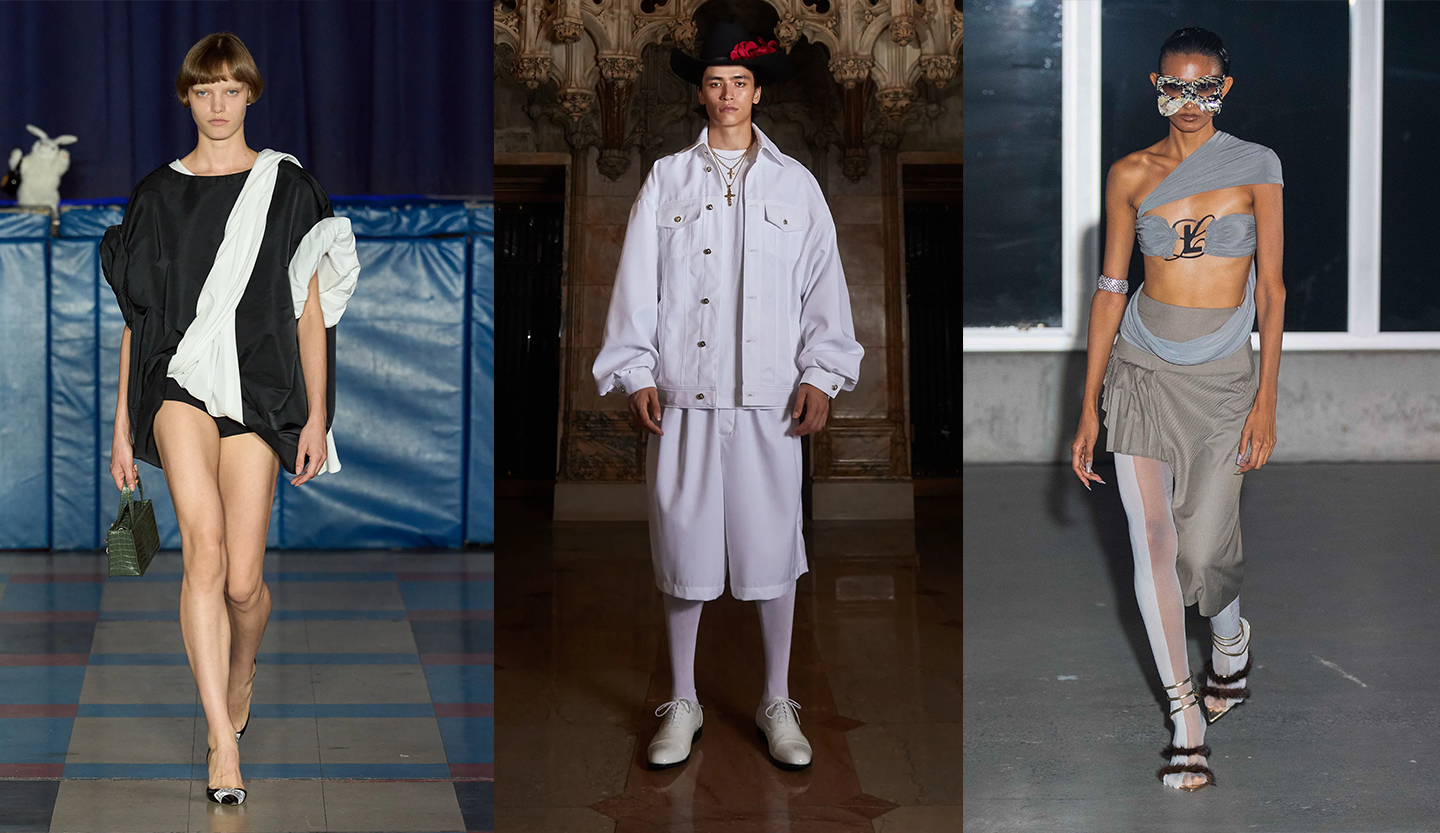Fashion fans, if you’re reading this — you know what time it is! It’s New York Fashion Week, and this season it’s hot, hot, HOT! And no, we’re not just talking about the scorching temps, but this season’s stellar SS24 lineup! There’s loads to look forward to from Peter Do’s debut at Helmut Lang to Ralph Lauren’s return to New York, and of course, all of our favourite designers, including Proenza Schouler, Eckhaus Latta, Willy Chavarria, Luar, and more will be hitting the runways. Ah, New York! The city that never sleeps — count us among them, this week, especially — but don’t worry, we’ll be documenting all the must-see moments from NYFW’s SS24 shows, so all you need to do is check in here for the latest. See you on the other side xoxo

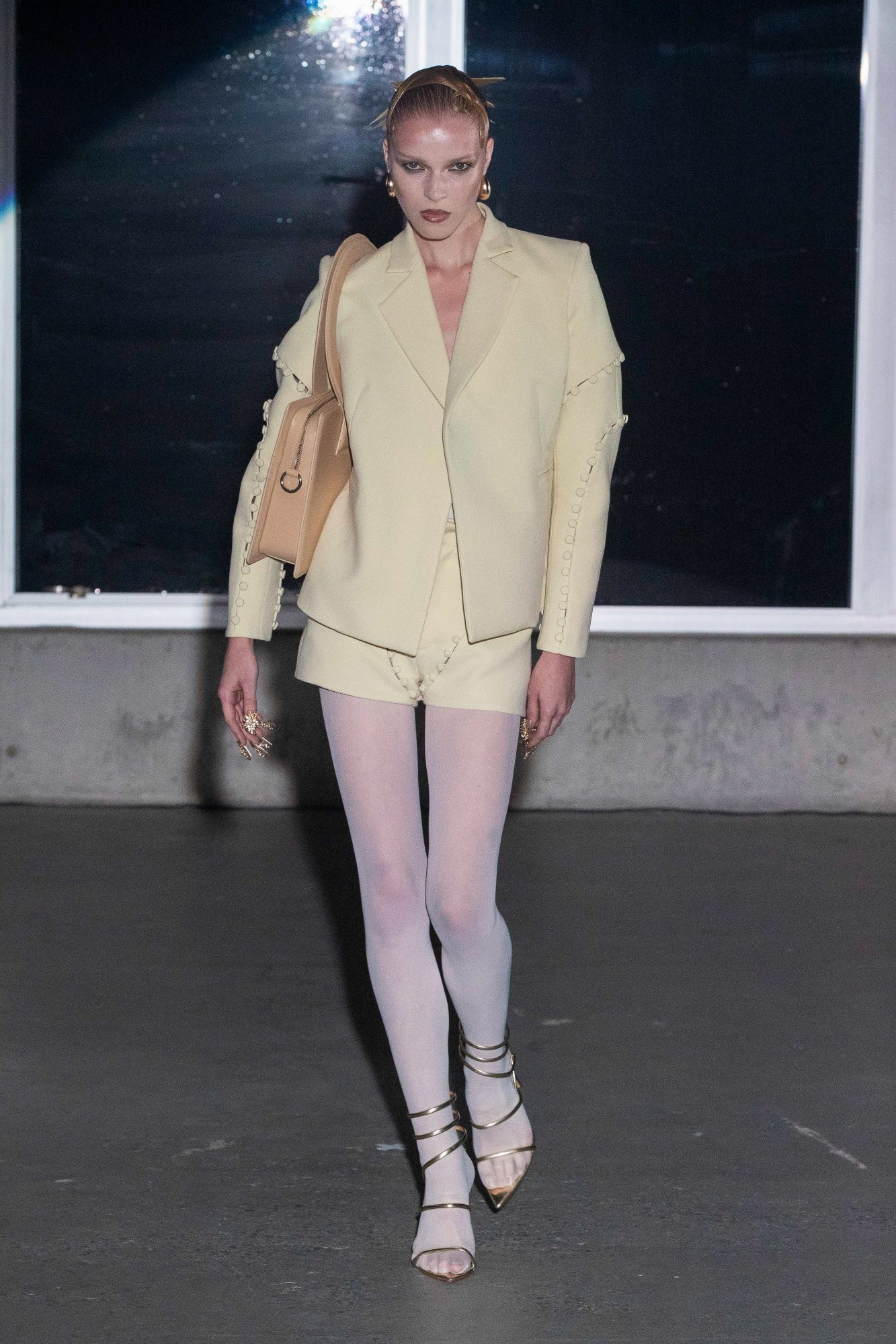
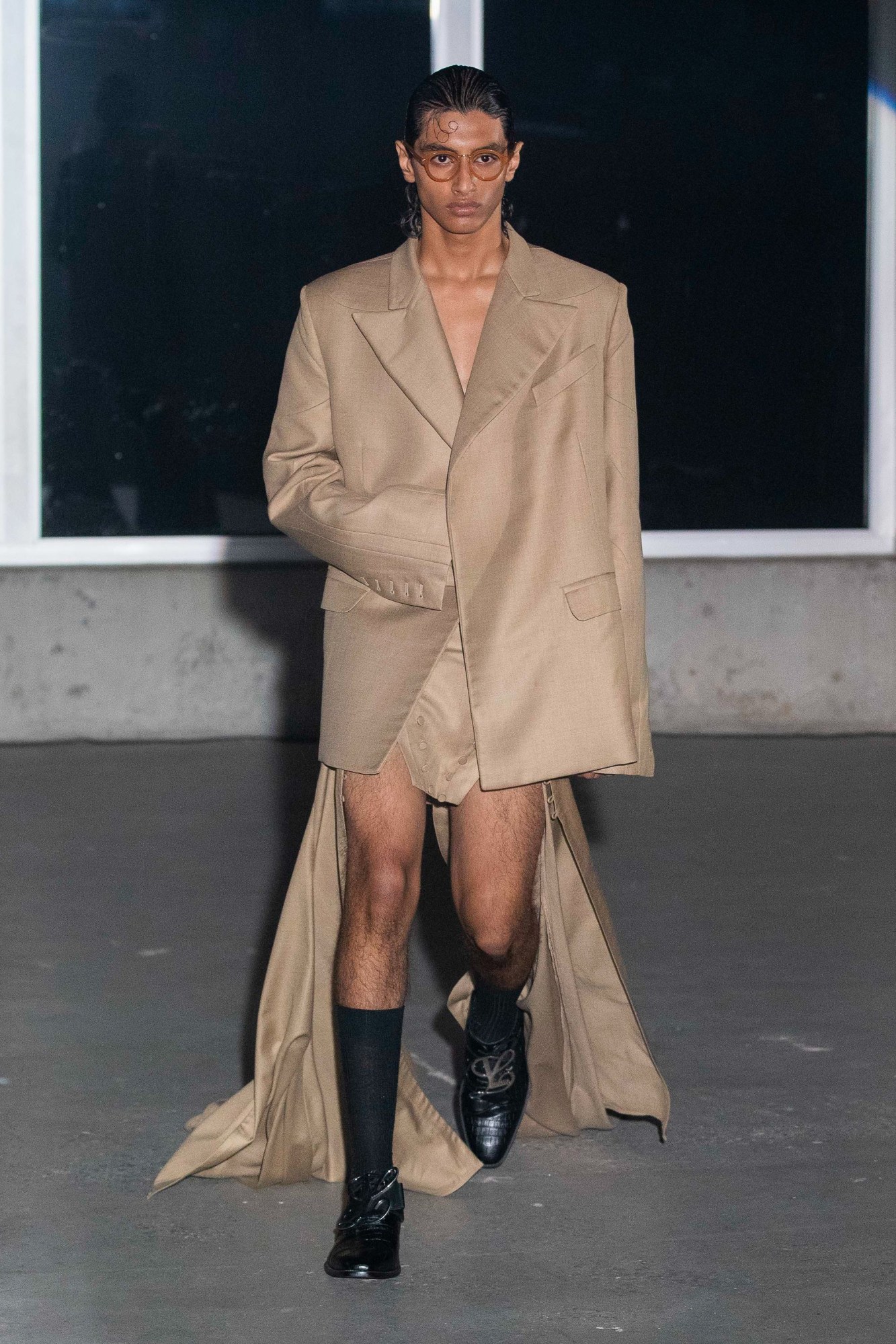
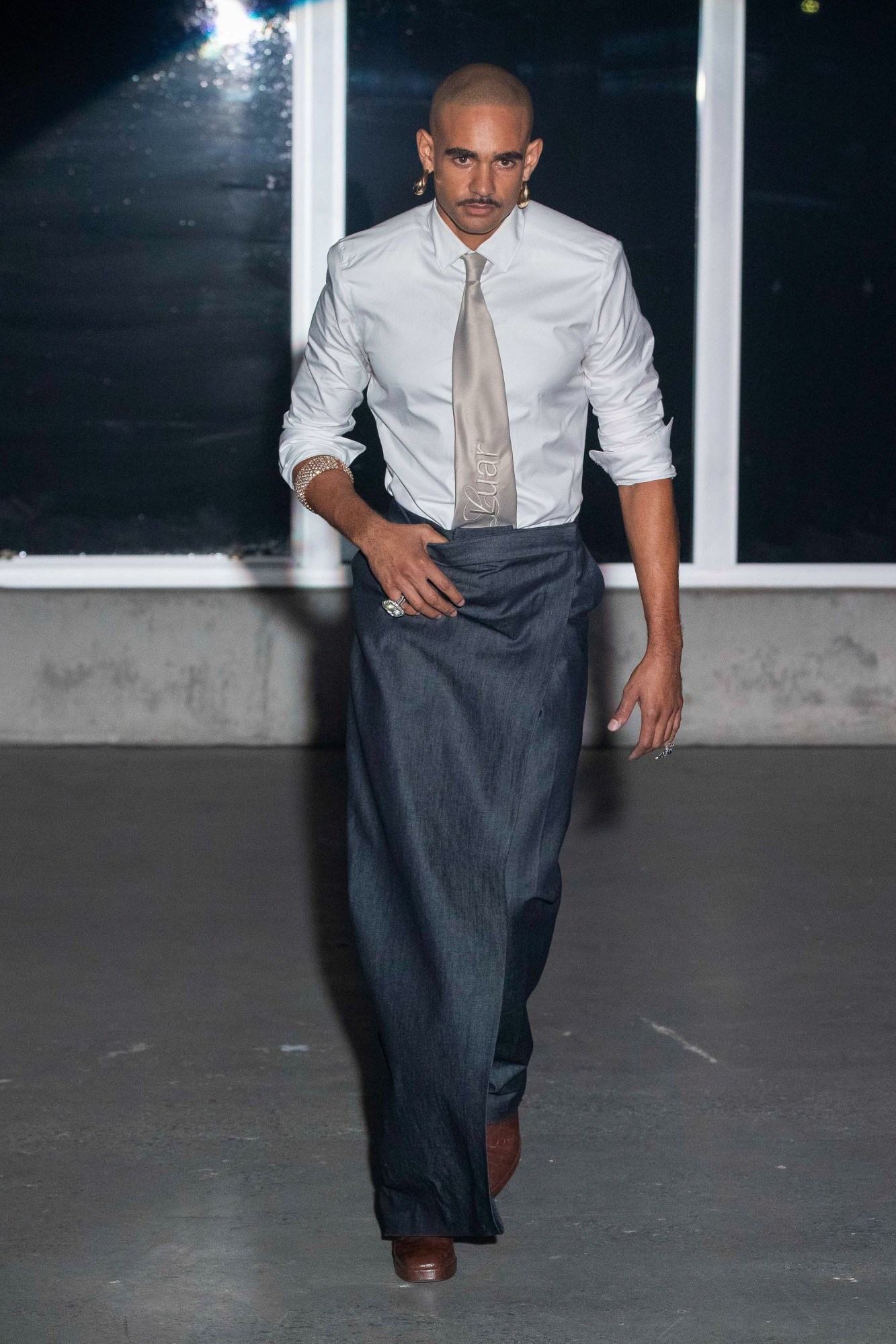
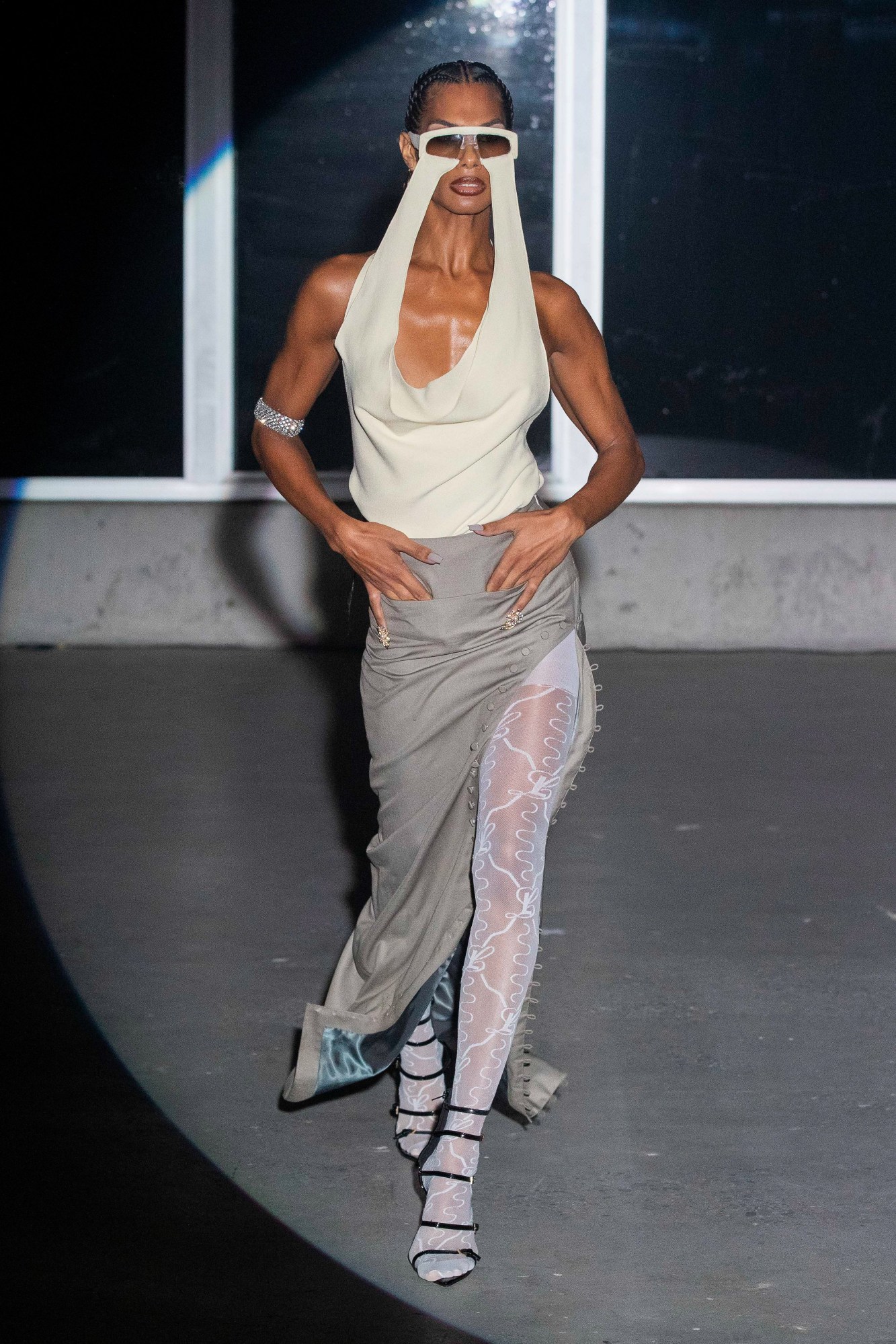
Luar
In the two years since Raul Lopez’s namesake (well, sort of) label made its New York runway return, Luar has established itself one of the schedule’s flagship presences. Now the calendar’s closer for two seasons running, the brand’s shows routinely draw throngs of New York’s fashion-hungry, eager to bear witness to what is fairly renowned as perhaps the vibiest moment of the week.
This season was no exception, with a who’s who of the city’s creative elite descending upon an airy new-build among the grungy warehouses of Bushwick for the grand reveal of Socorro – which translates from the Spanish for “help” or “relief”, and also – true to Raul’s tender habit of paying tribute to the matriarchs of his family – nods to his own mother’s nickname. Rather than a ode to her, though, the body of work he presented beneath fire-and-brimstone strobes sought to channel the connotations of salvation implicit in the term, drawing upon a particular memory from time spent in the Dominican Republic – the country his family hails from.
Pulling up friend’s house in a village on the rural east coast, Raul was immediately stuck by the split situation the unfolded before his eyes – to his left, a woman gave an impromptu sermon from a makeshift lectern, a crowd gathering around her to hear her gospel. On the right, a group of demi-monde types drank, got high and grinded to thudding dembow. While the two parties may have seemed worlds apart, Raul saw a common thread in their respective pursuits of salvation – one find it in God, the other in the refilling of a glass – and started to contemplate the fantasies that people on either sides of the divide might have of switching over, only to pulled back to side they’ve always stayed on.
It’s a notion that played out literally in the collection that stormed the floor, with yanked-back collars on almost-hexagonal poplin shirts and linebacker-shouldered, wool and leather coats and suits connoting Raul’s own feeling of being “pulled back” to his own roots throughout his ascent in the industry. Elsewhere, a sense of duality prevailed in the juxtaposition of prim Sunday best – think: boxy short-suits in luxurious cream crepe; asymmetric car coats and lumbering tailoring in sheened taupe and camel wools; oh-so-proper shirt and tie combos – wth looks that suggested an overt licentiousness. Sheer striped gauze dresses came with chintzy diamanté straps, and vampish leather leotards and overcoats suggested a dark, dominatrix-y flair. Itsy-bitsy Y-fronts were draped about the backside and crotch, tied in place by a giant Luar-logo buckle at the hip, with a similar technique put to use on a body-cladding minidress, and, in what made for a particularly memorable series of looks, backless, what-would-have-been-halter tops were draped from pairs of gradient lensed sunglasses, resulting in pieces basically made for the club.
More than a basic play of opposites, though, there were also individual pieces that embodied this fragile duality by virtue of their construction. Take a closer piece at the aforementioned churchgoer’s tailoring, for example, and you could clock that it was comprised of a clever jigsaw of buttoned-together curvilinear panels, allowing the wearer to fasten (or unfasten) the piece at will, depending on setting and circumstance. A similar logic informs maxi-skirts with zippered thigh-high slights, and – in a real testament to Raul’s design nous – to what, on the hangar, look like relatively modest cassock dresses – when worn, though, cut-outs and a lower trouser-like constructions reveal oblongs of calf and thigh, bringing a flash of sultry immodesty to an otherwise heavenly garment. If ever you find yourself looking for salvation, then look no further, because you’ve found it right here.
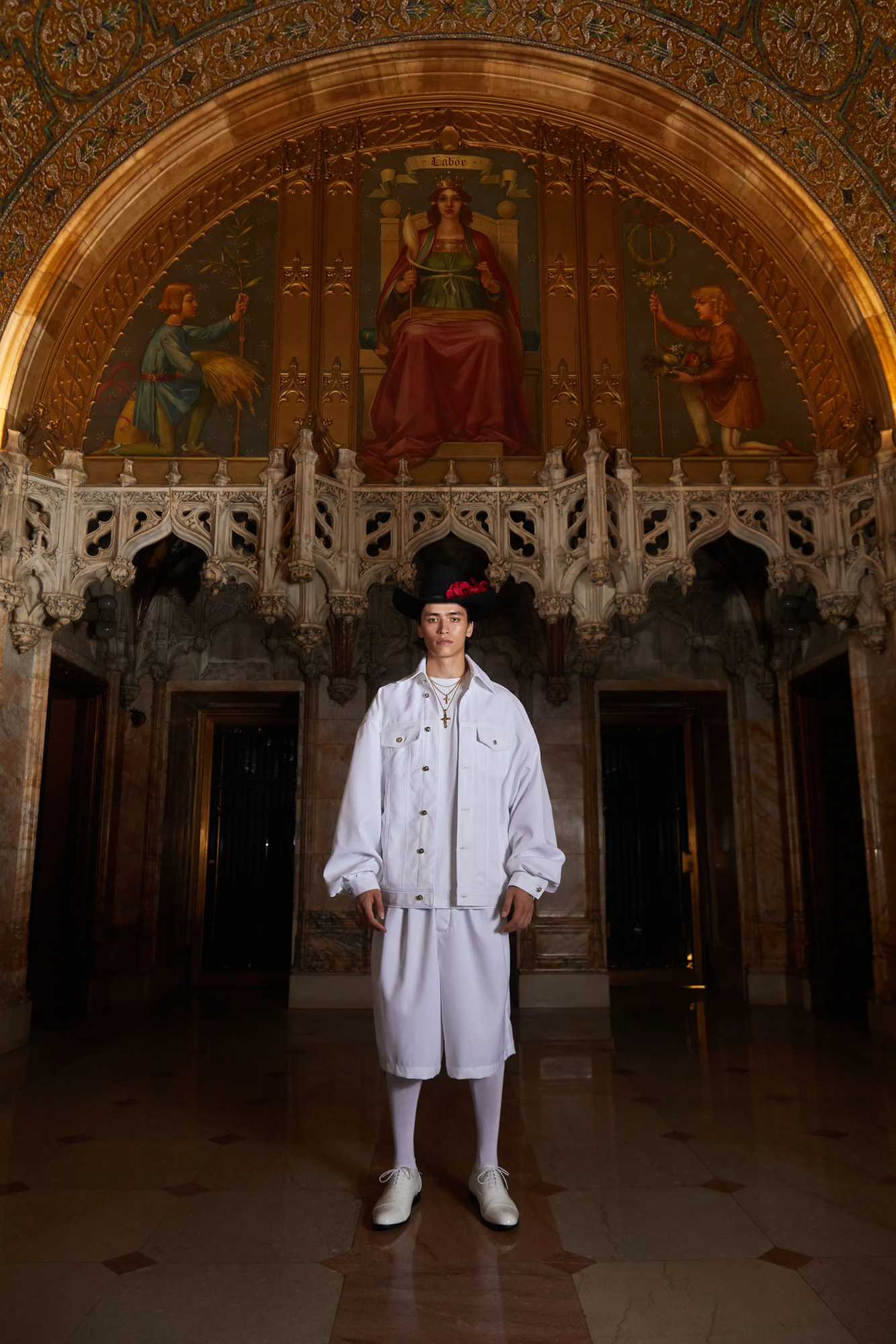
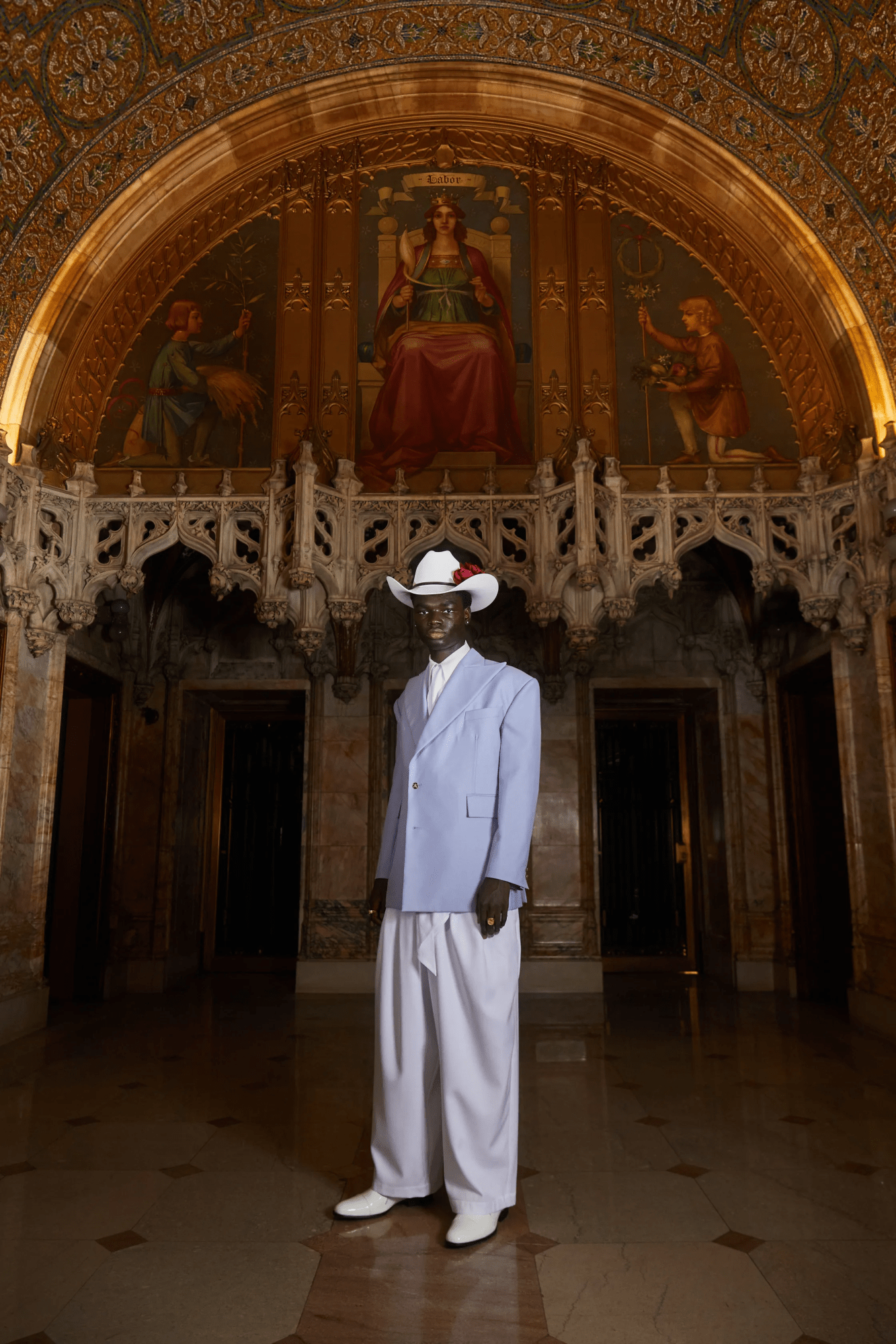
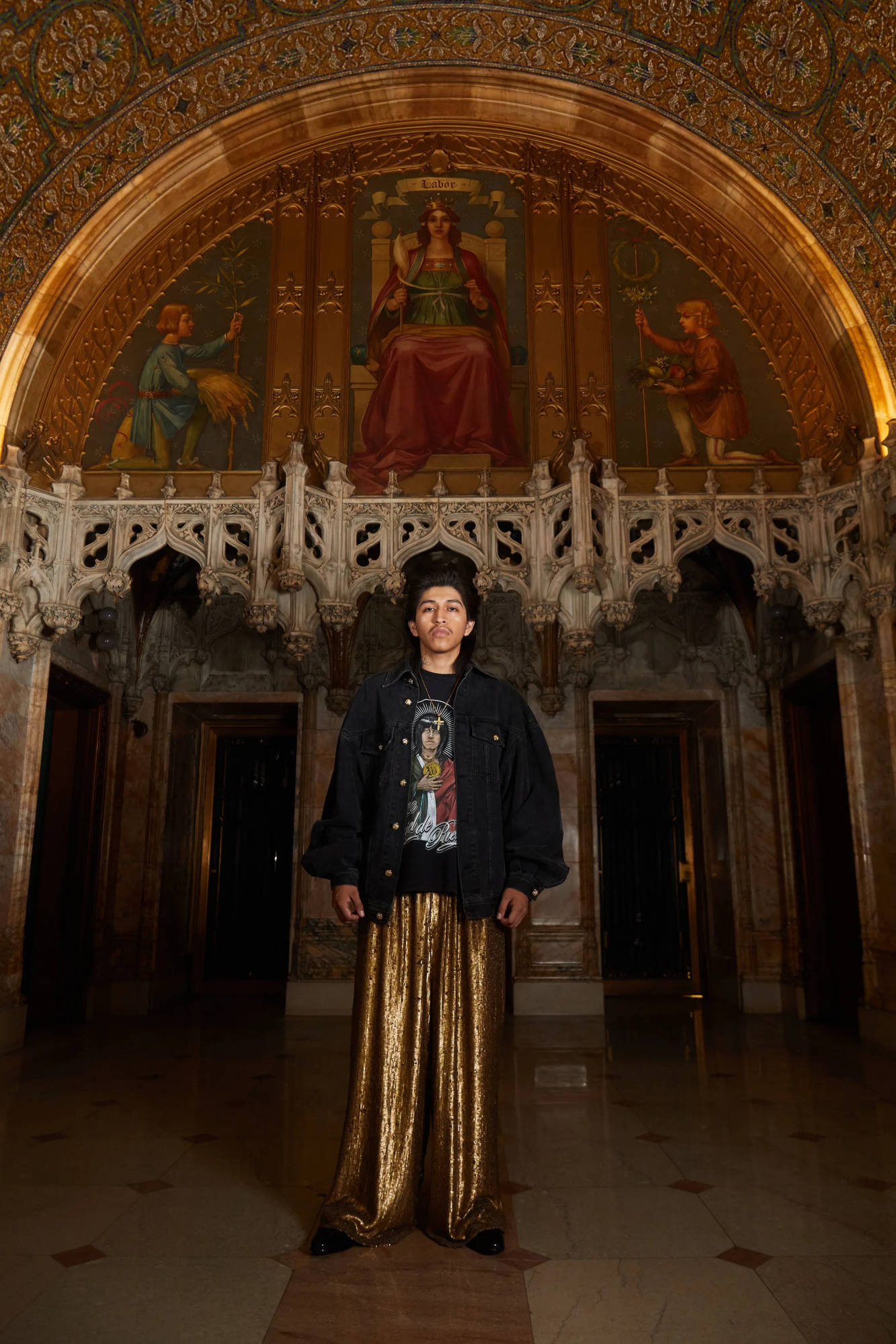
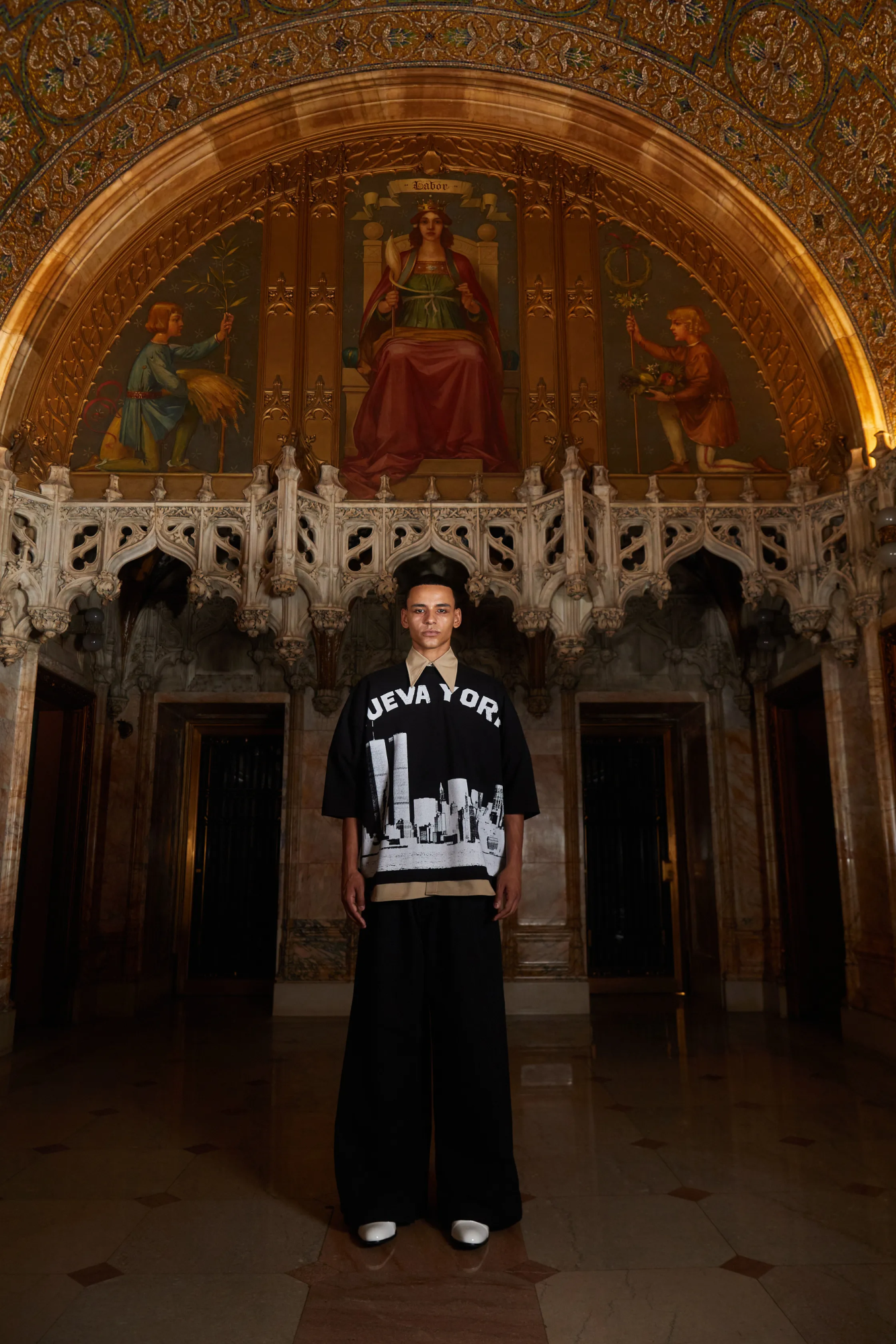

Willy Chavarria
Willy Chavarria loves to put on a show. Whether in a barbershop, a Romanesque-style church, the grand Cooper Hewitt Museum, or now, one of the city’s most iconic skyscrapers – the Woolworth building – it must be difficult to keep finding locations fit for his larger-than-life designs. For SS24, though, his team got it just right. Building upon last season’s all-black proposition of elegant, expertly-tailored menswear, the vaulted marble lobby and its grand staircase made the perfect set for his latest collection, entitled ‘New Life’, which merges these codes with his signature sportswear styles.
The designer presented a series of broad shoulder jackets paired with wide leg shorts or trousers, oversized organza rosettes and hats with flowers on them, that added a bit of romance to the clean white, powder blue, black and khaki silhouettes. There was an ease to tucked button ups, left fully open to frame golden cross pendants, sequined tanks and graphic tees, save for the rounded or pointed collars on the utility shirts they were layered over, and sweeping wide leg denim. Logo windbreakers, varsity tracksuits and basketball shorts, joined the brand’s underwear, which is newly launched this season, in terms of wearability; red and white silk, couture capes did not, but they sure looked epic cascading down the steps.
At the end of the show the models, all 52 of them, lined up on the staircase to pose for a family portrait, while Willy came out the gilded door and put his hands in the air, exalted. “The sounds of cumbia whistle through the holes in my shoes,” the show notes read, “A fog is in my ears as I stand and wait for this New Life.” Save for the flasks of Don Julio on our chairs, we might as well have been in church. ND

Head of State
If fashion adorns the body, art adorns space. By way of Home As Corpus, a new exhibition presented by multidisciplinary fashion label Head of State (founded by Feek Abijako) and curated by Diallo Simon-Ponte, the two come together to bask in a three-day embrace.
On view September 13-15, the exhibition is an expansive expression of Head of State’s SS24 collection and a sequel of sorts to the brand’s last runway show, titled “Memories of Home”, which was densely packed with referential material harkening back to Feek’s familial lore — namely his father’s migration from Nigeria to Spain. The collection sought to locate a visual, conceptual and discursive “middle-ground” between the emotional and psychological vestiges of his Nigerian upbringing, and how it has been coloured by his relocation to the US. Likewise, Home as Corpus brings together the work of Oluwatobiloba Ajayi, Nola Ayoola, Cameron Granger, Lewinale Havette and Isabel Okoro; all of whom are negotiating their own diasporic straddles.
Through painting, photography, film and sculpture, the exhibition seeks to refract the often narrow beam of our conceptions of home. Exceeding geography alone and opting instead for a more tactile and enfleshed definition, Home as Corpus gives credence to embodied knowledge, taking seriously the ways that, as noted by Diallo, “the passage of time has engraved and sculpted lineage into our material existence”. It posits the physical body as a locus through which we may seek our own perpetual homecomings.
Head over to a conversation between Diallo and Feek, as they reflect on their respective routes to design and curatorial work; the genesis of the exhibition; the arc of possibilities enabled by creative dexterity (specifically those enabled by taking on both runway and gallery); and the joys of working with a co-conspiratorial ethic. CB


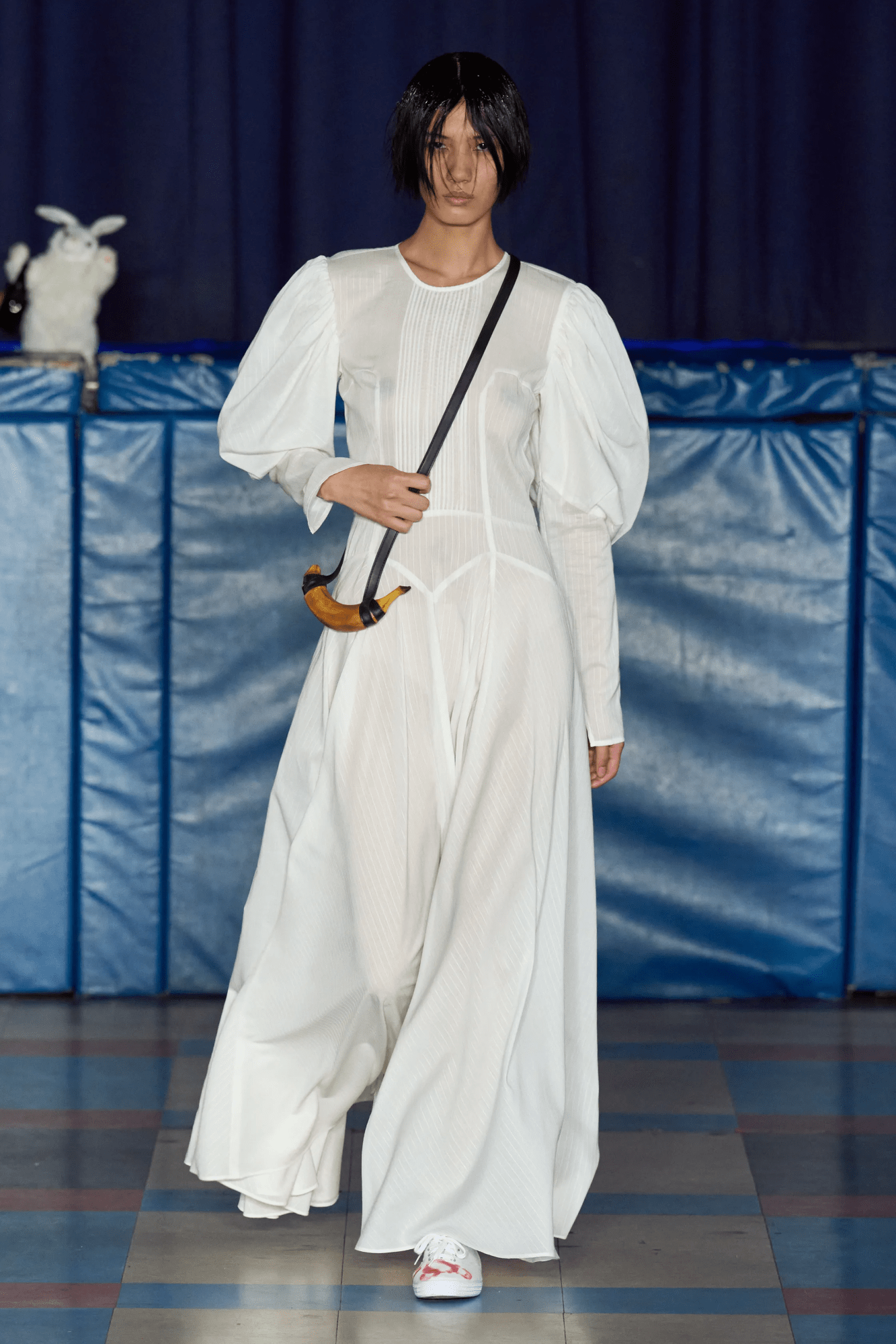
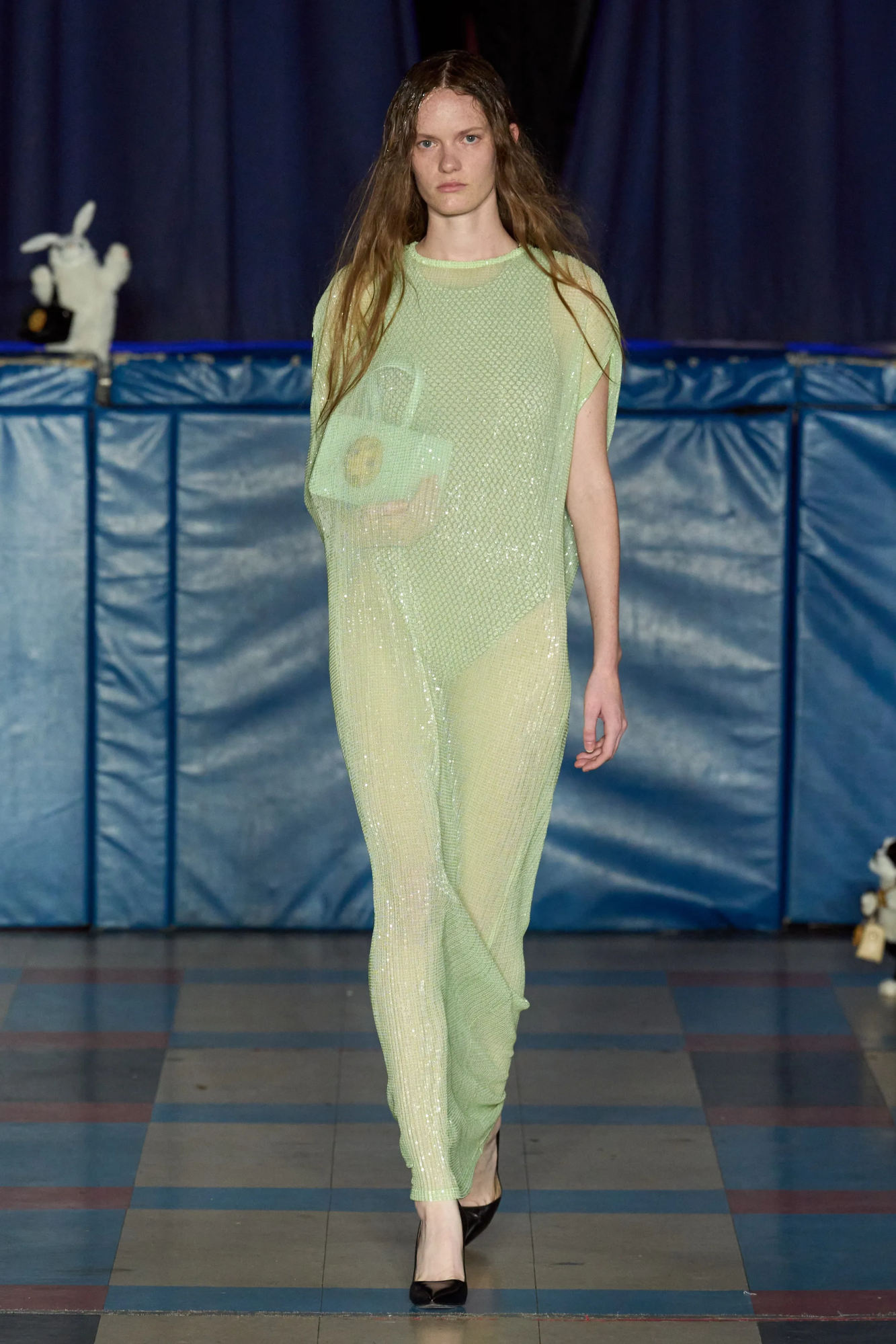
Puppets and Puppets
Carly Mark’s usually includes a fun surprise at her runway shows. Last year, it was towering sculptures made of food, like stacks of pancakes and huge bowls of spaghetti. This year, it was a cameo from subway performer Jazz Ajilo, known for playing the saxophone in the midst of his traveling animatronic stuffed animals who “dance” to his renditions of 80s and 90s smooth jazz classics. The stuffed animals were scattered throughout the gynasium at the Immaculate Conception Church on 14th street, greeting guests as they arrived while wearing custom outfits and the label’s staples like the cookie and banana bags rendered in tiny sizes.
Walking to Jazz’s soundtrack, models wore pieces inspired by a 1964 Japanese horror film called Kwaidan, or “Ghost Stories”. The result was a romantic aesthetic sprinkled with a touch of goth, manifested in the form of flowing, sweeping gowns with phantom-esque vibes, like a white semi-sheer dress with sleeves in Victorian proportions, or a pistachio caftan styled with the bag tucked and featured from underneath. Other motifs included sequins, soft fringed hems, oversized florals and ample volume. Oversized taffeta wide-leg trousers, skirts and tunics marked a return to the proportion-play of earlier collections. Layering sportswear with those extravagant pieces – like a simple black hoodie emblazoned with an unknown femme figure lying on a bed – made them feel more wearable, while still sending a clear message. Haunting. AT

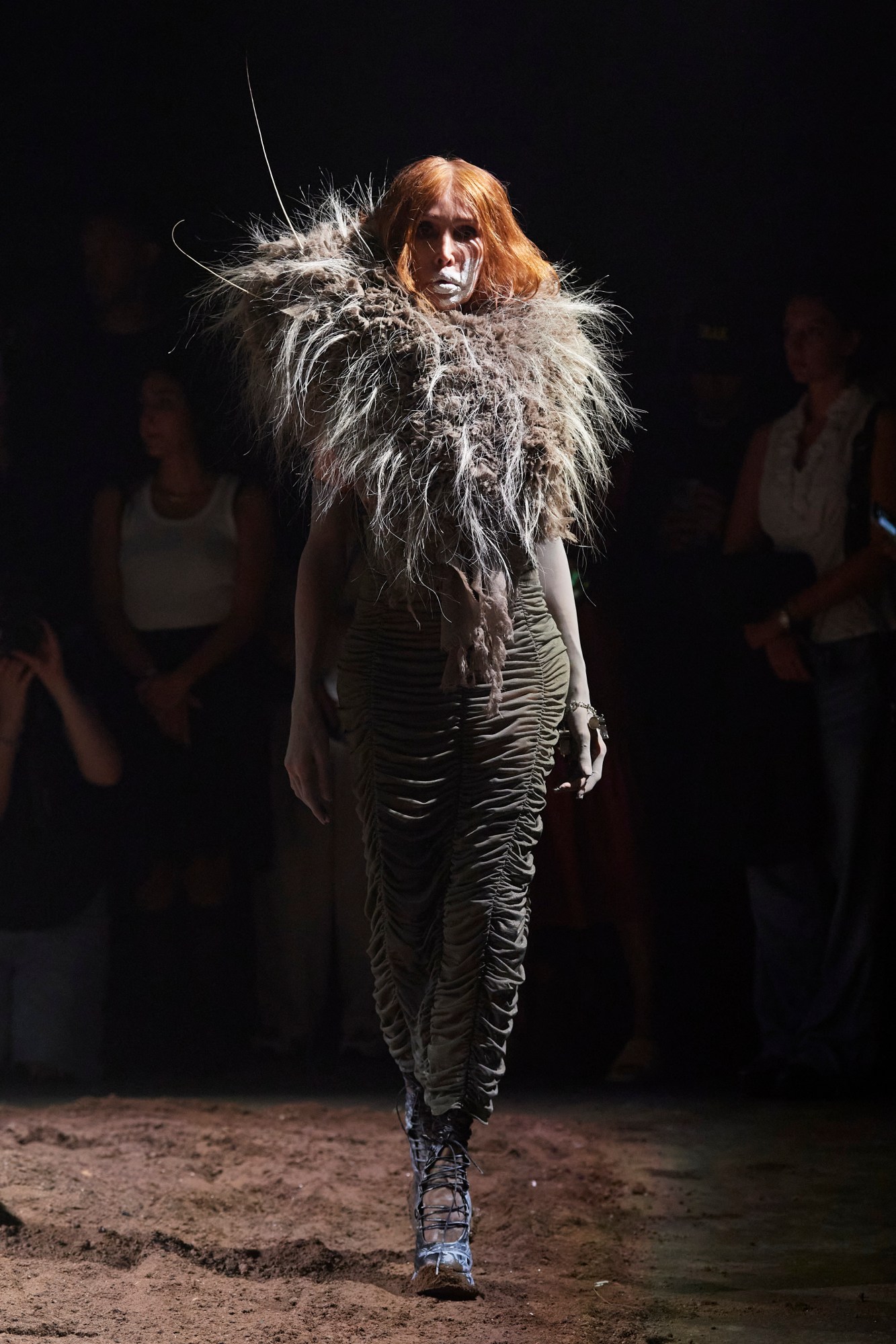
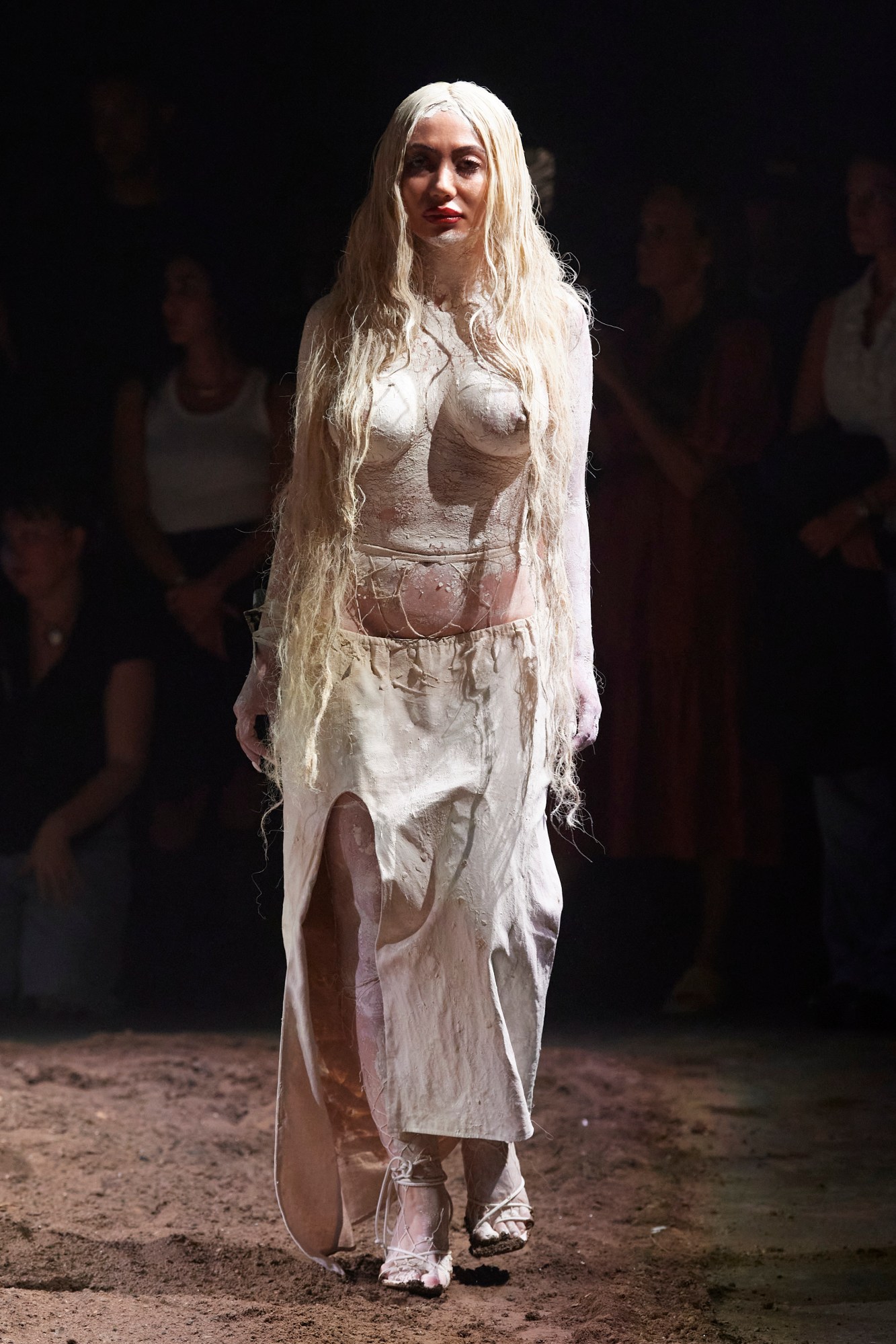

Elena Velez
Before Elena Velez’s SS24 show even started, people were talking. There were questions of how the designer was going to pay for it; and who might walk, for free. There were some moans about going out to Bushwick – though, to be fair, a handful of designers forced editors to make this trek this season – and then, there were rumours that there would be mud, which resulted in one collective, resounding, “Ugh”. However, those who made it out to Elena’s warehouse show not only witnessed a spectacle, but a collection with range, spanning her signature, tattered gowns to more wearable cotton tees, layered mesh tanks and skirts, and hoodies.
As we stood around a rectangular mud pit, lights flickered and the first model walked out from the shadows, traipsing through the mud in a destroyed white jersey dress and boots, hands cuffed behind the back. The following looks saw khaki canvas seamed up the front in workwear dresses and skater shorts, a bubble skirt and corset tie top, and an open pannier gown, all splattered with white paint. ‘YR004 MANIFESTO – THE LONGHOUSE’, which was inspired by downtown New York’s avant-garde lit scene, according to the show notes, “is a creative interpretation of the reorganisation of contemporary society around feminine expressions of control and behavioural modelling. In a climate of post-progressivism where resistance to monolithic cultural paradigms are intensifying, YR004; The Longhouse is a ritualistic catharsis to the coddling, histrionic and moralistic ills of oversocialization.”
In simpler terms and throughout her design practice, Elena is creating space – for more nuanced portraits of women, for changing aesthetics, for the anti-heroes; she’s creating space for “complex, dualistic, and paradoxical conversations around contemporary womanhood,” even if it feels uncomfortable, at times, and whether you like it or not, she’s creating space for difficult conversations to be had about the reality of being a designer in today’s world. Her SS24 finale, in which models began pulling each other’s hair, clutching at the mostly white and cream garments, and ferociously wrestling in the mud, was impossible to look away from – hopefully it cuts through the noise. ND
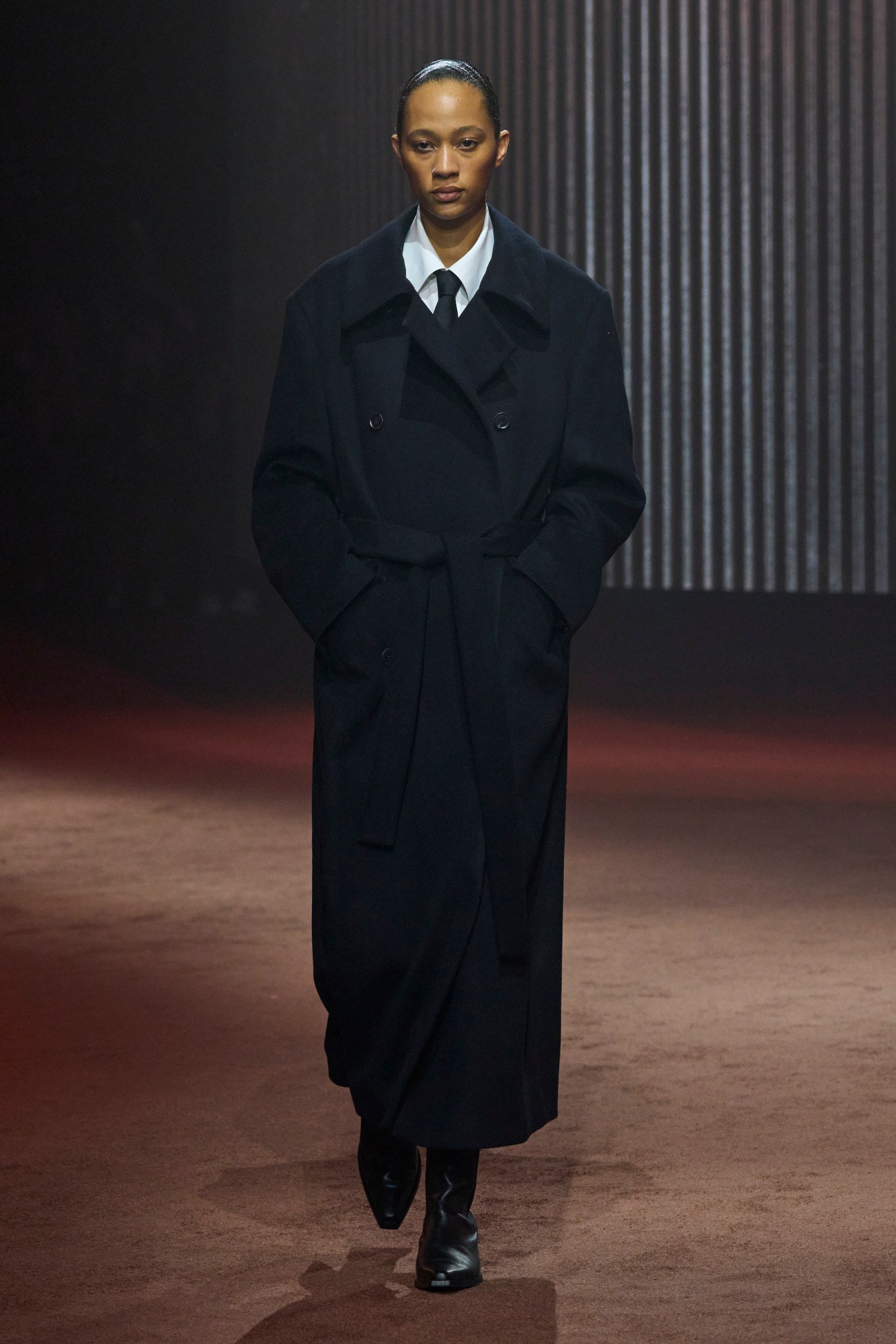
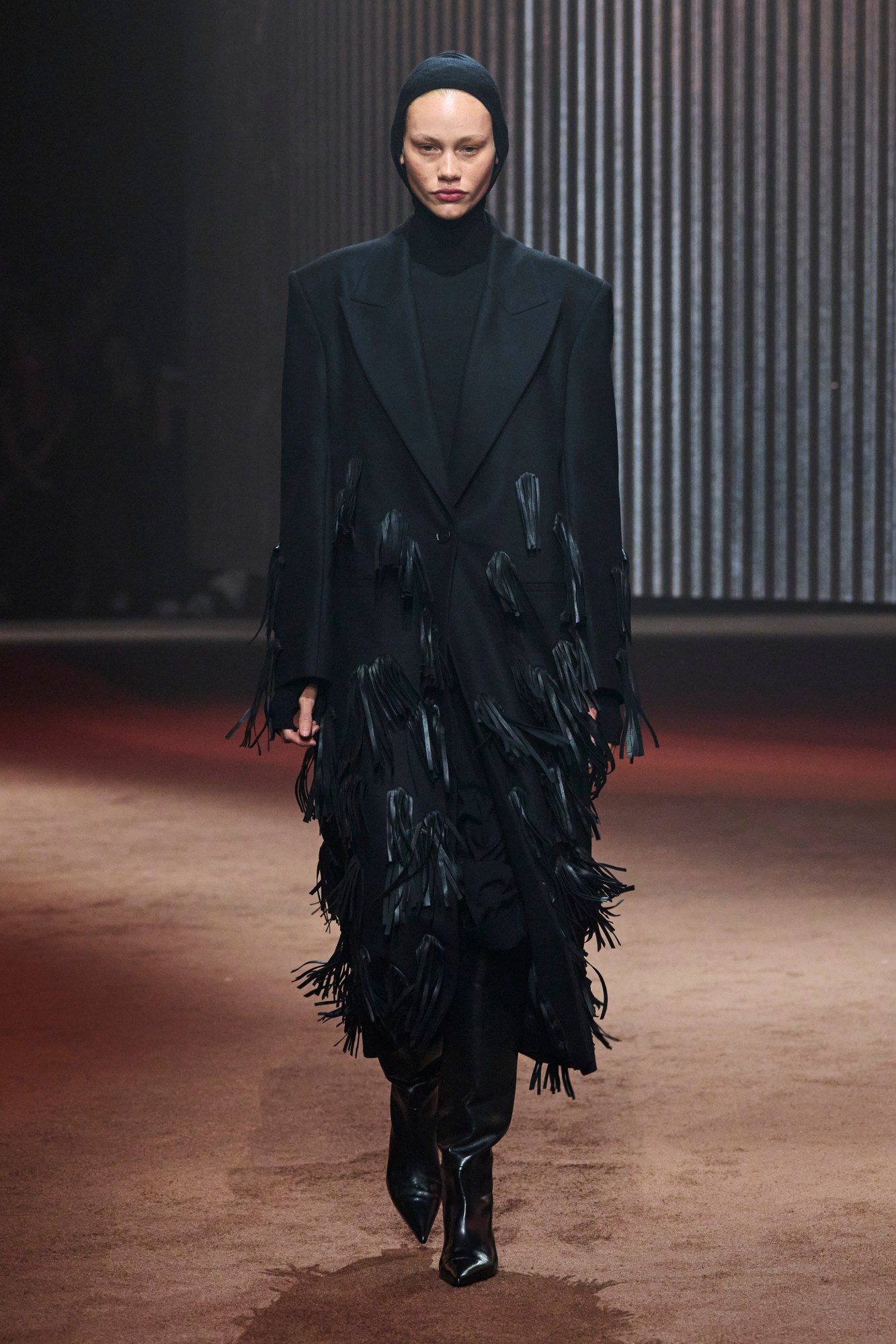
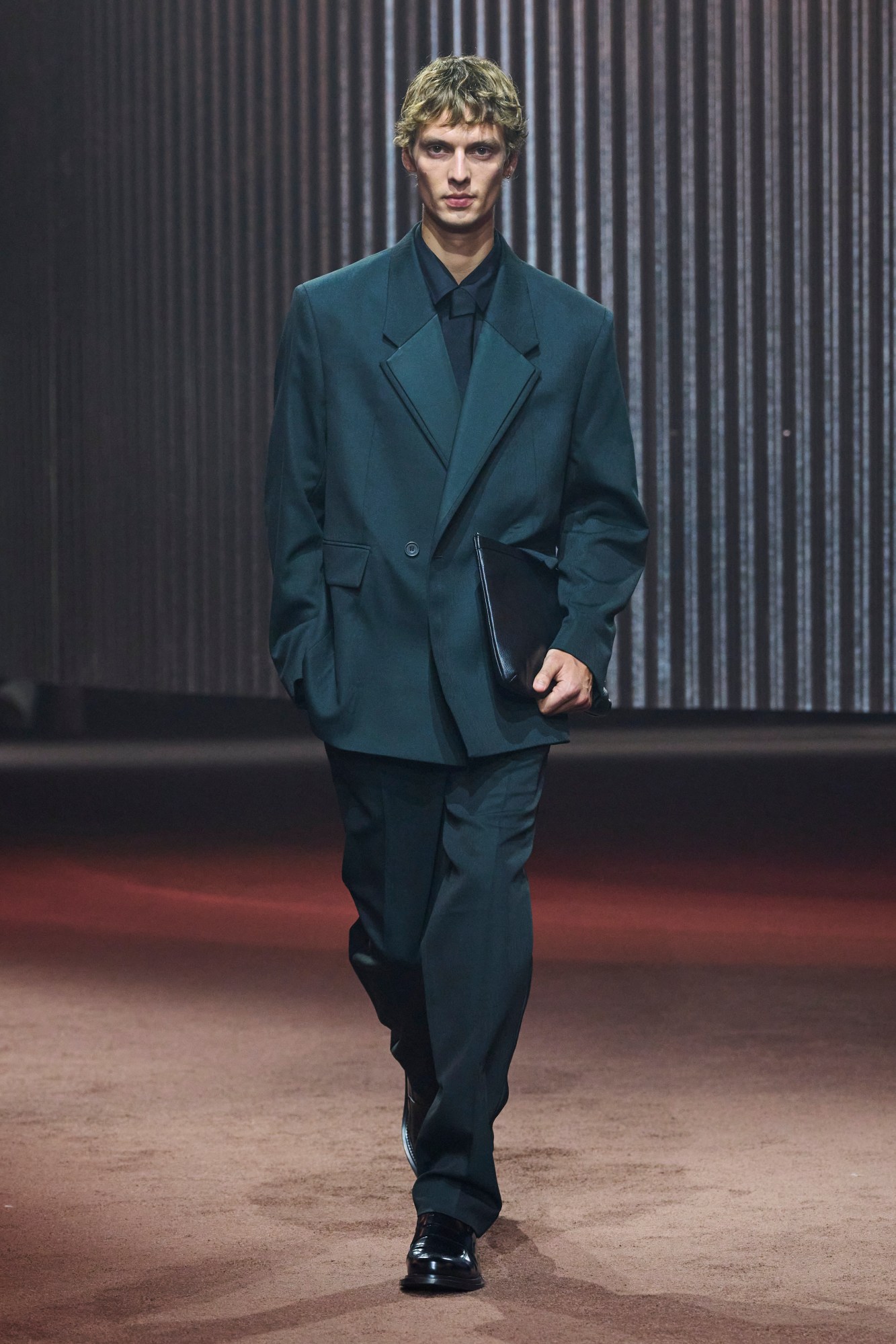
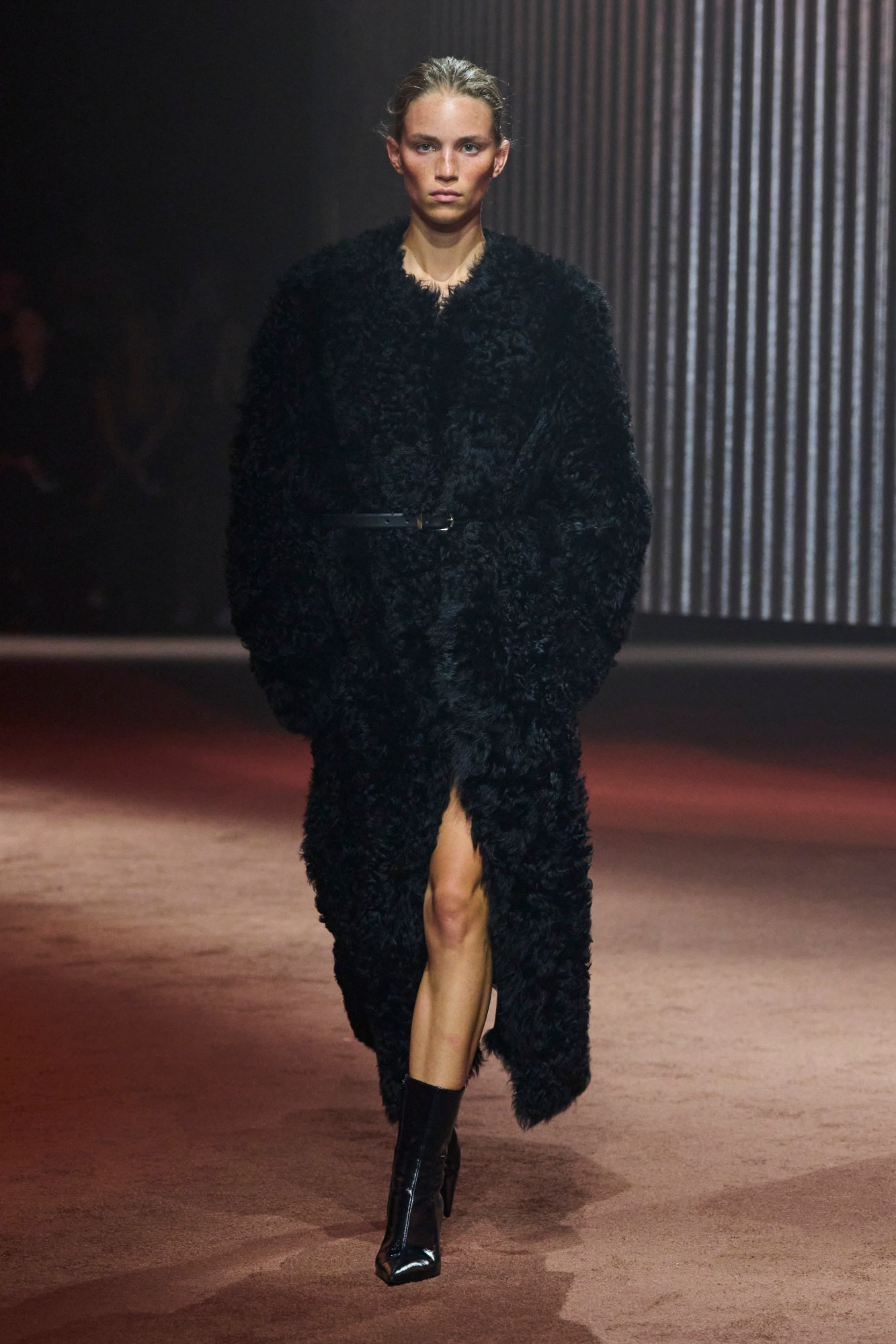
COS
COS isn’t exactly a name one typically associates with the runway, but, at its recent New York show – staged at golden hour on the banks of the Hudson – the Swedish high-end high-street label made a strong point for why it should be.
Typically renowned as a go-to for soberly chic clothes cut to the measure of a Monocle magazine lifestyle, there was, indeed, plenty of that on offer in the form of sensible black shirting, billowing jumpsuits in slightly iridescent crepe and amply cut tailoring. Where the COS design team really proved their mettle was with pieces that demonstrated real fashion kudos. Slope-shouldered suits were expertly cut in sheen-y black leather, and wool outerwear pieces featured hulking blanket drapes. Shirt and palazzo pant twinsets figured in twinkling nightshade lurex, while swishing pearl satin gowns featured doubled spaghetti strap necklines. Perhaps the most striking looks, though, came by way of the coats, with a belted, collarless black shearling number and a jet black wool piece with sprouting fronds of leather cutting particularly strong shapes. The best thing about the show? The fact that, unlike most of what we’ve seen this season, this was an AW23 collection – meaning that everything seen here will be available in your neighbourhood COS imminently. Great news indeed for impatient fashion fans! MS
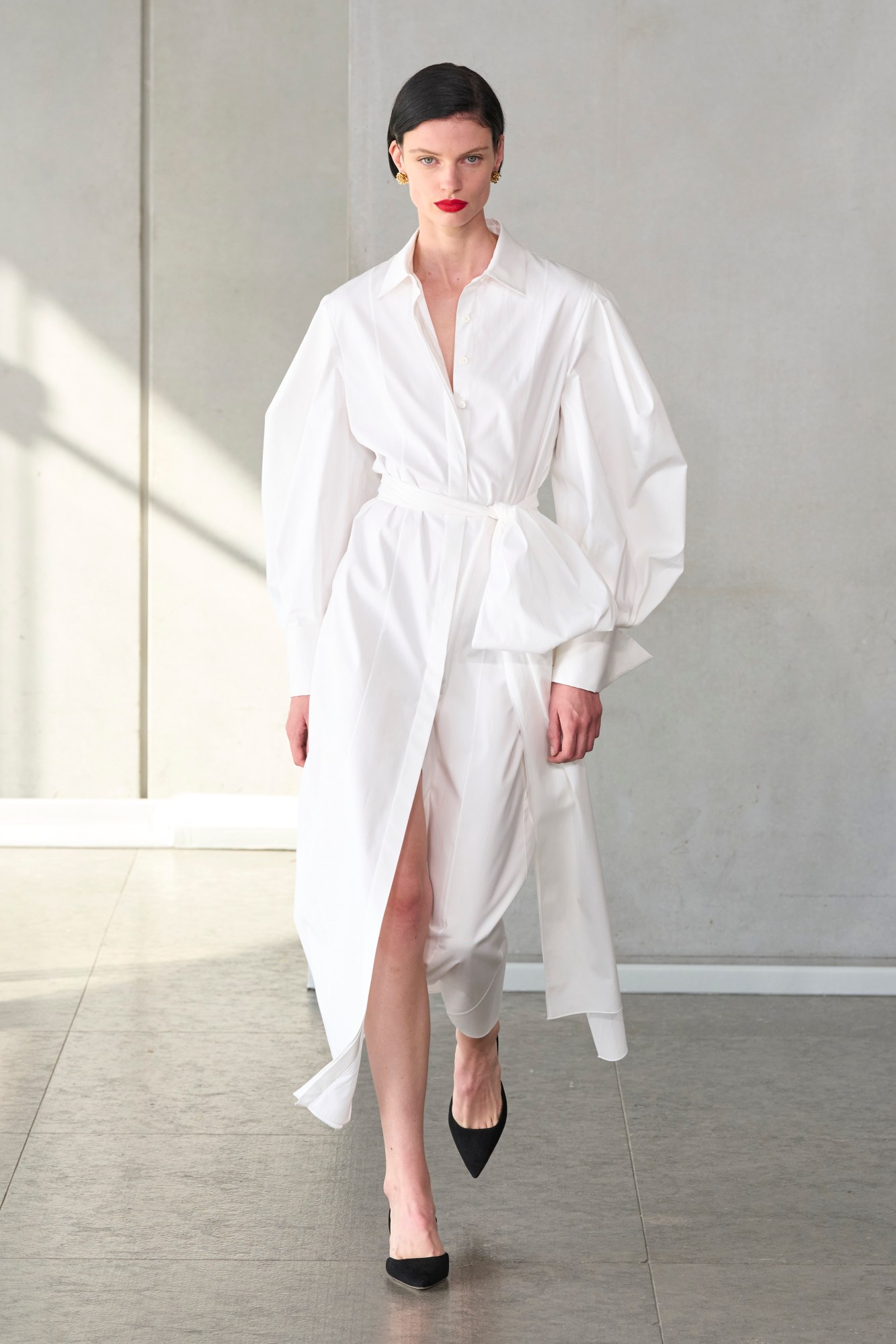


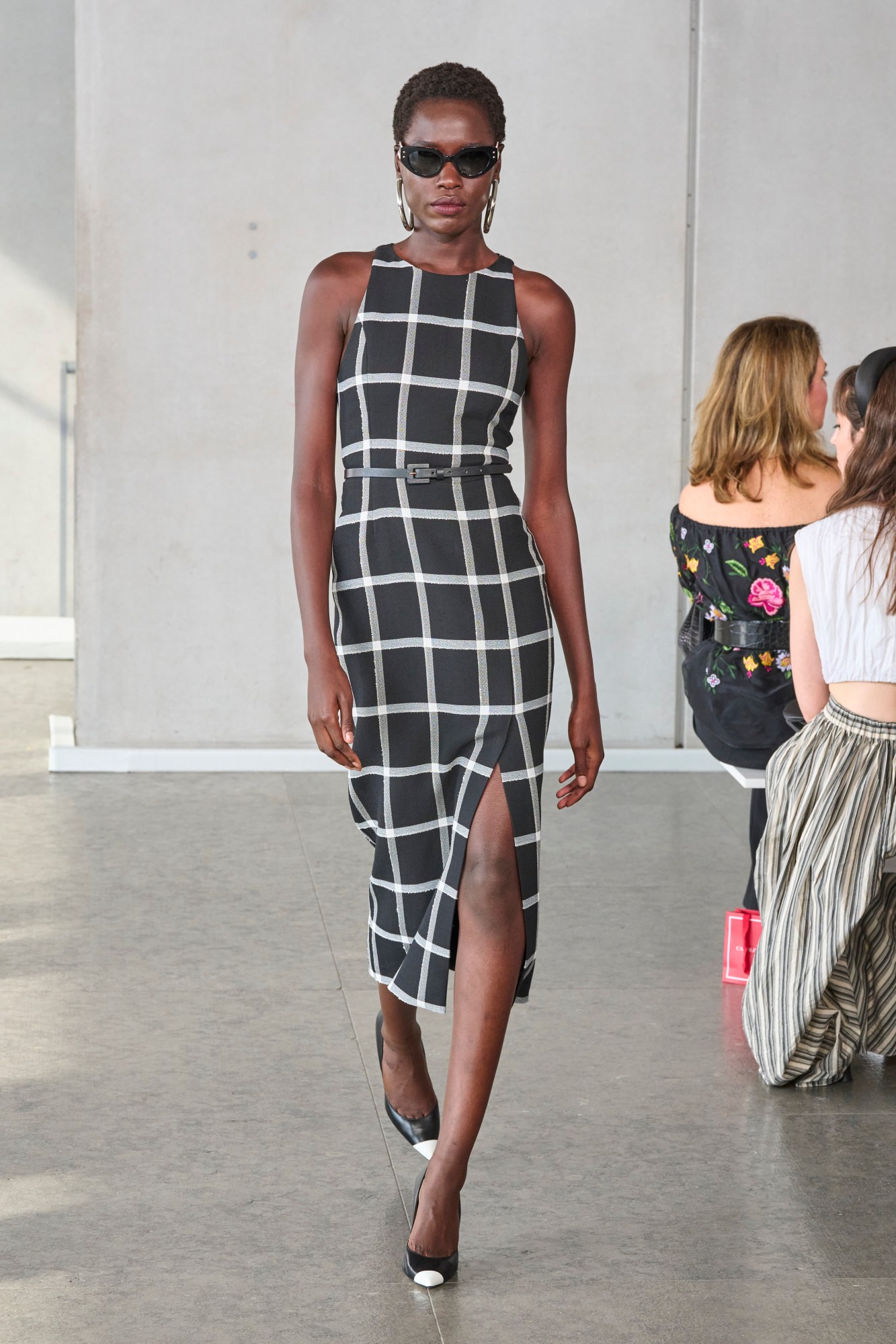
Carolina Herrera
Carolina Herrera’s Creative Director Wes Gordon, who this year celebrates his five-year anniversary of taking the reins at the storied label, was thinking about Carolyn Bessette Kennedy while designing this season’s collection. It seems fitting then, to choose the Whitney Museum in Chelsea — also an icon of American style and sophistication — as a backdrop for their runway show. Show notes explain that he was aiming for “an effortless approach to dressing, injected with the vitality of New York.”
The show opened with the brand’s signature white cotton shirt, paired with a sharp black pencil skirt, followed by pieces rendered in clean lines in playful prints, pastels and florals. Carolyn Bessette Kennedy’s presence could be felt through fine gauge knits and slingback kitten heels — both 90s street-style staples. There were separates in sheer lace, and silk bias-cut dresses that sensually followed the lines of the body. Splashes of soft hues, like a lemon-yellow tailored jacket worn with a whimsical tulle skirt, harkened back to the core DNA of Carolina Herrera and her approach to uplifting colour.
Still, Wes did not resist the subtle power of black, a key ingredient in any truly chic uniform. Particularly compelling were a trench gown in sexy satin, and a striped, sculptural tulle dress that somehow felt both extravagant and simple: two words that have and always will define luxury. AT

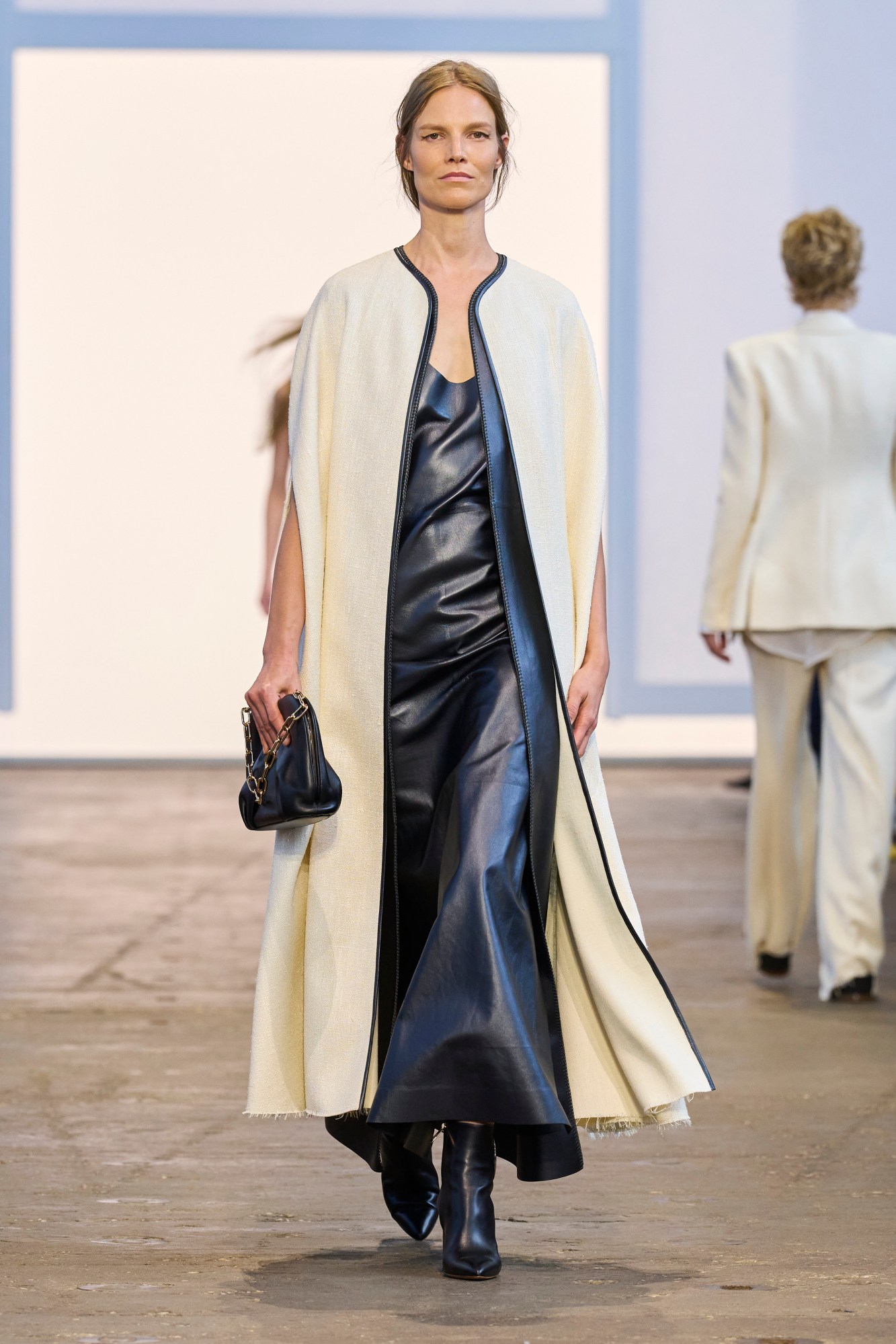

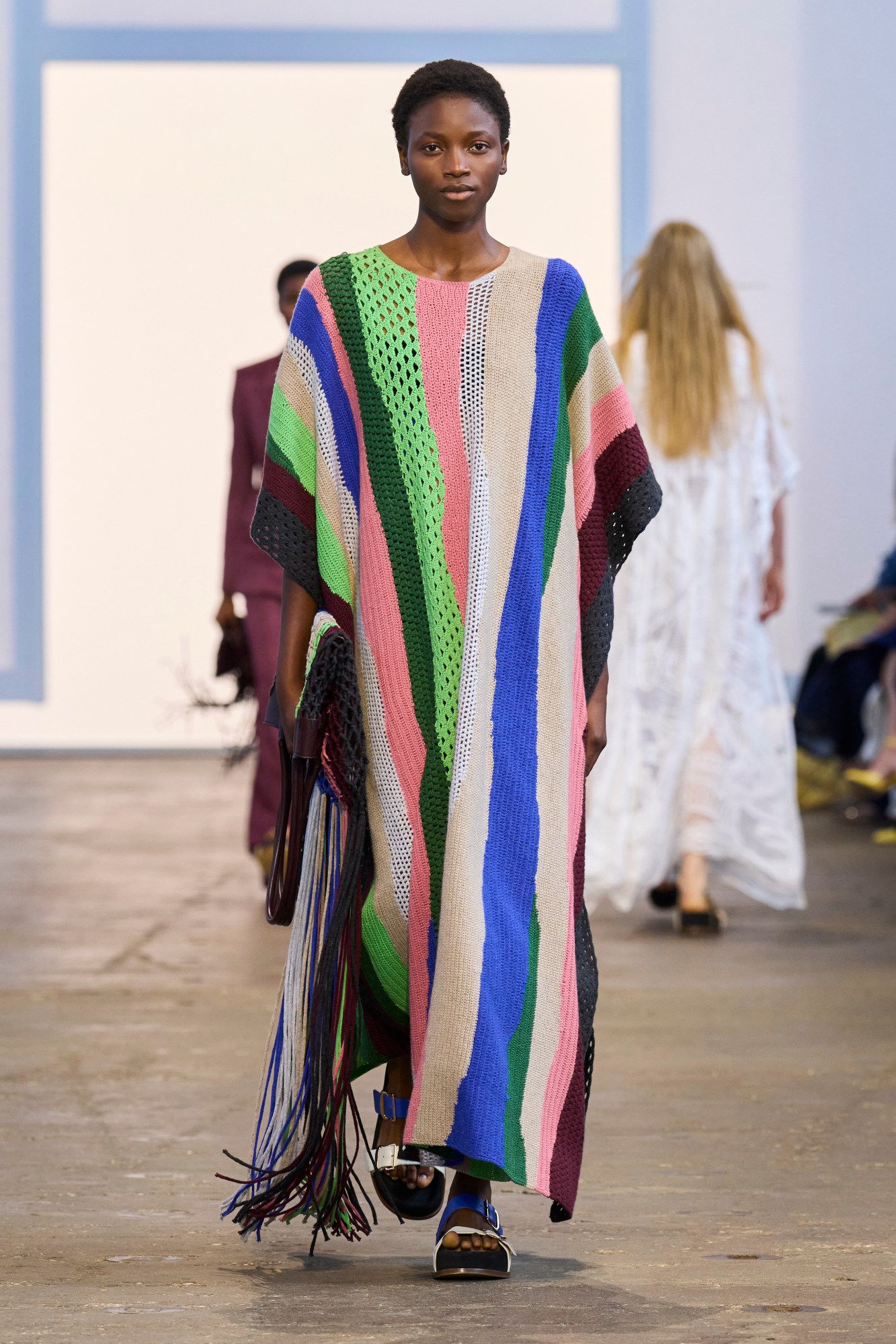
Gabriela Hearst
If there’s anyone who must have been laughing all the way to the bank with the recent boom in ‘quiet luxury’, it’s Gabriela Hearst. A longstanding proponent of the muted trend, her namesake label is among New York’s foremost purveyors of clothes that give rich without screaming it – their eyewatering pricetags immediately discerned from the subtle sheen of a duchess satin, the butteriness of a leather dress, or the weightiness of a wool jersey.
This season saw the Uruguayan designer double down on her title as quiet luxury’s reigning queen, delivering a collection that oozed understated refinement. In a predominant palette of blacks, whites, écrus and cream, long-lined shirt dresses and pleated skirts figured in sumptuous wool-silk blends and gossamer chiffon. Elsewhere, evening dresses with sculptural shoulder details were bisected, crafted in leather and wool, with tailoring in generous fits and shirts in crisp, snow-white poplin featuring dramatically overblown collars. Knits were also a key focus, serving as the main conduit for pops of colour that came by way of intricate rainbow-striped macramé kaftans, created in collaboration with Haitian artist Levoy Exil. MS

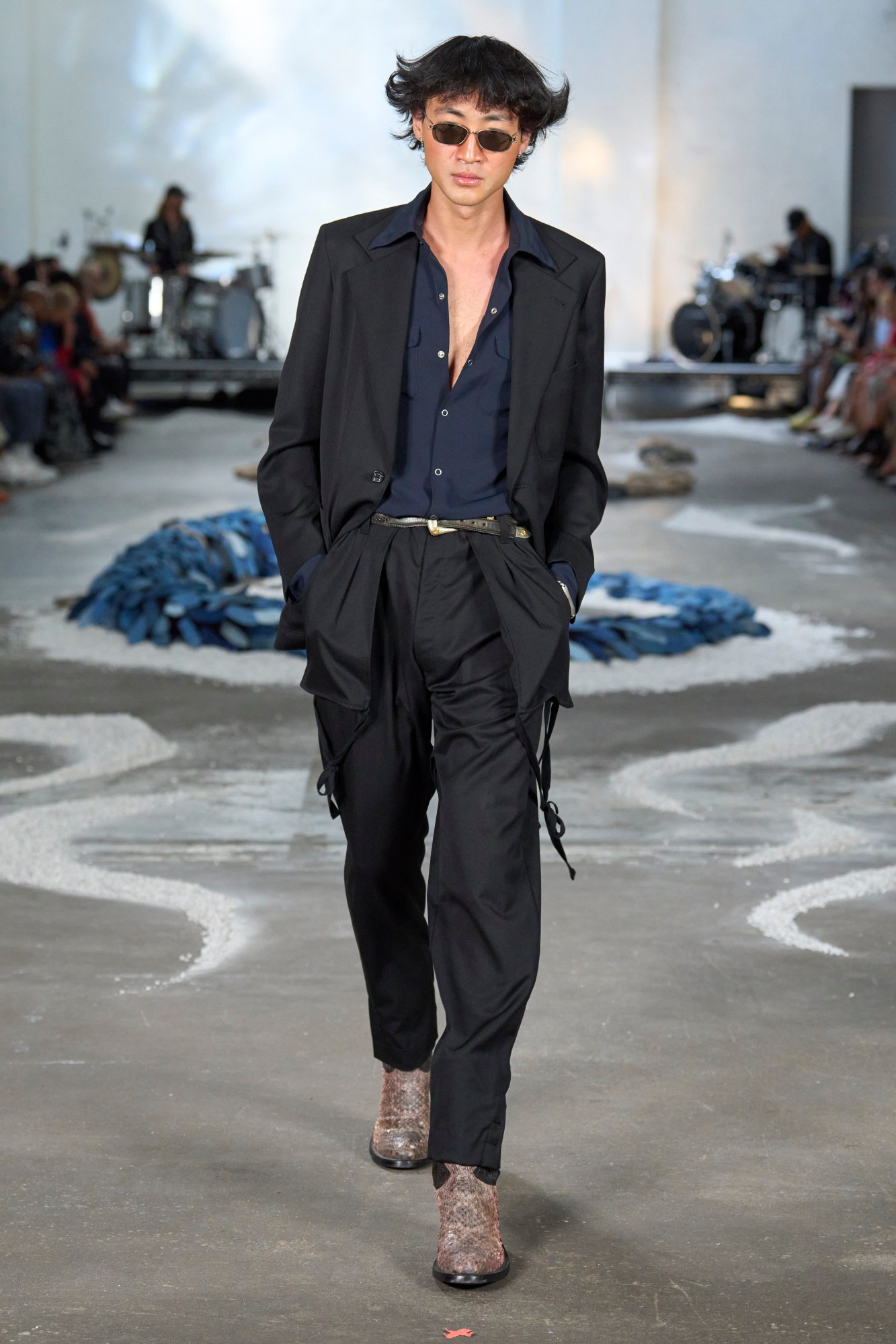
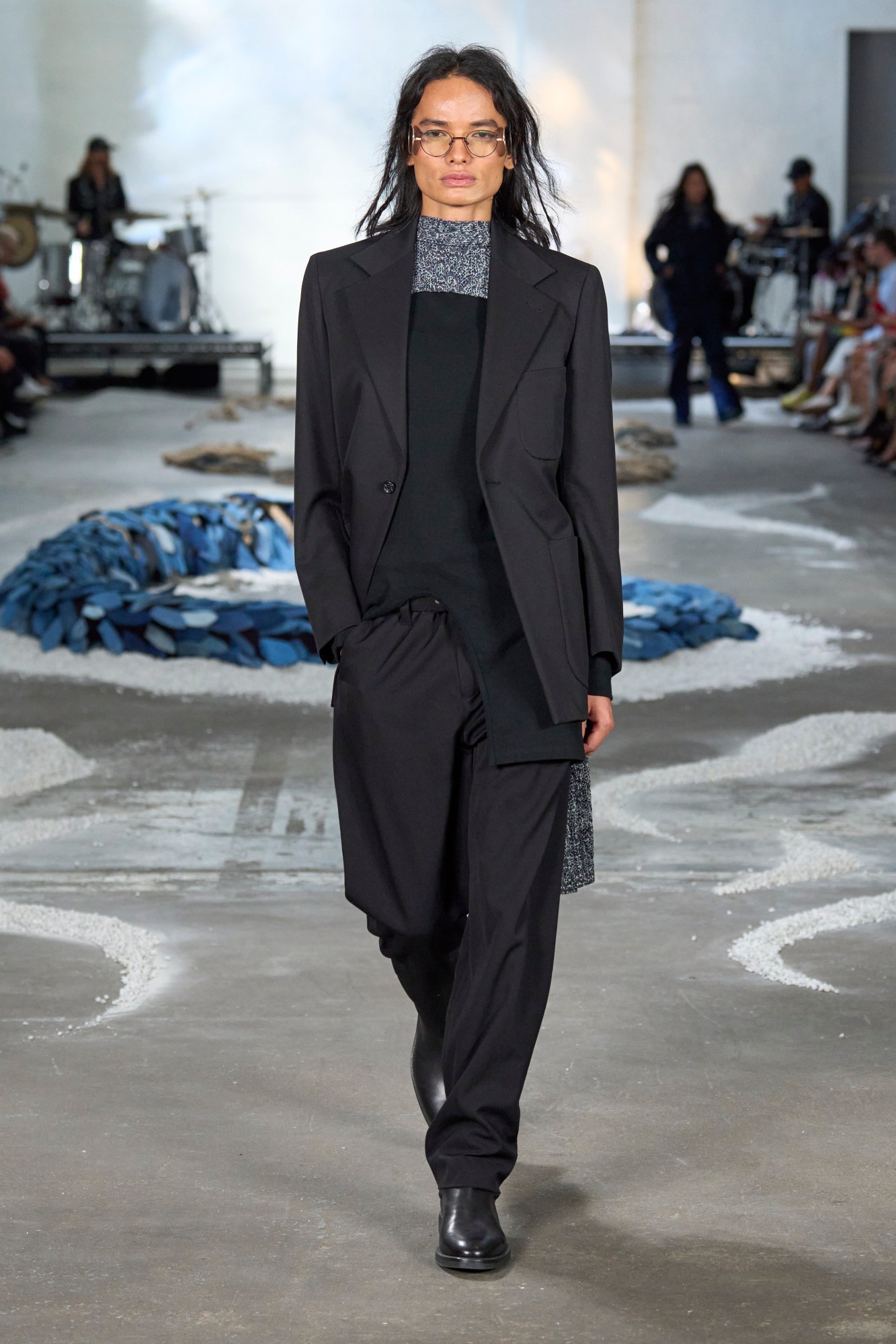

Kozaburo
With the world in its current state, you can’t blame anyone for wanting to escape – to cast off in pursuit of a utopia unlike the world we currently occupy. For his first-ever show on the New York schedule, Kozaburo Akasaka gave the world a peek at what his dream world would like – or, at least, how its inhabitants would dress. Envisaging a “Land of Setting Sun”, the designer sought to evoke the mythical guardian deities that live there, particularly those that figure in the forms of dragons and snakes.
Drawing upon a global pantheon of serpentine deities – like Mami Wata, the python-bearing water spirit venerated in a range of Afro-diasporic religions, and Ugajin, the god of fertility in Japanese mythology – the New York-based Japanese designer presented a collection that channelled their essence. Save for the occasional nod to the Chinese zodiac and ouroboros motifs, his interpretation was figurative in nature, relying on textural manipulations to create scaled effects on upcycled, woven jeans and puckered knits. Naturally for the designer, denim featured prominently, with his signature low-slung silhouette returning in raw indigo iterations of the fabric, while skinnier fits in lighter washes channelled the collection’s serpentine theme by way of innovative pattern cutting, with each pair collaged from curvilinear swatches of fabric. Elsewhere, graphic squiggled prints extended Kozaburo’s nuanced exploration, rounding out a very successful runway debut. MS
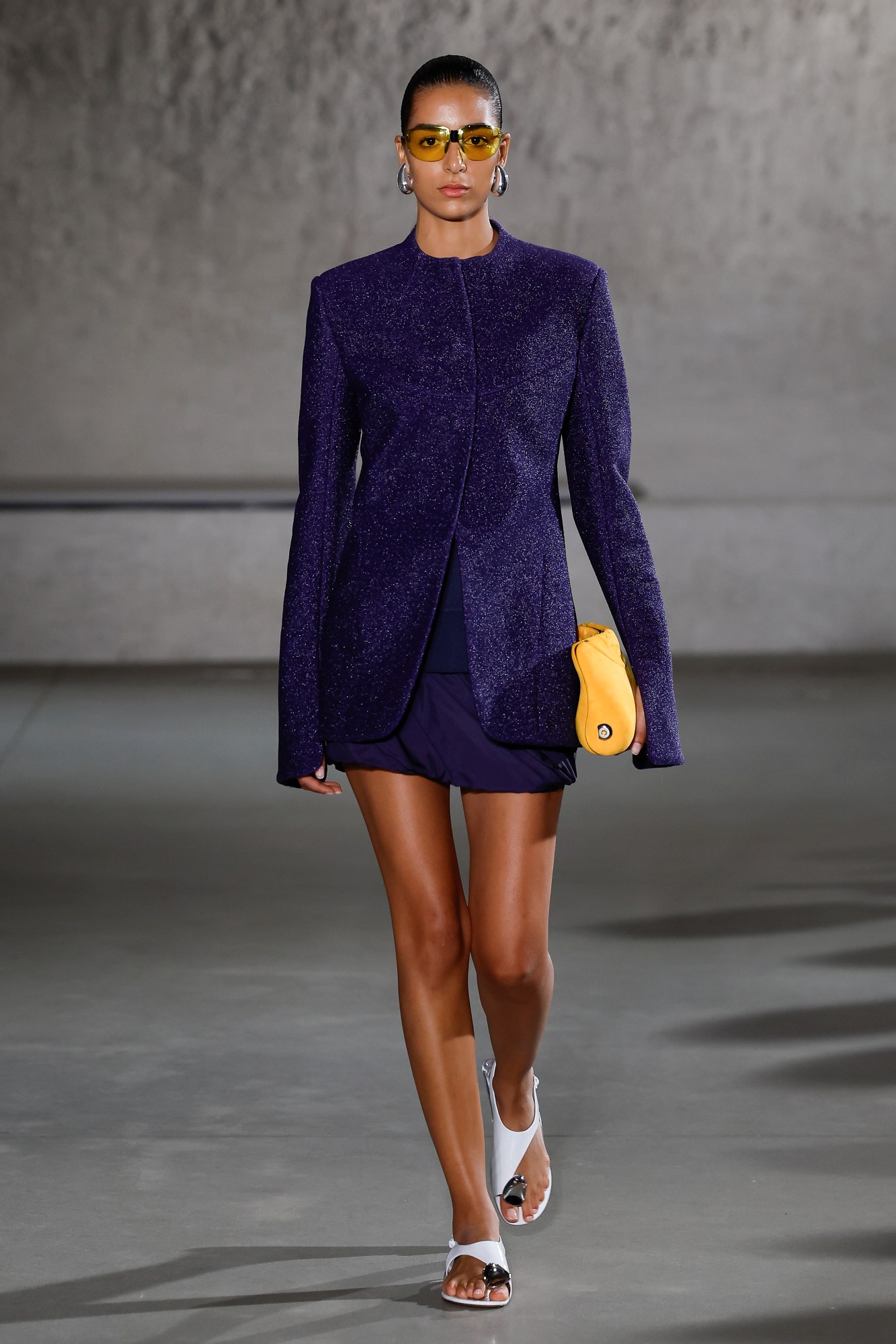
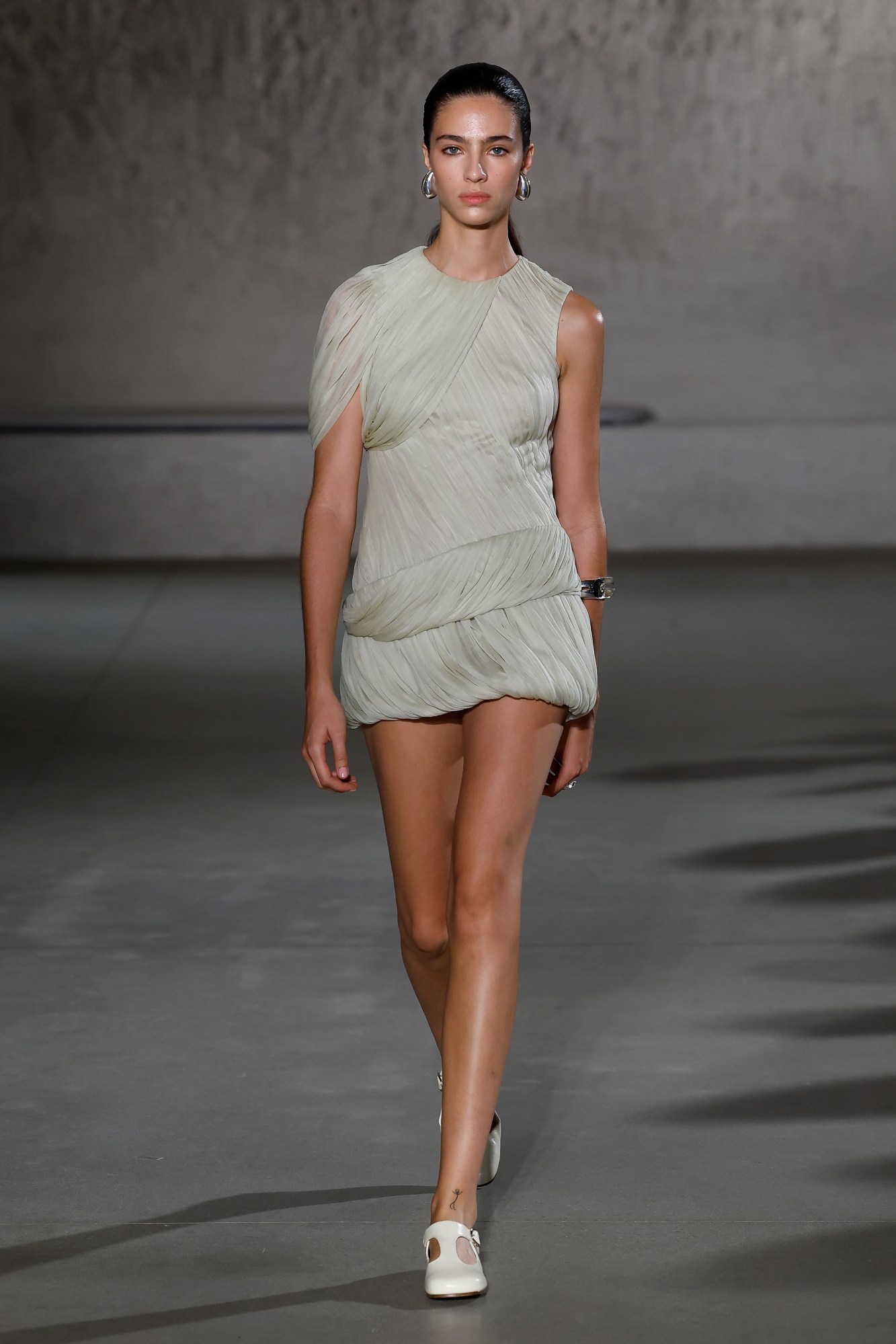


Tory Burch
On Monday night, Tory Burch held her SS24 show in the American Museum of Natural History’s brand new Richard Gilder Center for Science, Education and Innovation. The building houses a butterfly vivarium, insectarium, rotating exhibitions and immersive experiences designed to “reveal nature’s hidden realms”, while its architecture is intended to “spark your curiosity”. When Tory first visited back in April, it indeed sparked a number of ideas for the designer, and within the space’s curved, otherworldly halls, she presented a collection all about sartorial exploration and innovation.
“In a chaotic world, we thought about what ‘effortless’ means now,” the show notes read. “Clothing that frees up space in your mind.” This can be seen in the modular tailoring – simple blazers featuring curved sleeve hems that split up the arms – paired with retro 60s shades, ‘goddess dresses’ in navy and sage that were draped to perfection. There were flared one shoulder minis, pink and black worn by Kiko Mizuhara and Emily Ratajkowski, respectively, that featured crinoline, once used to restrict the female form, to liberate that body. And in terms of freeing your mind, a light grey coat, ethereal organza tunic and layered mesh finale dresses were covered with tiny silver bells that chimed as model’s walked; designed with meditation bells in mind, and meant to be ASMR.
Aside from these show pieces, the collection was wearable without compromising in design: zip-up nylon polos with their pointed collars, similarly sharp jackets with oversized shoulders that elongate the neck and capri trousers, ideally paired with the designer’s pierced ‘toe ring’ wedges, in bright white as a “jolt of positive energy”. In the cavernous space, even the heavy, bulkier garments felt light too, both in materials and this season’s serene colour palette. “This collection is designed to be lived in, to move with you, and to instil a sense of lightness and optimism,” Tory said. It sure did. ND
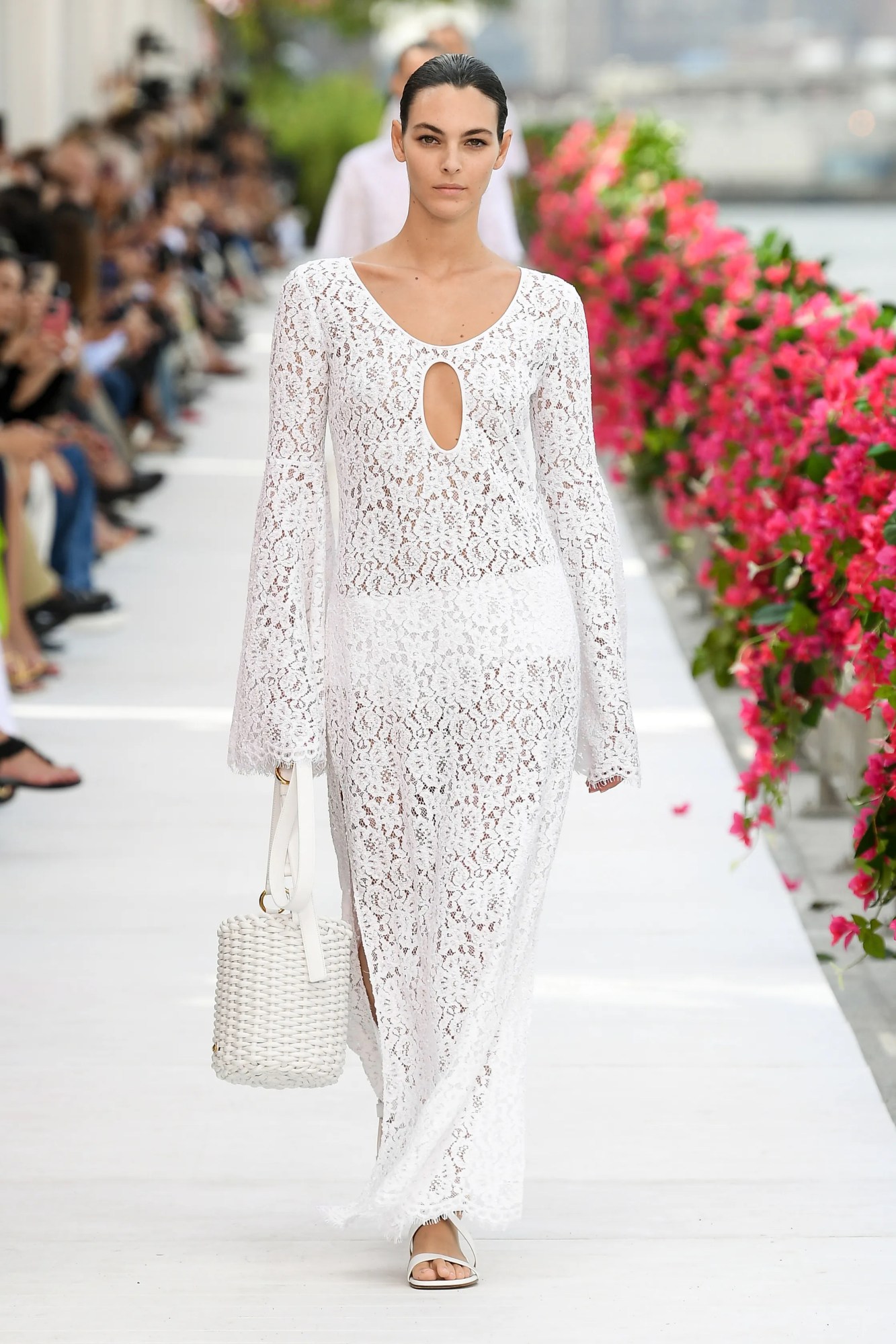
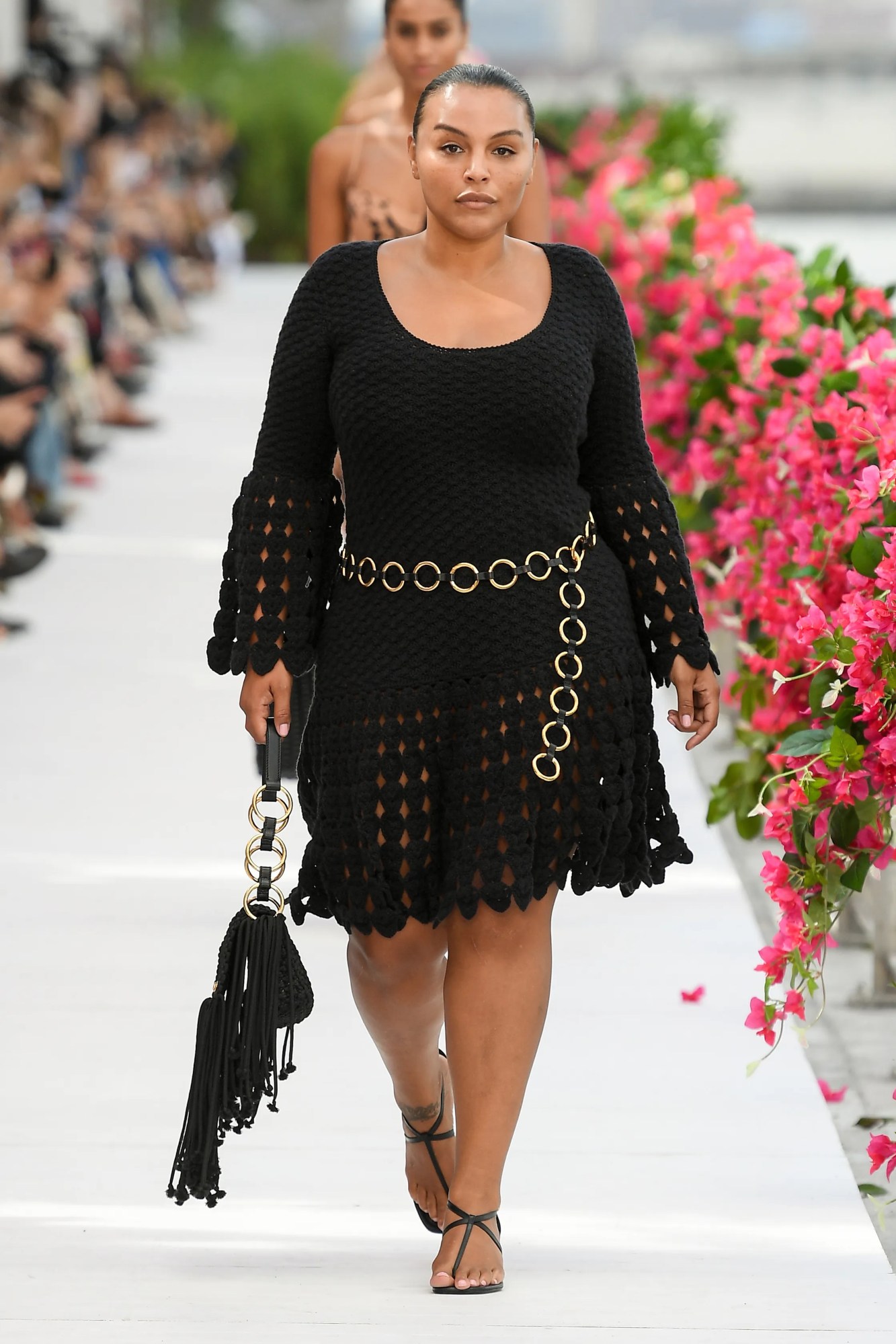
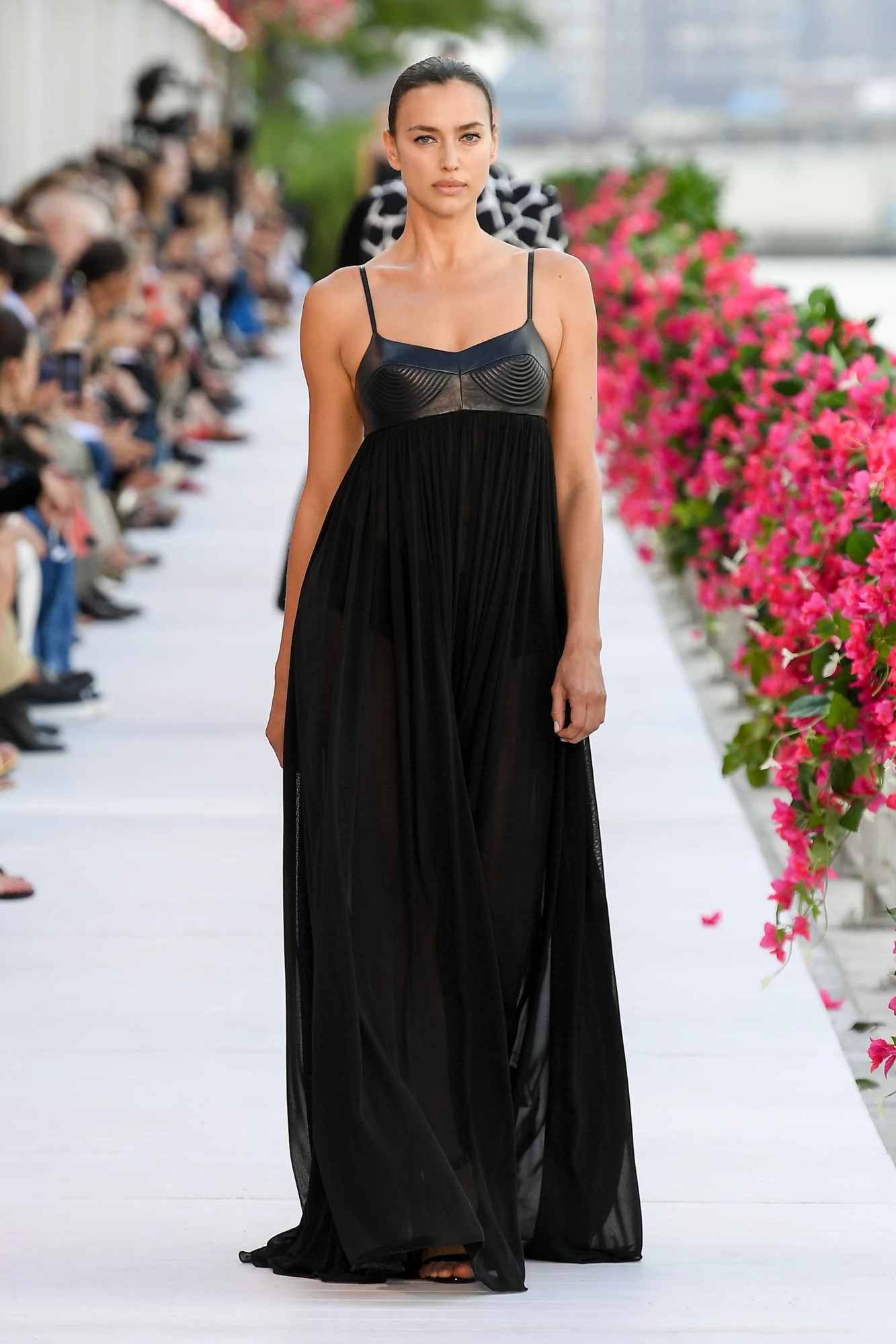
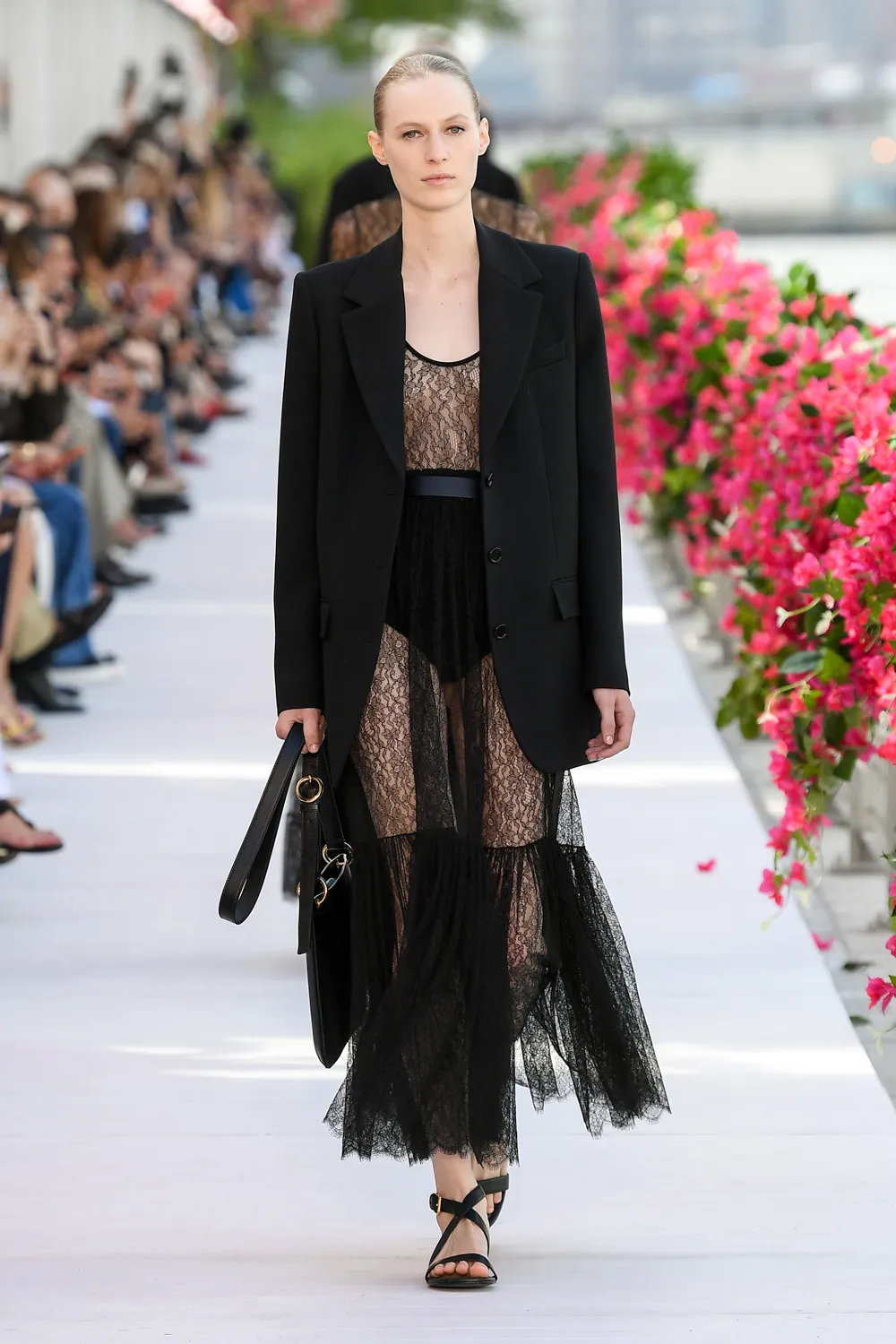
Michael Kors
It was only a couple of weeks ago that we published an article exploring the “return of resort” – basically, the fact that everyone has been dressing as if they’d spent the summer bobbing about on a yacht off the coast of Capri, even if the furthest they managed to make it was Camber Sands. In any case, gauging by the collection that Michael Kors just fielded here in New York, we’re pretty sure that the legendary designer read it and took note.
“From Saint Barths to Saint Tropez, Capri to Cali, Sydney to Singapore,” as the show notes read, this was a sartorial ode to the refined art of holidaying – in particular, to the many trips Michael embarked on with his recently late mother. Fittingly for a show that sought to channel the cinematic glamour of a chic holiday, it was presented against the postcard backdrop of the Manhattan skyline, as seen from the East River’s Brooklyn banks. Underpinning the collection was, as you can expect, lots and lots of floral lace — mostly in an elegantly restrained palette of taupe, white and black, with pops of pink and shimmering gold foil here and there. Among the garments confected from the oh-so-summery fabric were louche kaftans, cropped shirting and abbreviated empire dresses with trumpetting sleeves. Diaphanous crepe shift dresses and ab cut-out swimsuits with chain hardware detailing conveyed a holiday-ready insouciance, with these more sultry silhouettes counterposed by the cosiness of a bulky sweater in mauve mohair – the kind of thing that would be indispensable on a blustery British beach holiday – and the evening-y rigour of razor-sharp double-breasted tailoring and softly pleated jersey gowns. And that’s our summer 2024 wardrobe sorted! MS
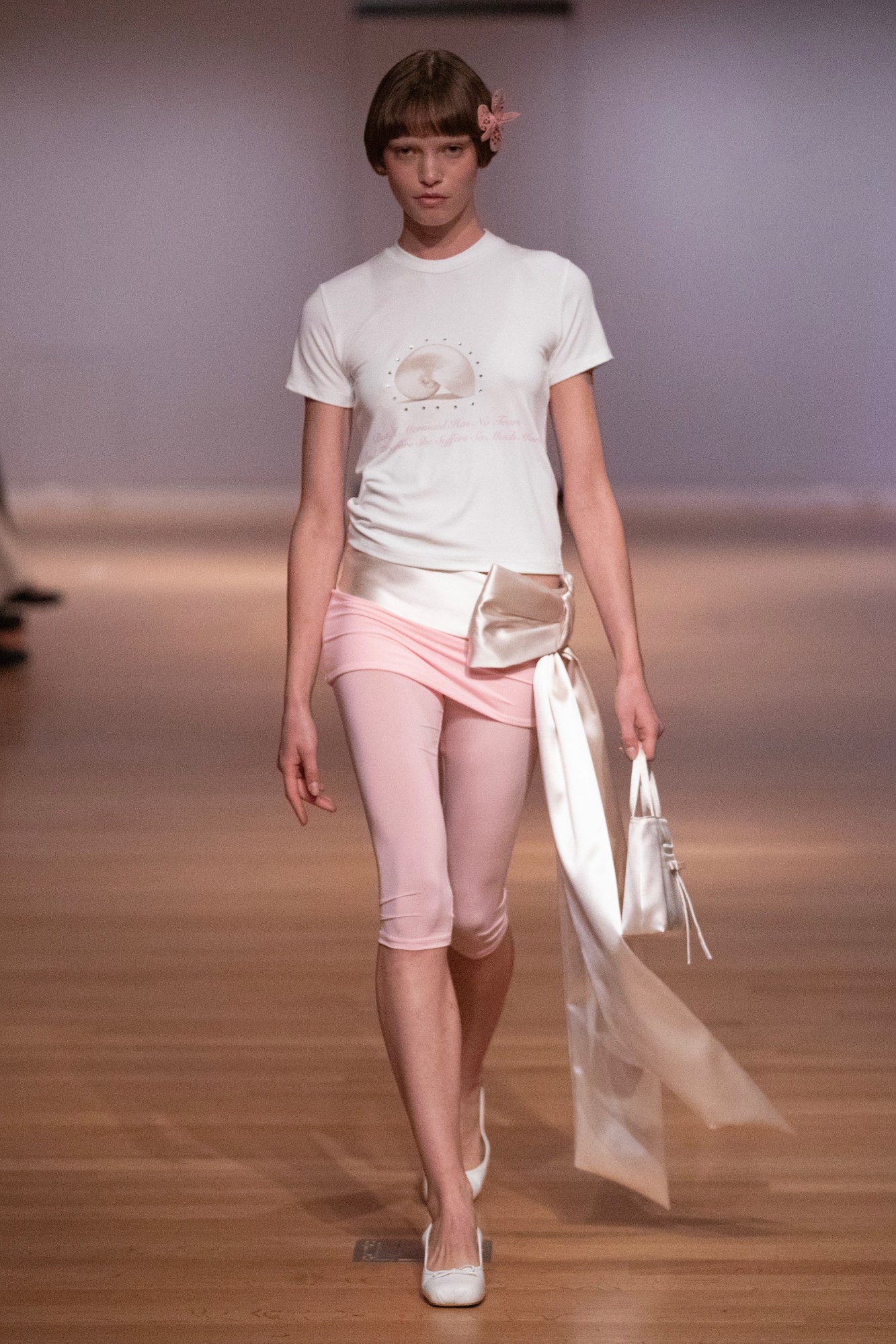
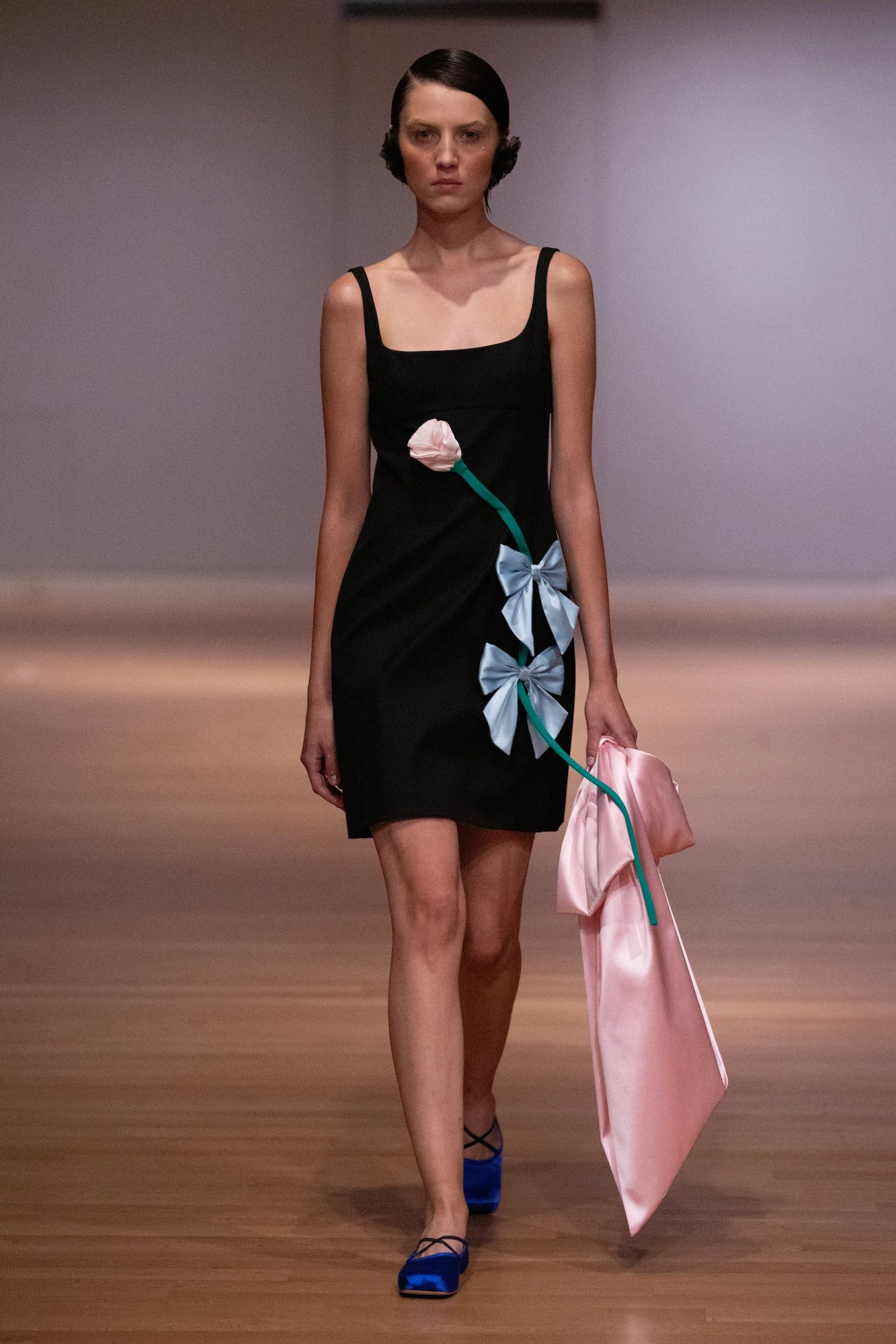
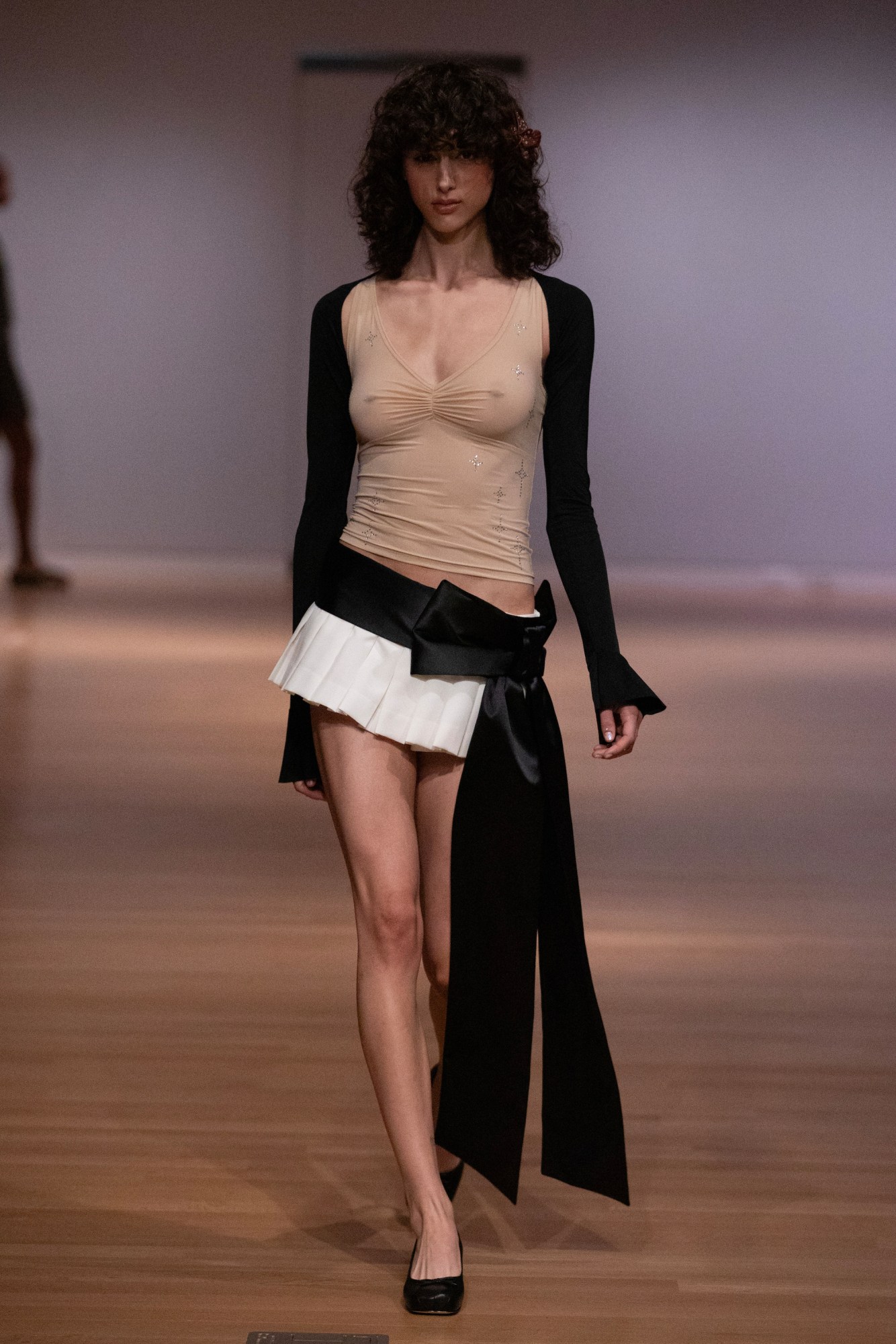
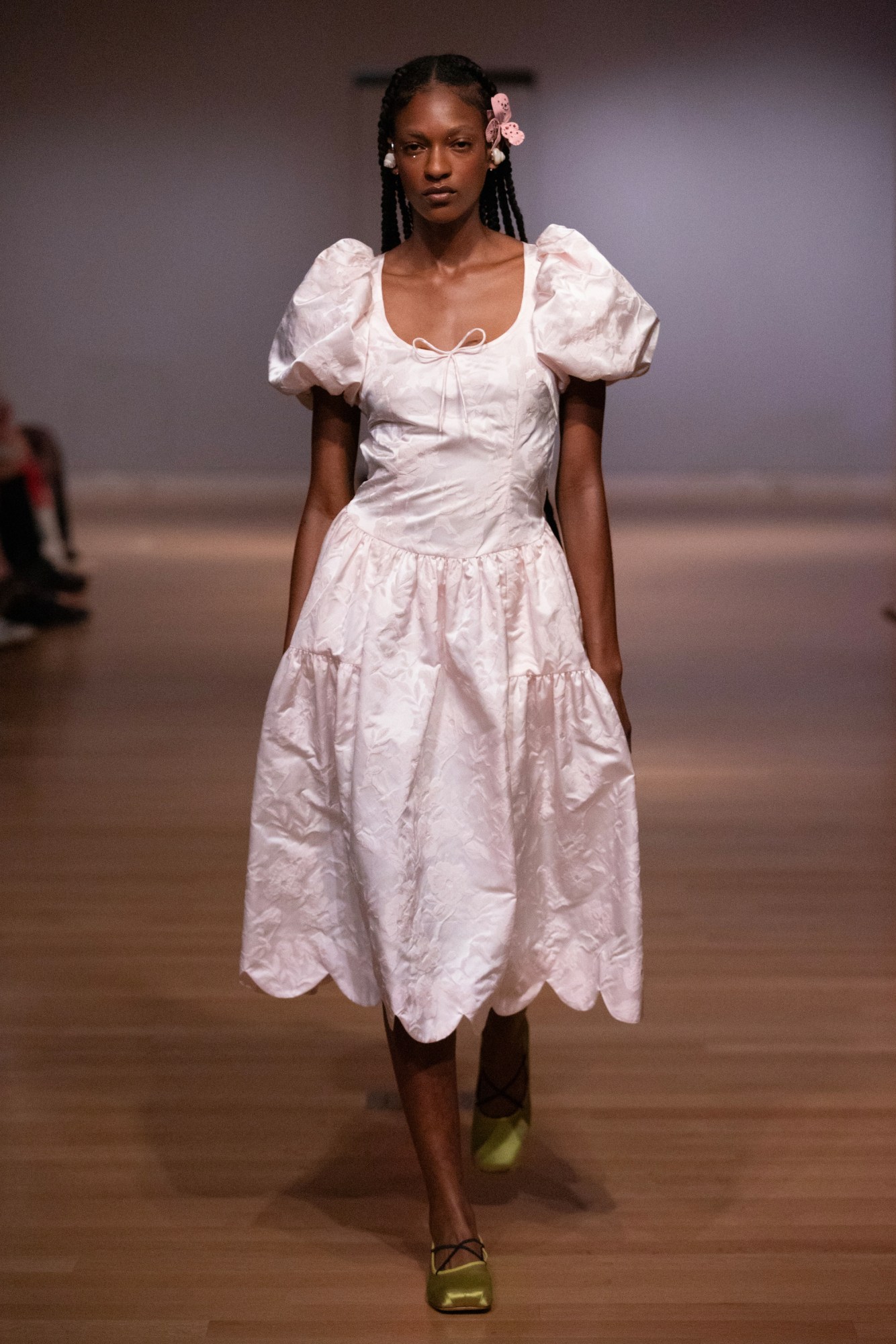
Sandy Liang
Sandy Liang launched her namesake label in 2014, and quickly became a cult downtown designer known for her saccharine, Sofia Coppola-inspired collections. But flash forward to present day and one quick look at TikTok – where store visit videos, hair ‘how to’s’ and even moodboards of the designer’s own wedding go insanely viral – or her frow, all done up in her signature, oversized satin bows, not to mention her impossible-to-cop collaborations with Salomon and Baggu that sell out in literal seconds, indicates she’s transcended this label and more.
Even rain couldn’t stop Sandy Liang’s SS24 show on Sunday, which was held uptown at the Cooper Hewitt Museum, and had to be moved inside at the last second. Her girls quickly rushed inside to avoid the showers, heading into the Upper East Side mansion in pastel-hued packs. For SS24, the designer looked to photographs of similarly-dressed girls and women, “uniform dressing across time and cultures” and even unconscious dress codes, “how they collectively and communally express a sense of belonging”, to evolve the SL uniform.
The Sandy Liang girl “wears a delicate dress, and her buttons are mother-of-pearl, yet her hair is always wet, and there is dirt under her fingernails. She tucks a flower behind her ear before chasing after bugs, the ribbons and sashes of her dress trailing behind her,” the show notes read. “She is too immersed in the wonders of her own world to long for the past, and she’s far too playful to know regret. She’s never understood the purpose of a phone, but why would she when her magical shell holds all the sounds of the ocean?”
Aspirational in heart and mind, but also sartorially, SS24 sees light lycra-like mini skirts, capris and flared trousers, often worn layered, low-rise, pleated bermuda shorts and tied short shorts, as well as graphic T-shirts and jewellery with shell motifs hit the runway. It’s a little mermaid, a little off-duty Virgin Suicides in the frilled dresses or silk toile skirts, worn with a new square-toed ballet flat or Teva flip flops. There are lace and taffeta puff sleeve dresses, sheer and with rosettes, accented by five new bag styles – all giant bows, whose tendrils hit the floor, designed to “blur the distinction between bag and decoration”. Between the chartreuse and icy pink iterations and the mini-wedge flip flops, there’s no doubt in our minds that you’ll be seeing them everywhere this season. ND
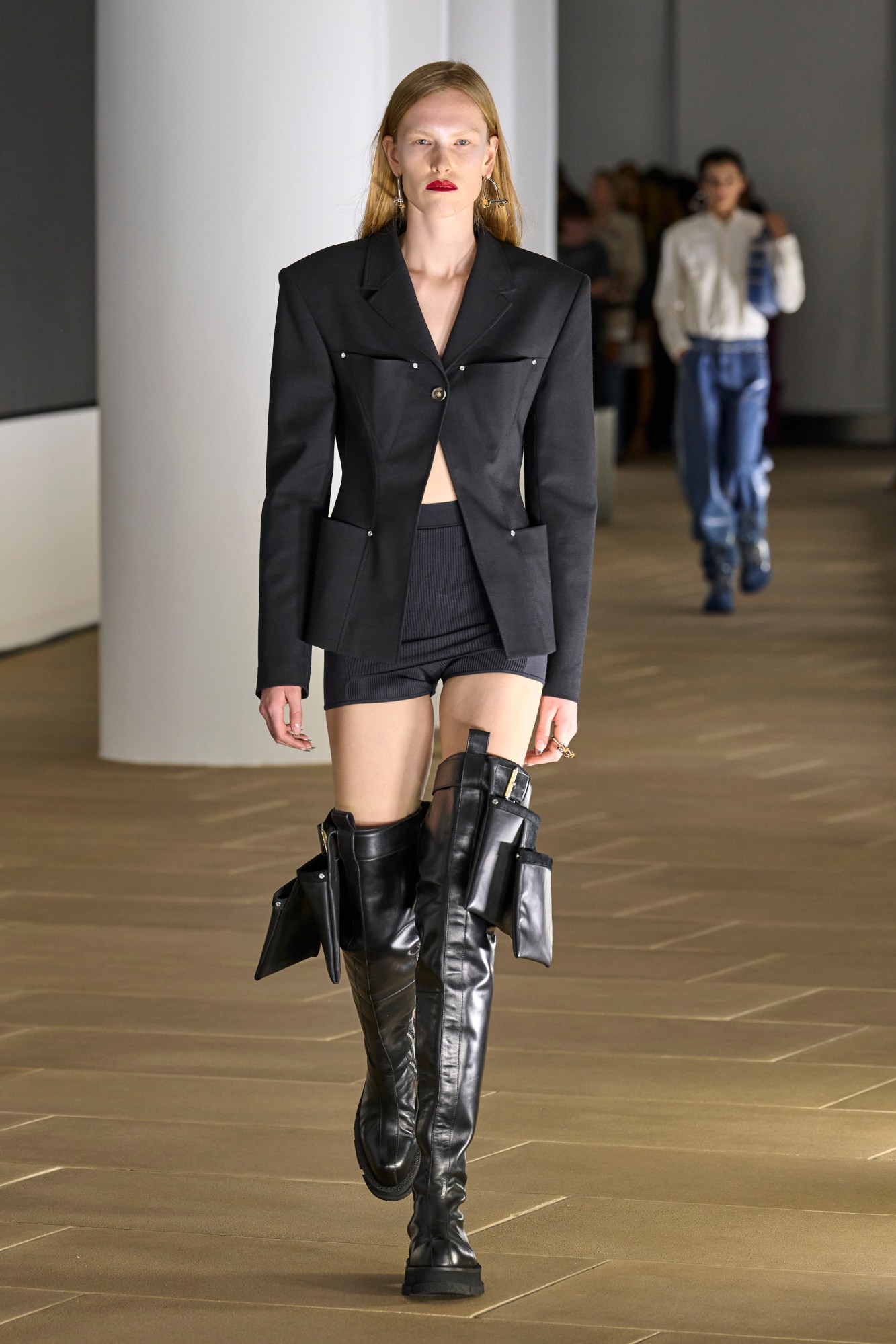
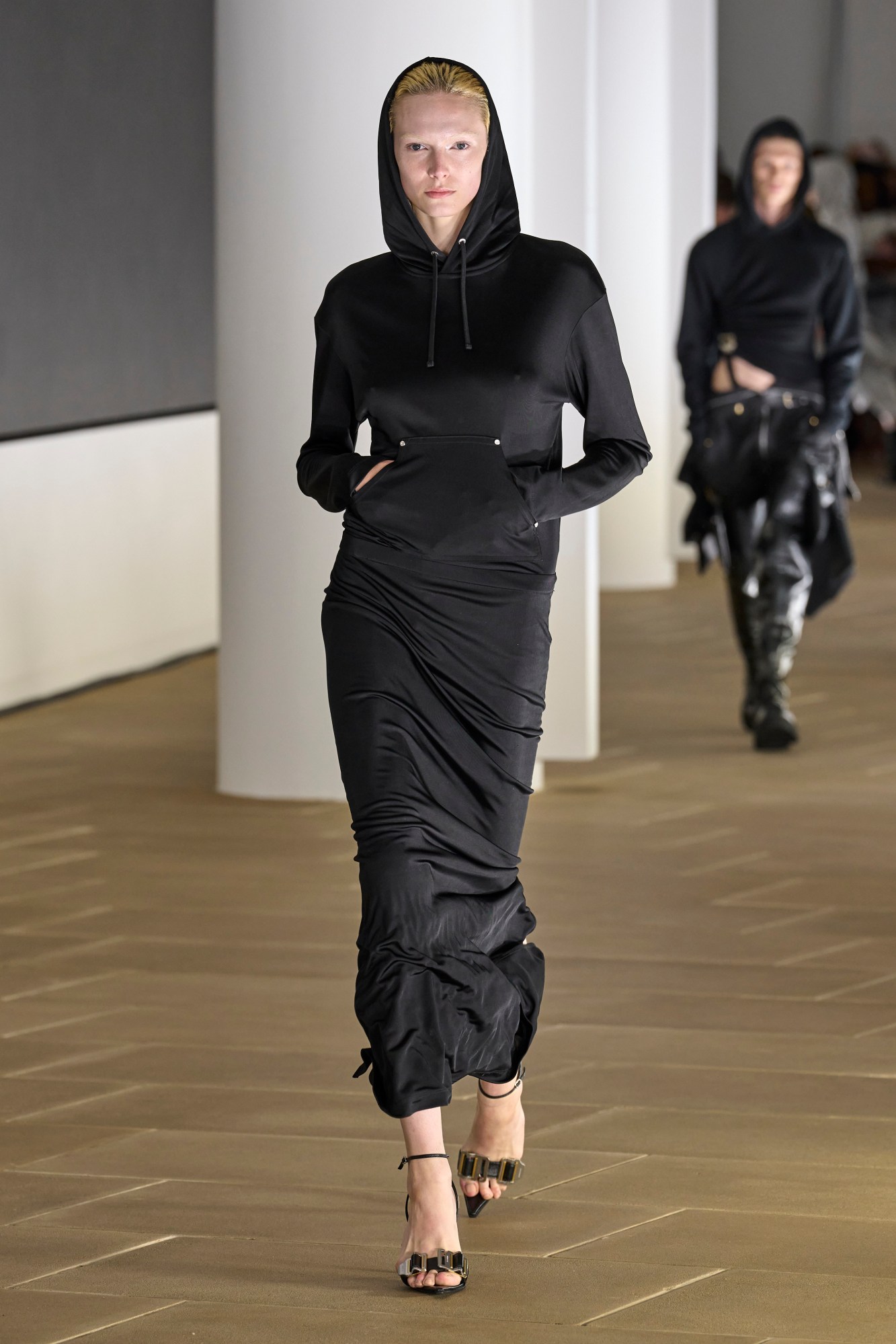
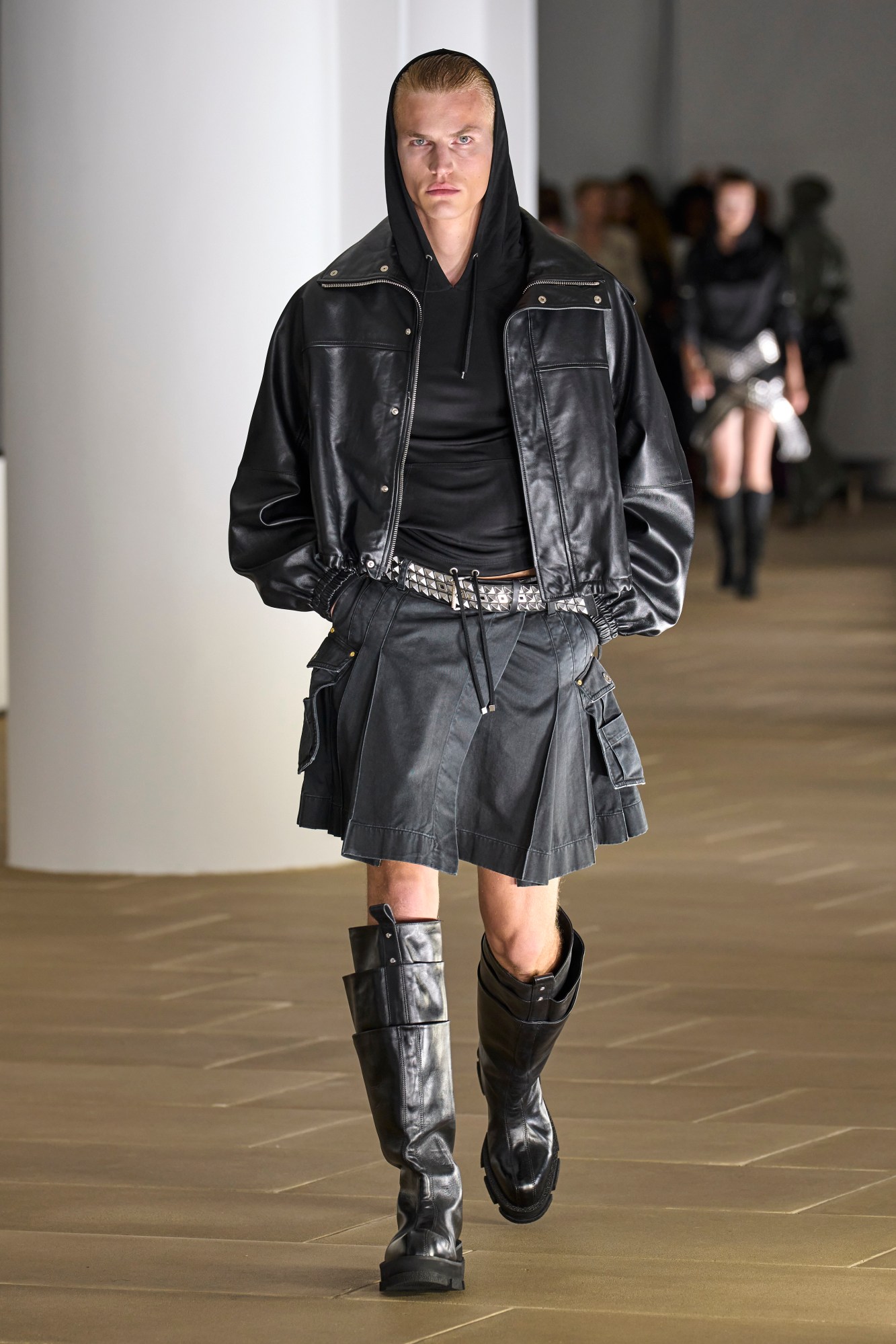
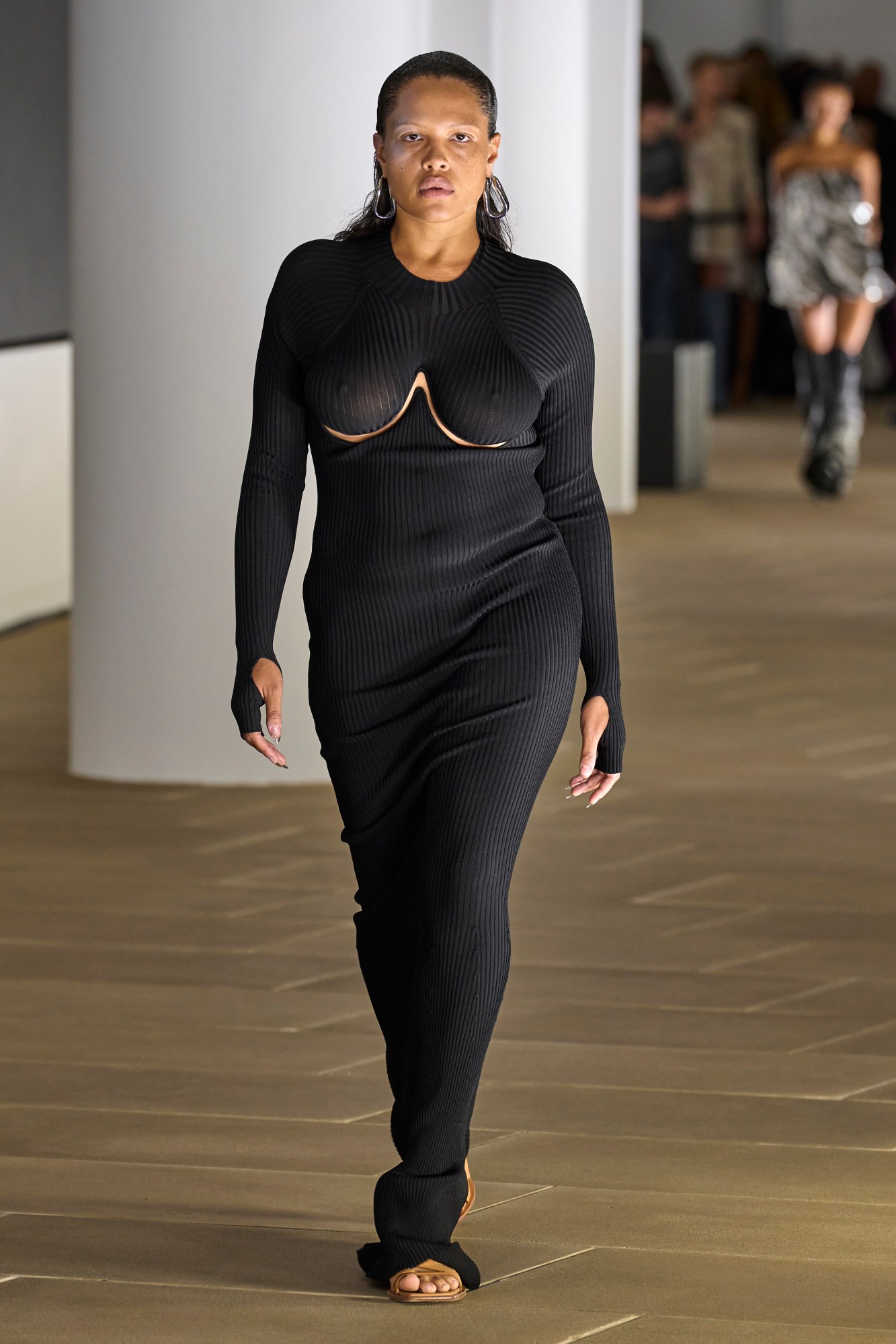
Dion Lee
The crowd that Dion Lee drew for his show late last night is a testament to the designer’s status as a patron saint of New York’s nighttime society. Amid the usual coterie of world-weary editors, buyers et al were a throng of gleefully eccentric club kids — dolled up as much for the Ice Spice-starring, post-show rager that took place just around the corner as for the show itself — as well as a clique of party-hardy celebs like Diplo and Lourdes Leon.
As such, even before the first look stepped out onto the runway, it didn’t take too much to glean what sort of things lay in store. Backdropped by a sprawling video installation by prolific American digital artist Jacolby Satterwhite, what filed out onto the runway was an exploration of “the language of utility and construction,” though, granted, not the sort of stuff you’d want to wear on an actual construction site. Rather, in characteristically queer fashion, the vernacular of construction gear was fetishised, appropriated and transformed into a clubby uniform replete with Dion Lee-isms — think: razor-sharp cuts, waist-snatching corsetry and eye-catching punctuations of hardware.
Tailored silhouettes were constructed with the rigour of a good scaffold, jutting at the shoulder and skimming in at the waist, while more literal invocations of the designer’s chosen source material came by way of buffed leather tool belt bags, canvas cargo wrap skirts, a Timberland-brown corset replete with a black leather trim and plenty of Troye Sivan-coded undone overalls. Indeed, there was much on offer here for those that feel the rush — itsy-bitsy denim bralettes and brawny tank tops with glinting steel wire straps — but, refreshingly, the heavy-handed referencing did give way to pieces like the resplendent, gauzy gowns that closed out the show, as well as the eminently desirable layered clodhopper boots that anchored looks throughout. All in all, while at times a little too literal, it was an offering that attested to Dion’s fairly earned reputation as a construction man — of clothes, that is. MS
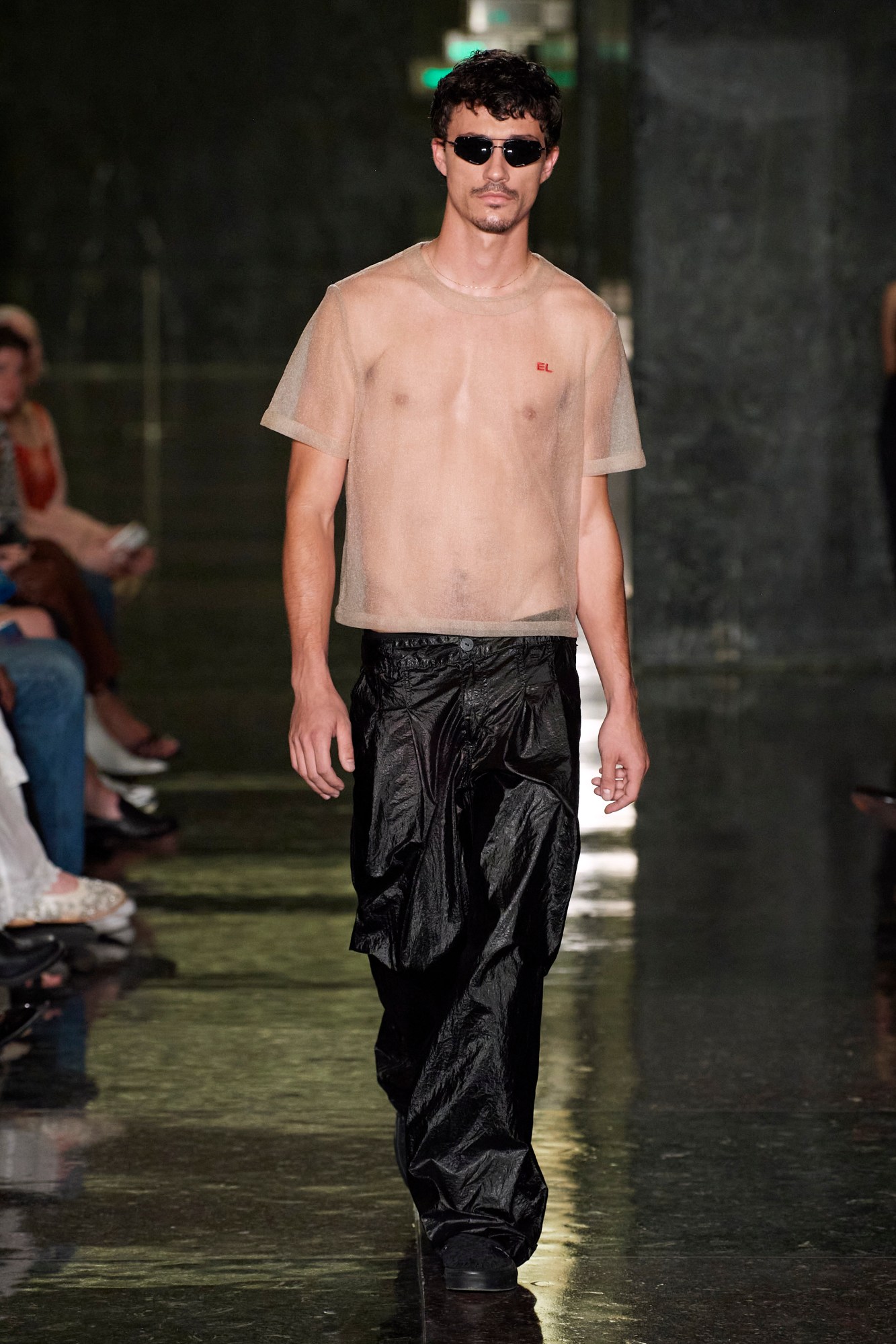
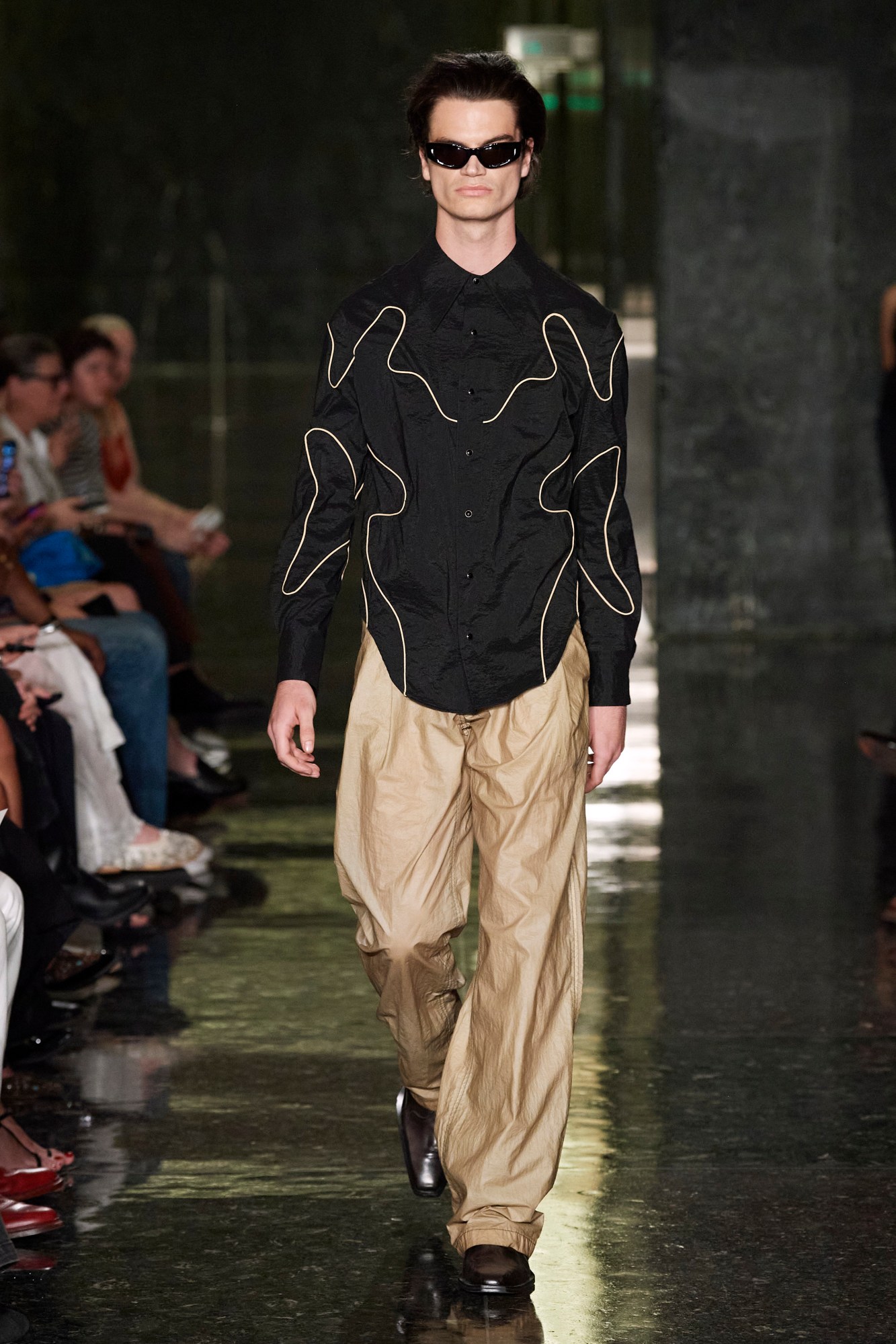
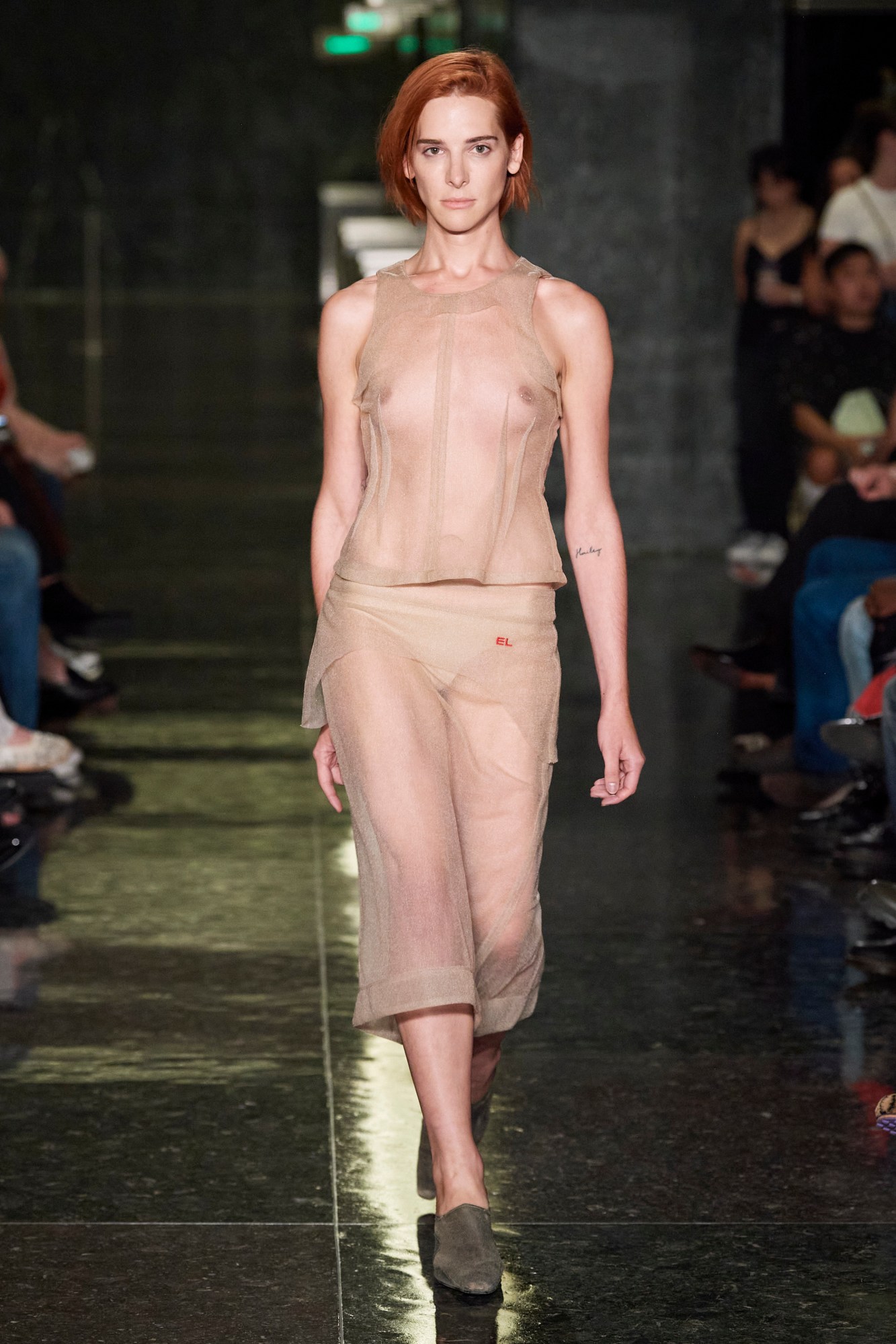
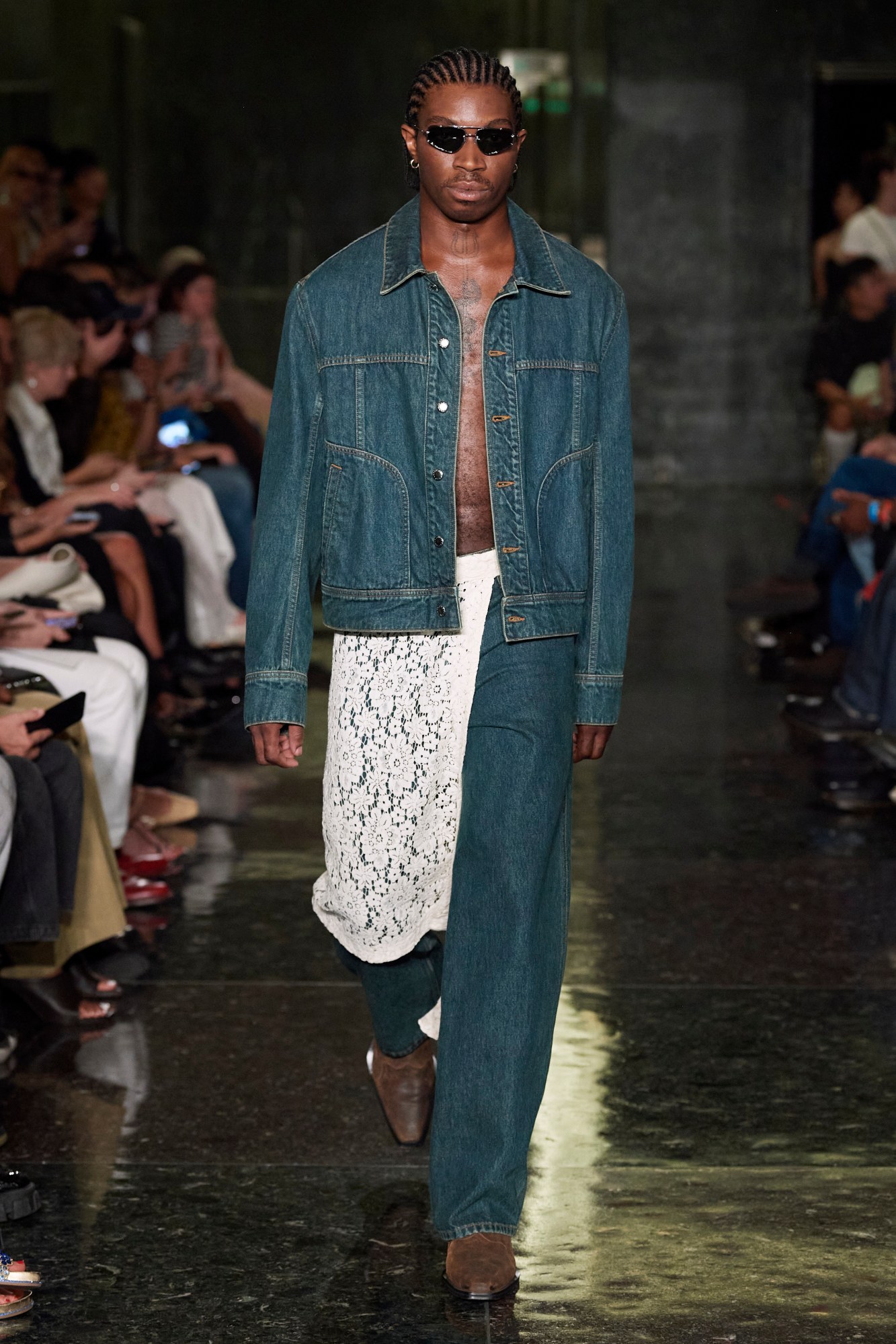
Eckhaus Latta
This week we’ve seen runway shows on rooftops, in public gardens or The Plaza Hotel; there have been SS24 offerings that include performances or even double as performance art pieces, but none of these all-very-good options have brought the drama quite like Eckhaus Latta’s evening show at 45 Rockefeller Plaza. Guests piled into the building’s marble, art deco lobby, taking seats around the perimeter, before models began emerging from the depths, one by one coming up the central escalators.
Those seated in prime viewing areas watched each look reveal itself in slow motion — brown deadstock leather pants and bombers, layered over a sheer, nude T-shirt; a sandy Western tank dress with pointed mules; the label’s first sunglasses with a boxy denim jacket, jeans and lace skirt overlay. The models walked around the room counterclockwise before ascending the escalator and descending once more. While the casting saw a number of Eckhaus Latta’s friends and family return to the runway, including Paloma Elsesser, in black lace separates with lingerie detailing, Hari Nef, Coco Gordon Moore, Susan Cianciolo and more. The latter pair wearing the labels everyday denim in striking green metallic, paired with the kinky sheers we’ve come to expect from the New York and Los Angeles-based fashion brand over the past few seasons.
It’s certainly everyday dressing that designers Mike Eckhaus and Zoe Latta have mastered over the last decade, but it’s the details that elevate circular, chunky knits and wide leg jeans to new heights. This season, that means skirts that zip fully up the front and back, bright red logos front and centre and patchworked, mesh striped pants. The designers’ vision for SS24 is quite sexy, but sharp. These are looks that will make you do a double take on the subway escalator, for sure. For those thinking that New York Fashion Week could use a healthy dose of drama, look no further than Eckhaus Latta. ND

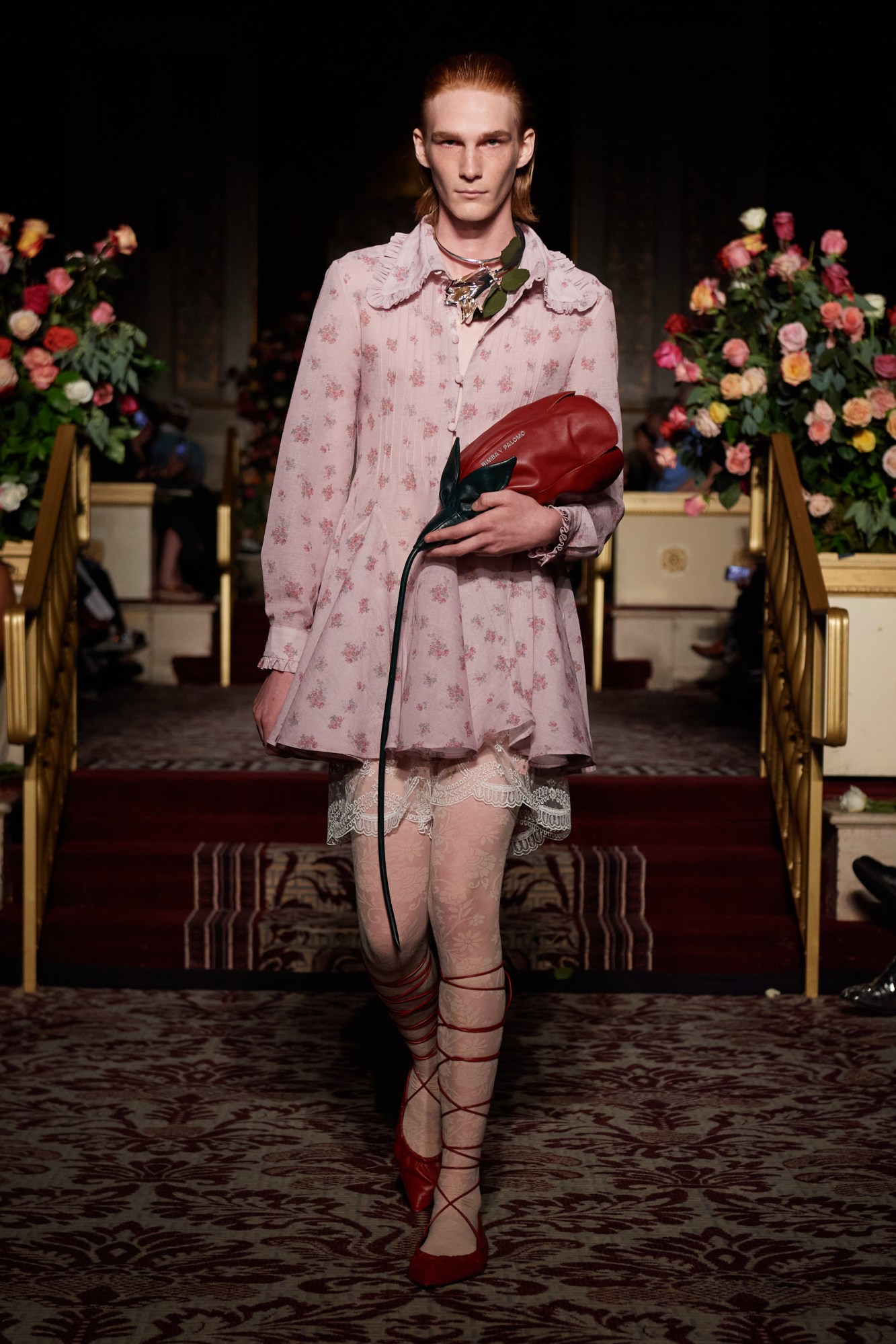
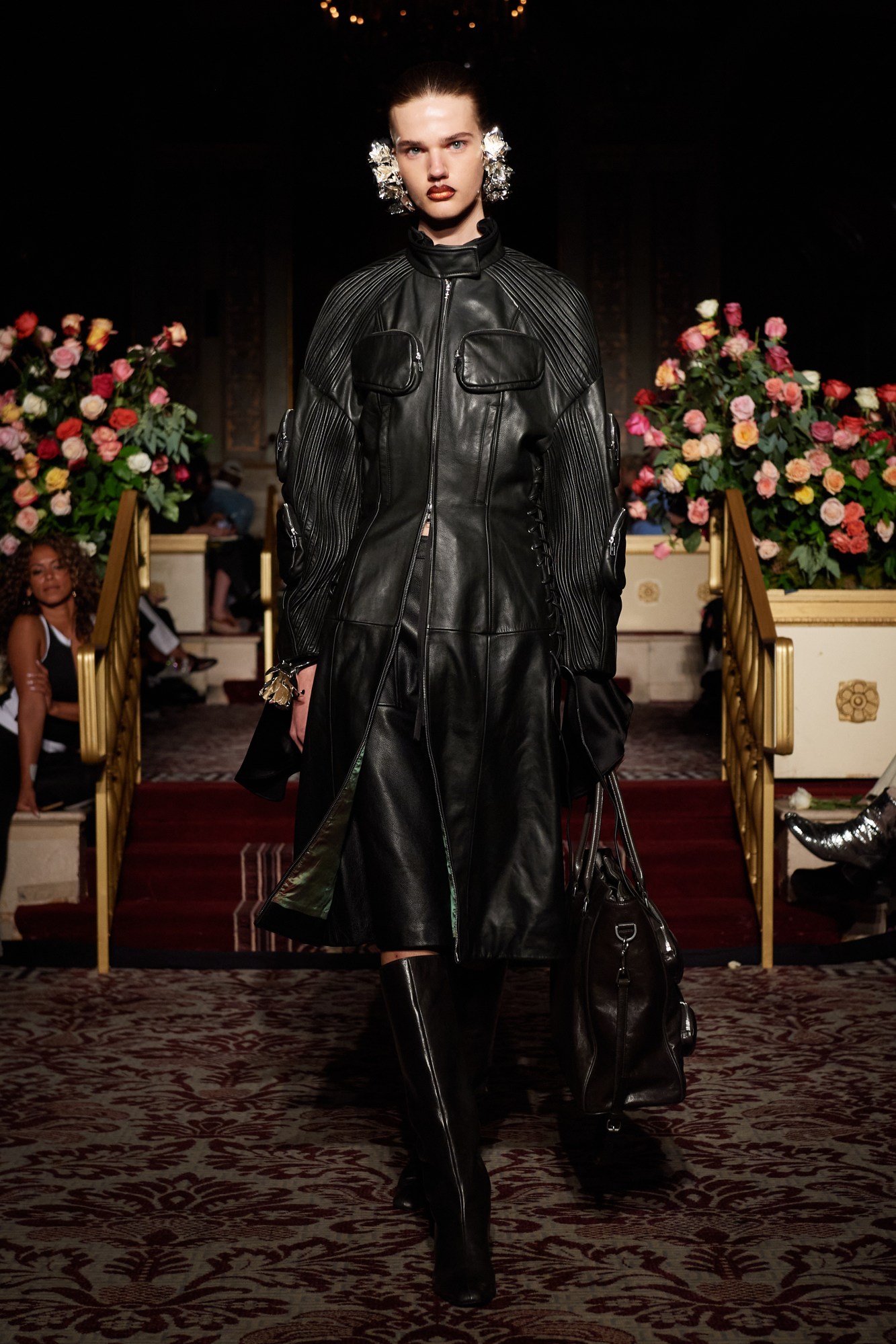
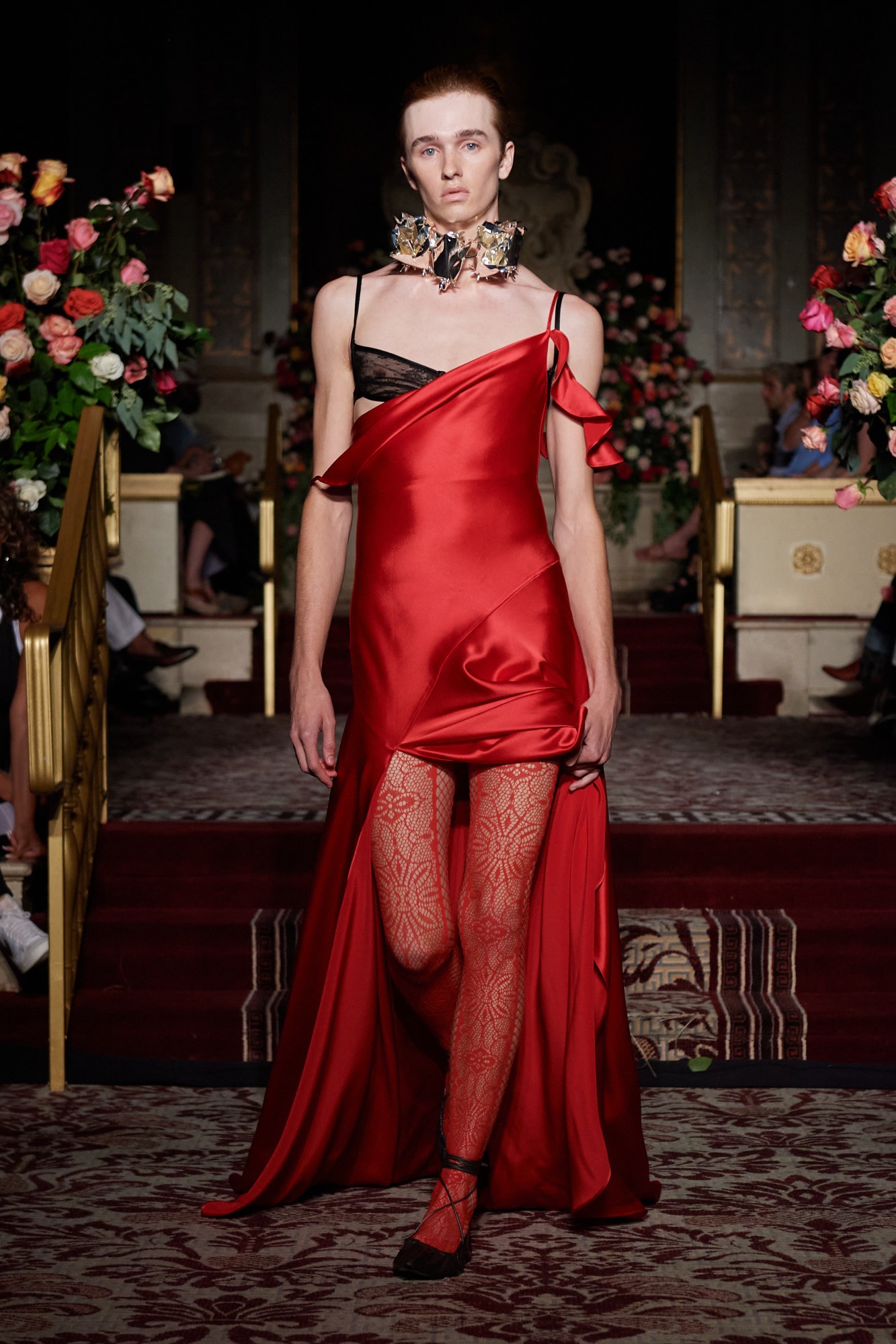
Palomo Spain
This season’s collection took us to an enchanted garden bursting with snaking vines and plush roses, intended for “discreet affairs”, nodding with an obvious wink to gay cruising culture. The show, titled “Cruising in the Rose Garden,” sent models down the runway at a slow and sultry pace, many locking eyes suggestively with audience members. At one point, a model in white leather boots, black leather corset and shorts with an intentionally open drop seat softly caressed the cheek of Moses Sumney, who was seated in the front row.
Alejandro Gómez Palomo found inspiration in “the duality of human desire,” arguing in the show notes that “humans have two sides.” He channelled his exploration of this spectrum through traditionally opposite archetypes resembling angel and devil, “one more animalistic, blinded by carnal desire; and one more romantic, driven by nature and feminine sensuality.” Everyone in the audience was welcomed with a thorny rose in their seat— which also informed an accessories collaboration with Spanish luxury label Bimba Y Lola — delicate, romantic tokens with a sharp edge.
The concept was manifested through white lace, and reworked vintage lingerie patterns from the first half of the twentieth century that read as sexy, yet innocent. There were sheer gowns with sparkling pink embellished roses, baby doll dresses and button-down caftans with sweeping trains in sweet floral prints. One standout look was a sheer lace camisole and matching shorts with drawstrings on each hip, worn over a pair of lowslung pleated denim pants. The model’s arm was wrapped in a snaking green vine, which felt like an ode to the Garden of Eden, where Adam and Eve first learned they were naked.
The latter half of the collection pushed the palette into black and scarlet, featuring silks and leathers punctuated by splashes of denim, rosette detailing and metallic floral sculptural jewellery. One model dressed in a black leather bralette worn with gold laurel-shaped earrings recalled the world of Greek mythology — completed by linen trousers with fur trim at the hips and rear, the look felt almost centaurian. It was all about being more than one thing at once, free from the limits of binary definitions. AT

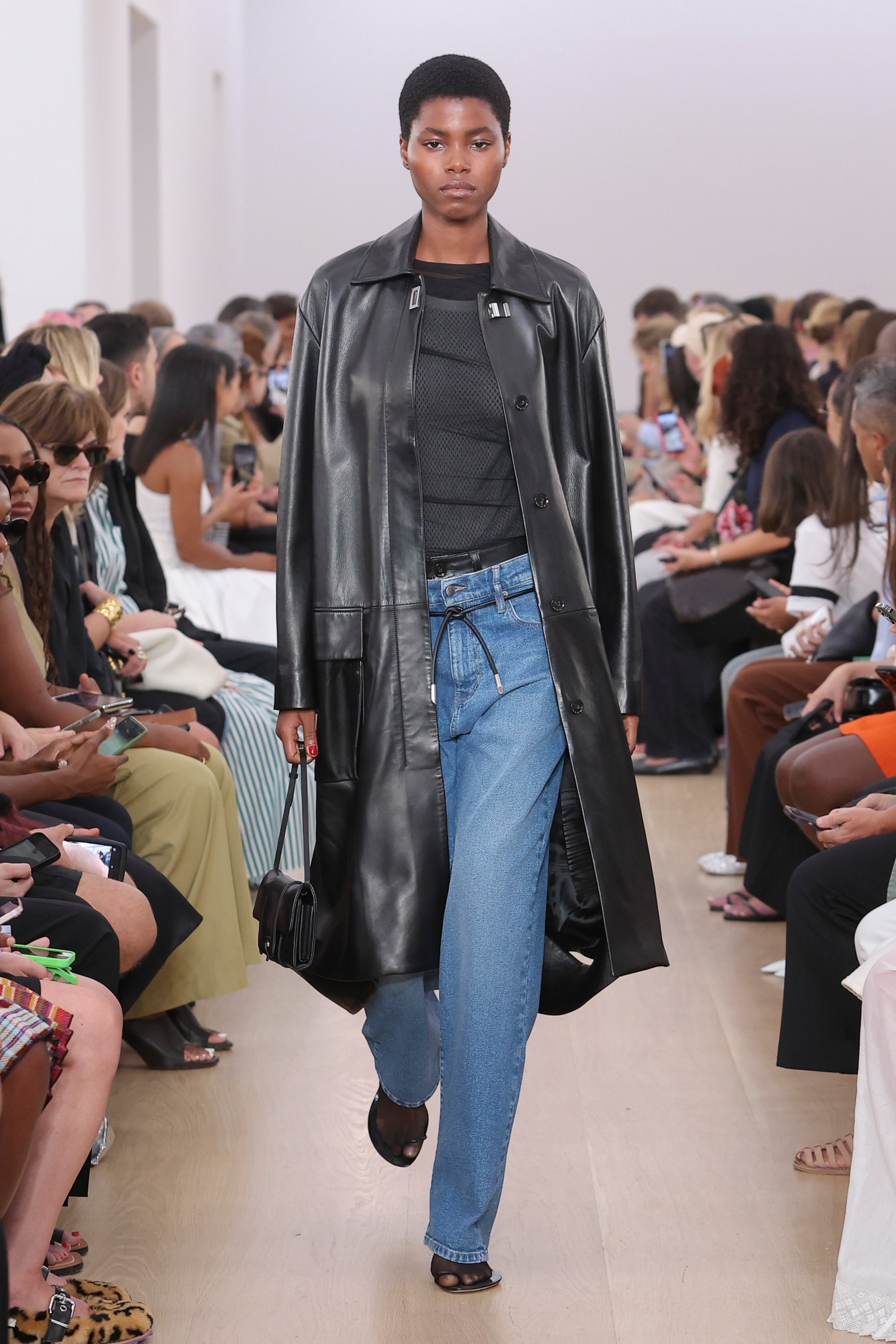

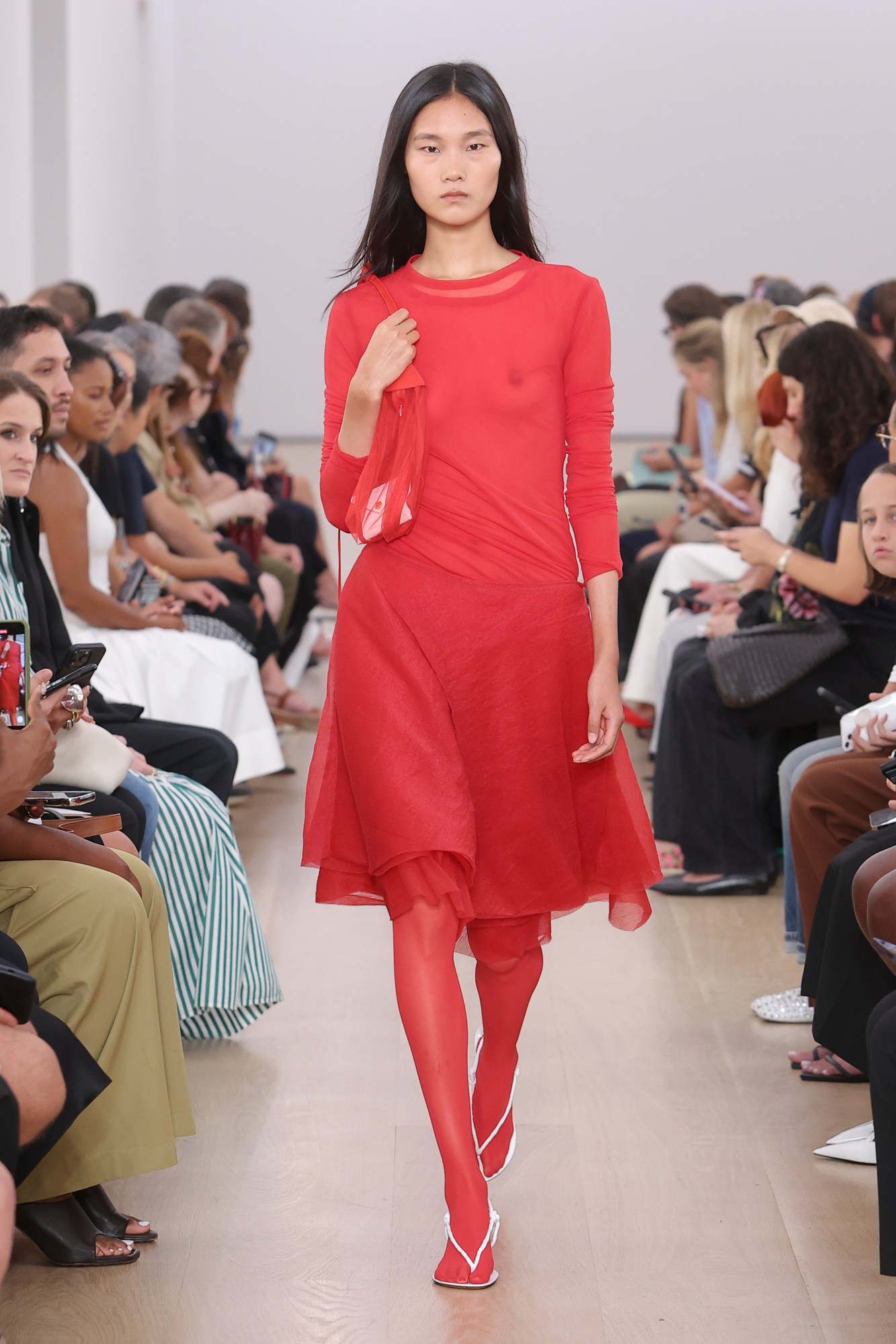
Proenza Schouler
Last season, Proenza Schouler fêted 20 years of the New York label by pulling back the curtain – literally, by bringing the buzz of models dressing backstage with a transparent screen; and figuratively, by returning to the very style codes that put them on the map. Crowds dressed in stark black and white tailoring, seamed square neck dresses and separates – count Hari Nef and Rachel Sennott among them – filed into the Phillips Auction House where designers Jack McCollough and Lazaro Hernandez presented an SS24 collection that further cemented this approach.
Natalie Laura Mering, also known as the musician Weyes Blood, opened the show to music she’d composed for the occasion; its surreal underwater synths, echoing those on her 2019 album Titanic Rising, adding a sense of fluidity to the way the garments floated down the runway. There were several standout tailoring moments, featuring blazers tucked into trousers and belted and wool jackets worn over bleached jeans, but eyes were drawn to light, transparent knits and pleated, sheer drawstring dresses that swirled across the waist or nylon-like separates that twisted into each other. “A lot of those tops are cut so when you put it on it twists and wraps around the body,” Jack said backstage. “There was a nonchalance… an undone quality. The makeup is always easy. We wanted to have the clothes to have that same easy quality, like they were just tied at the back,” Lazaro added.
Similarly, long sleeve knit dresses featured removable sleeves that could be tied across the chest mimicking a sweater around the hips, and belt bags cinched waists, while mesh iterations were effortlessly tossed over shoulders. A shimmering “broken glass” dress and tie skirt added a necessary glitz to the offering, among supple leathers, loads of denim and two sleek monochrome looks, as well as the cashmere pullover featuring the new Proenza Schouler monogram. Though it took three years to come up with the minimalist PS symbol – backstage, Jack and Lazaro said that they scrapped design after design, constantly starting over – everything fell into place when they returned to the label’s core practice, finding beauty in simplicity. ND
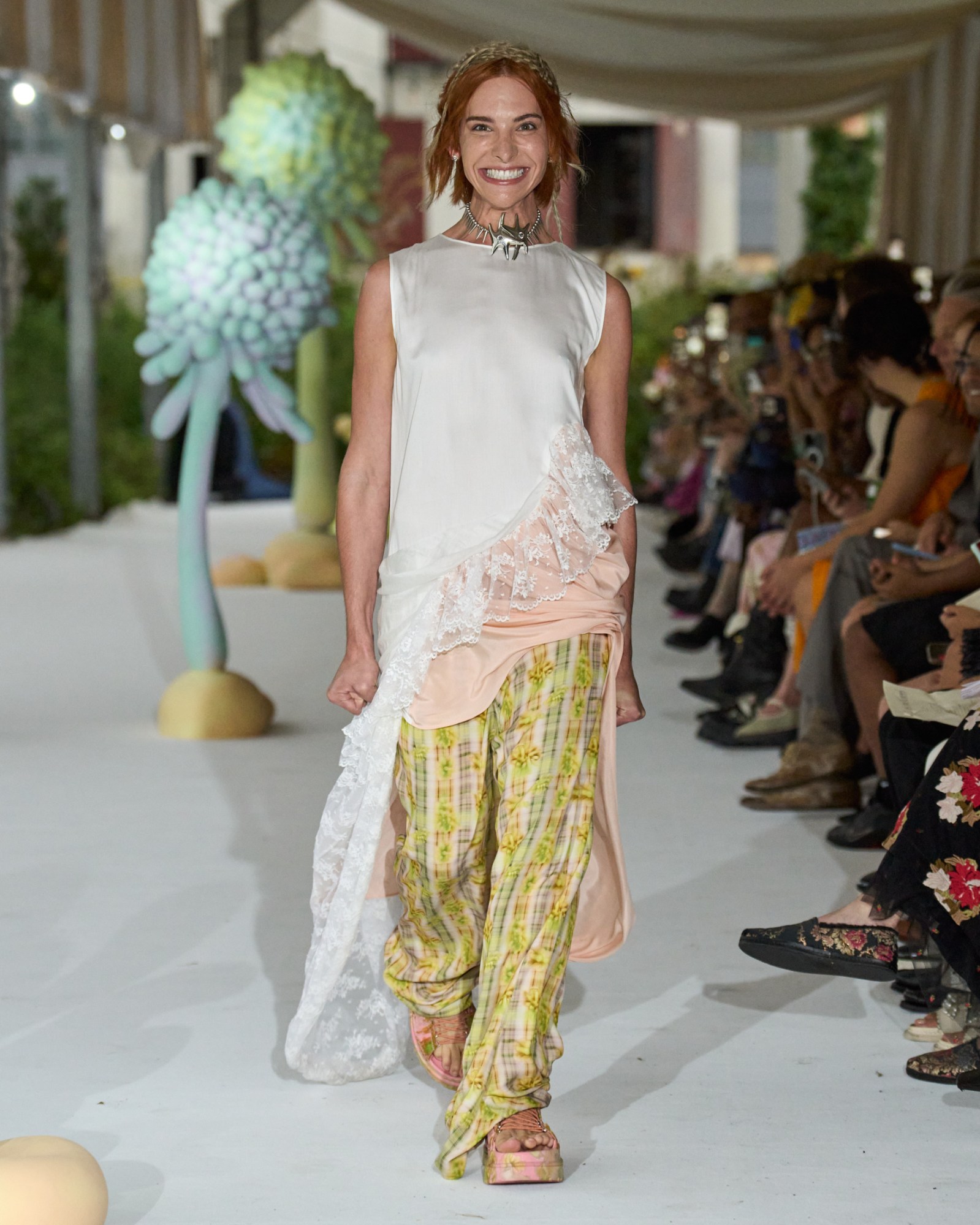
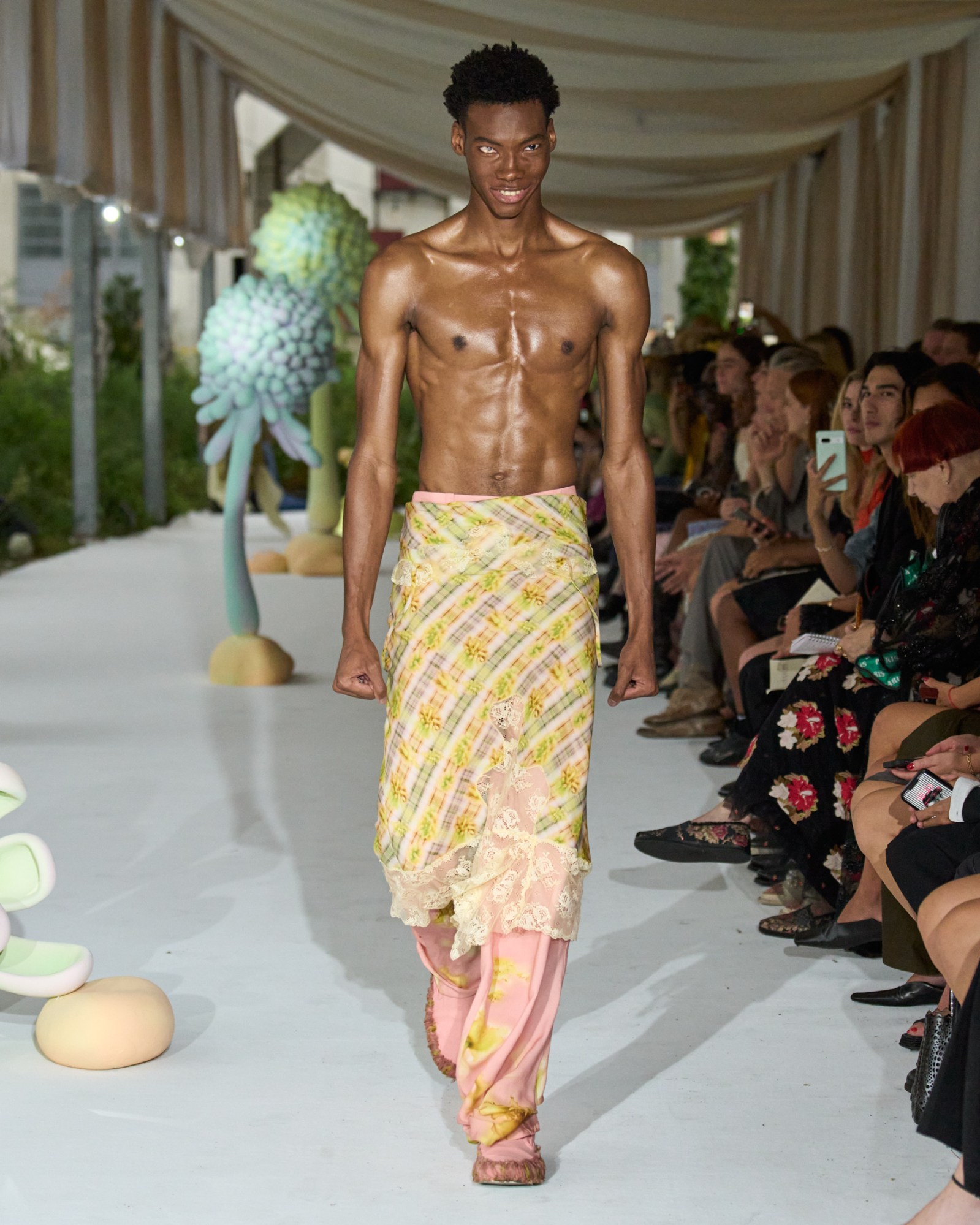
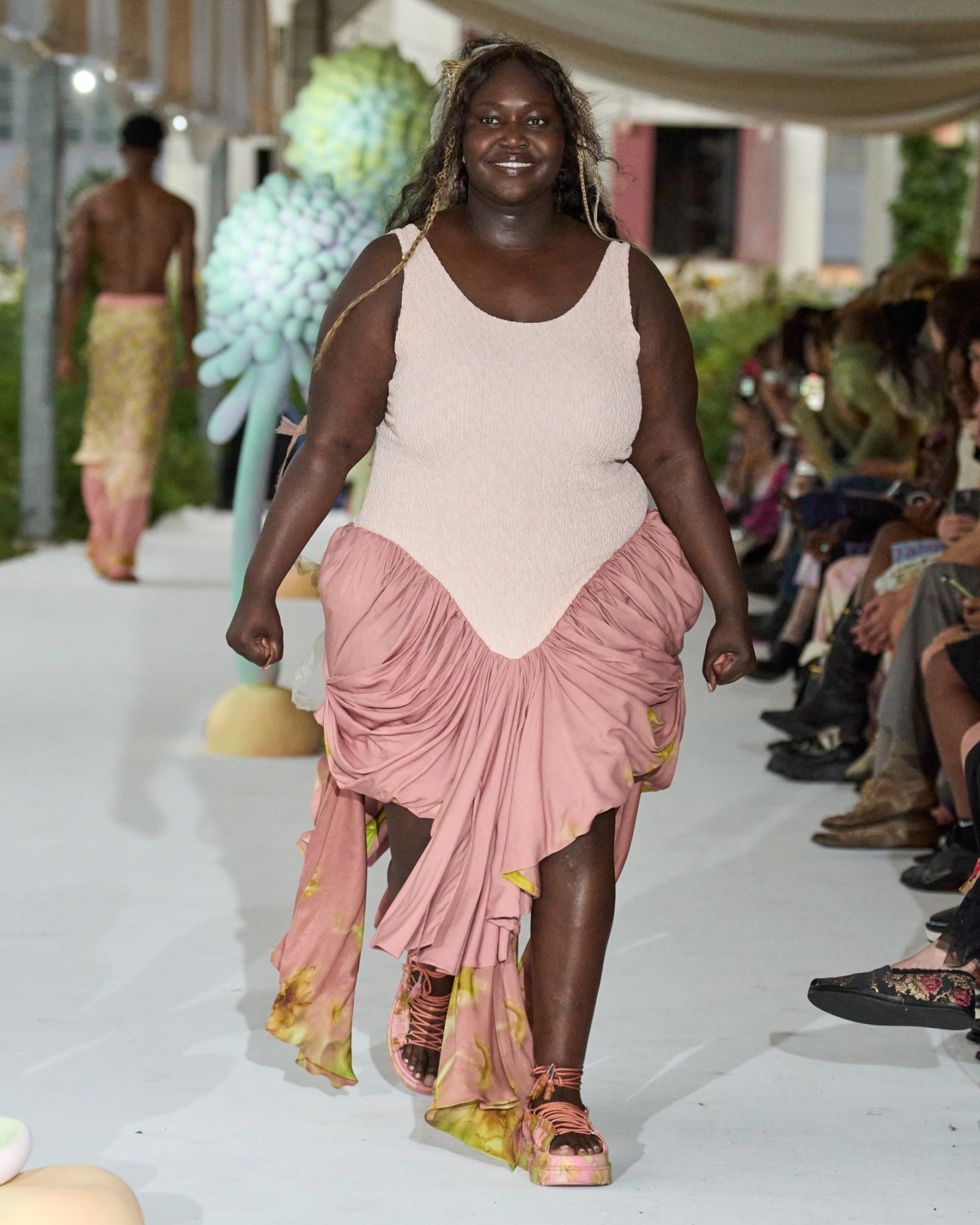
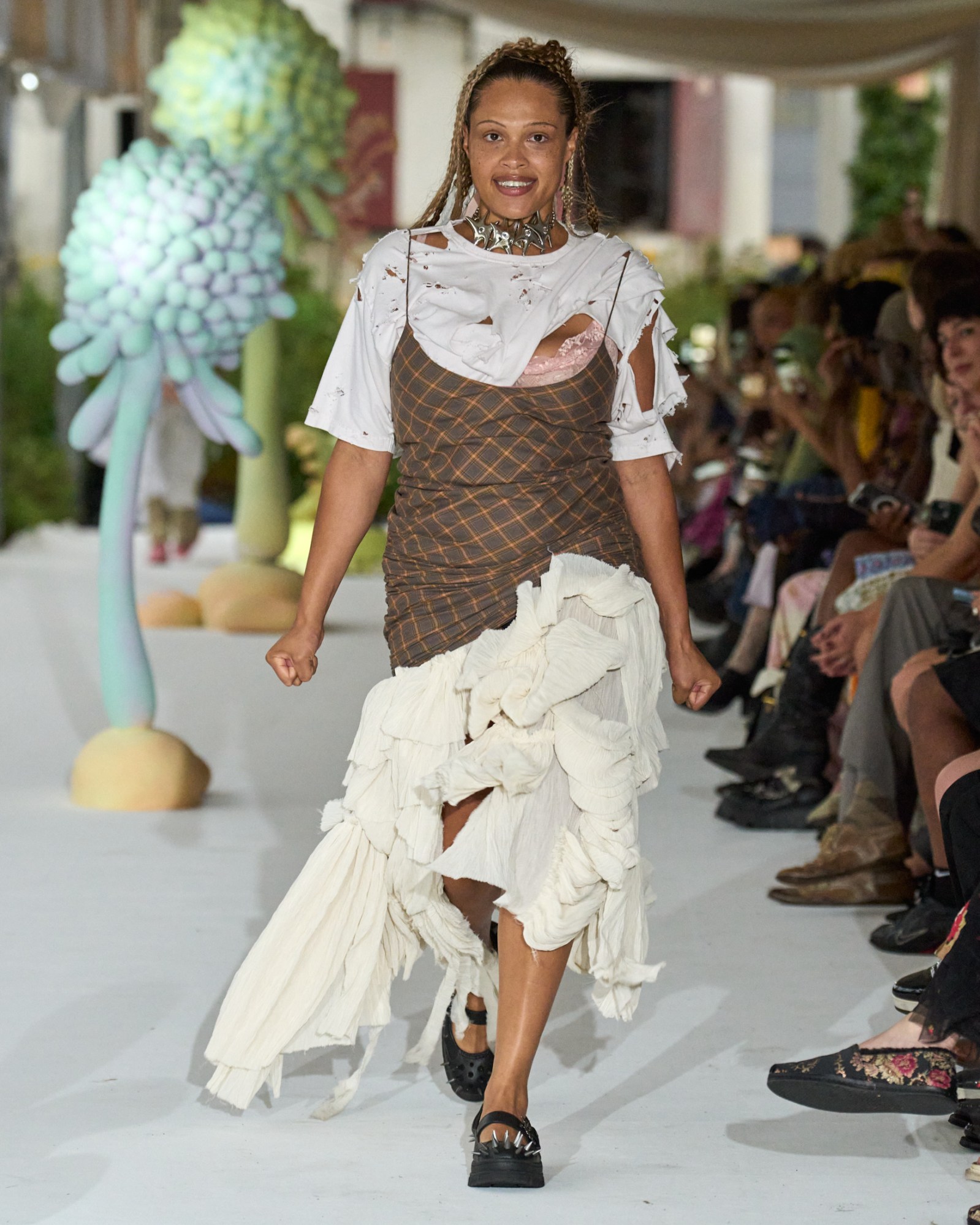
Collina Strada
As has now become customary for Collina Strada, this season’s show began to the tune of an original soundtrack. Model and musician Jazzelle Zanaughtti — best known by her handle @uglywordwide — skipped onto the runway, performing a joyful ribbon dance as Elizabethan-esque music blasted through speakers on the garden rooftop of The Brooklyn Grange. A voice could be heard singing “Why are we here, earth’s on fire,” as models walked out with forced, exaggerated, almost disturbing smiles. Upon reaching the end of the catwalk, they dramatically reversed their expressions, switching smiles for scowls.
Hillary Taymour has always centered climate consciousness in her design storytelling, and this season, too, was a clear meditation on a climate crisis that in recent years has gone from an impending threat to a fully active emergency. The show notes, printed on recycled paper, read: “As we grin and bear the excruciating present, in which the world burns and reproductive, trans, and general human rights are under threat, we summon the strength of radical softness to defend ourselves.”
Setting the intention to “reconnect to the universal feminine,” the collection summoned “Mother Earth” through “diaphanous details, frilly nourishes,” and “wearable corsetry”. Flowing, ethereal satins, ruffled hems and familiar buttressed shapes complemented the aforementioned corset moments, which were rendered in mustard plaids, blush pinks, gauzy nudes and muddy earth tones. A particular standout was a midnight black velvet corset dress featuring a dove white folded underskirt, decorated playfully with peach chiffon scarves. The destructive side of Mother Nature was also reflected here — most clearly in tattered and twisted t-shirts, shirred hems, and sexy, deconstructed, silk blouses and gowns layered chaotically with cargo pants. The label also previewed an upcoming collaboration with Uggs, imagined as bulky platform gladiators and spiky, Croc-like Mary Janes.
With a distinctive cast, including Hari Nef, brand bestie Tommy Dorfman, Rumer Willis and King Princess (who both walked and performed at the end of the show), this was an entertaining and contemplative start to the season. AT
Helmut Lang
Yesterday, Peter Do presented what was easily the most anticipated show of New York Fashion Week — his debut for Helmut Lang. A simultaneous meditation on the senses of safety, luxury and insularity offered by cars — particularly as perceived from a queer perspective — and on what today’s archetypal New York wardrobe would like, the esteemed designer presented an eclectic offering that he described to us as “a system of dressing”; an interchangeable ensemble of outfits that include lean suiting with poppy seatbelt trims, fluid, draped crepe dresses, bulky, boulder-shouldered leather jackets, and tank tops and reverse constructed shirts printed by fragments of poetry by Vietnamese-American writer Ocean Vuong. Ahead of the show, we stopped by the Helmut Lang studio, where Peter gave us the full lowdown on the collection, and his plans to make Helmut Lang New York’s most emblematic brand. Head here to read. MS
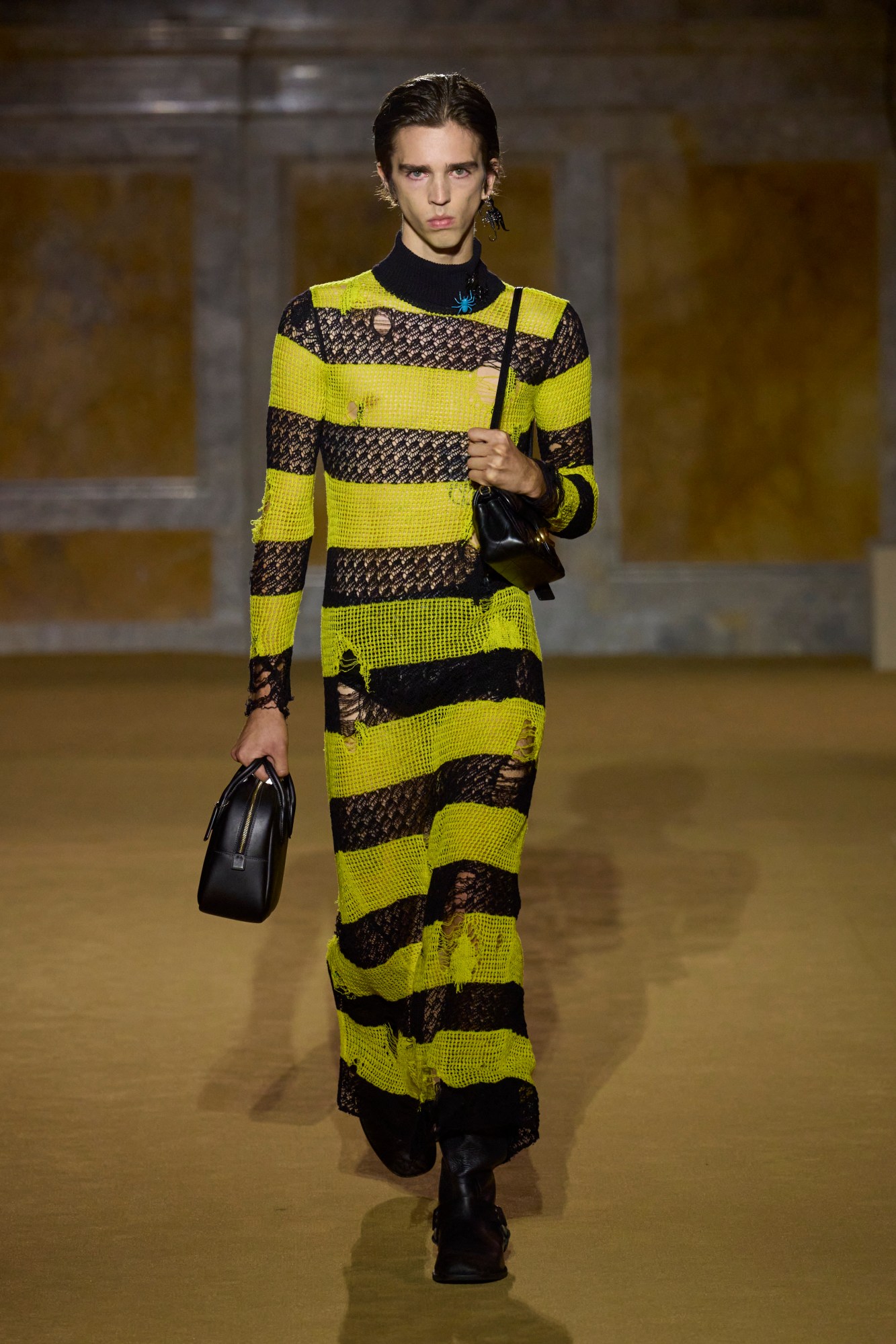
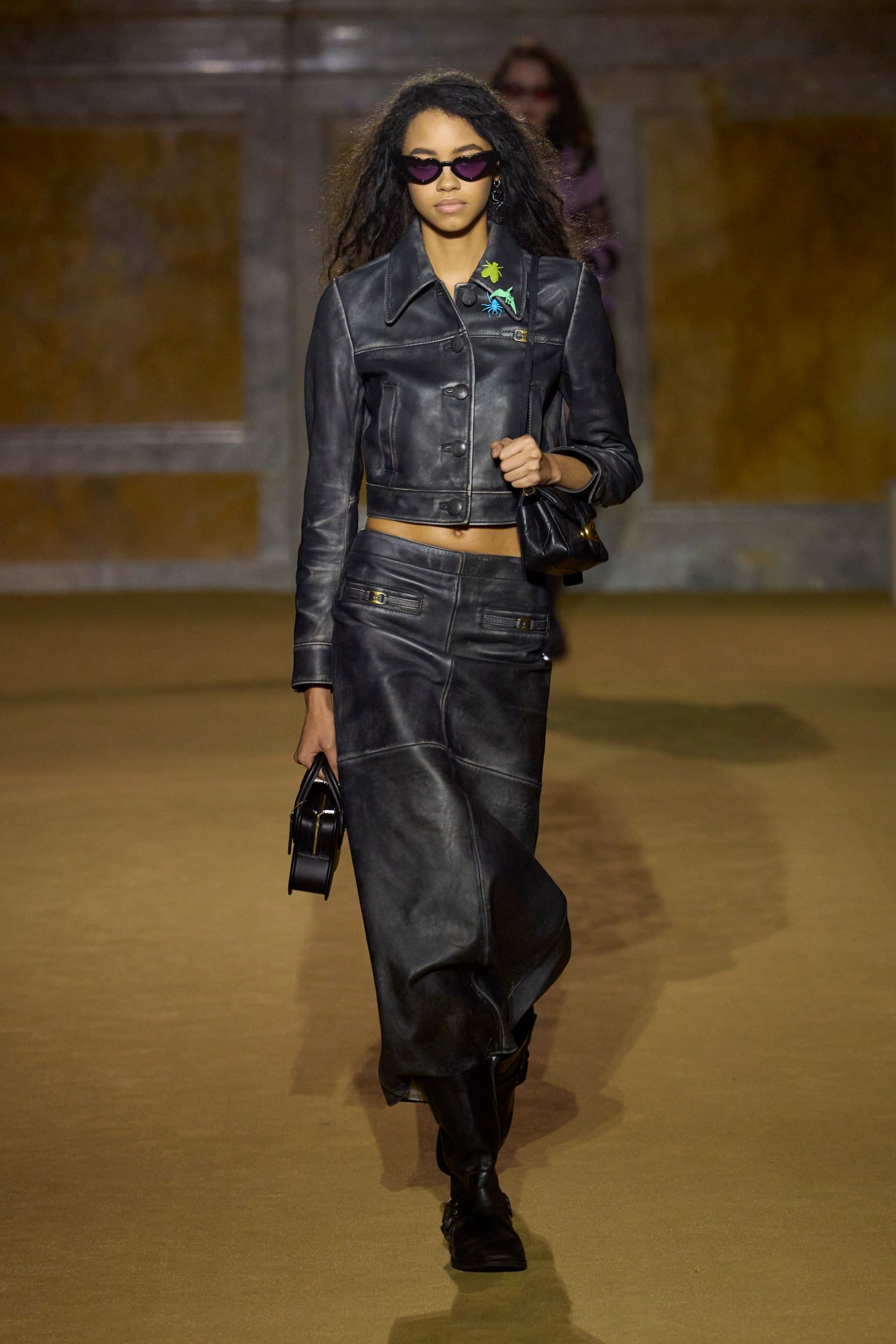


Coach
In fashion years, 10 years equates to… well, a very long time. As such, managing to not only hold down a position at the helm of a major house for that long, but also take that to bold new heights during that time, is a feat well worth celebrating. One day ahead of the official start of NYFW, Coach did just that, feting the decade-long tenure of Stuart Vevers in resplendent Beaux-Arts surrounds of the New York Public Library.
Understandably sentimental, the British creative director took this season as an opportunity to reflect on his experiences in the city he now calls home, summoning his earliest memories of visiting the city in the 90s as the collection’s keystone references. An attempt to distil “the archetypes of New York fashion,” the designer wrote in an accompanying self-penned note, memories of girls in slip dresses dancing at East Village queer, punk landmark, The Pyramid Club, translated to spaghetti-strapped iterations in buttery black, scarlet and lilac leather and lace-trimmed satin, and gossamer negligées worn over leather lingerie. Recollections of “cool young female execs” done with the fussiness of 80s power-dressing informed louchely-cut suiting, while the air of mid-90s grunge that has coloured Stuart’s recent Coach collections carried over here, too, making itself felt in distressed, bumblebee-banded knitted dresses and battered, bulky biker jackets with matching floor-swishing skirts.
Indeed, there was a lot of leather on show — a fact that the group of three PeTA protesters who crashed the runway drew attention to — but given that this is Coach, a brand who’s bread and butter is the sale of its leather accessories — it’s arguably the main motivation for staging shows like this. This season, Stuart decided not to revisit the archive when designing this season’s handbags, instead asking himself: “What would a Coach bag be?” Given the scale of the brand’s accessories offering, answers to that question were expectedly diverse, spanning sensible black and brown bucket totes, quilted flap bags in a pastel rainbow of hues, and whimsical colour-blocked top-handles in the shapes of hearts, bow-ties and rubber duckies. Musts for any 10th birthday party! MS
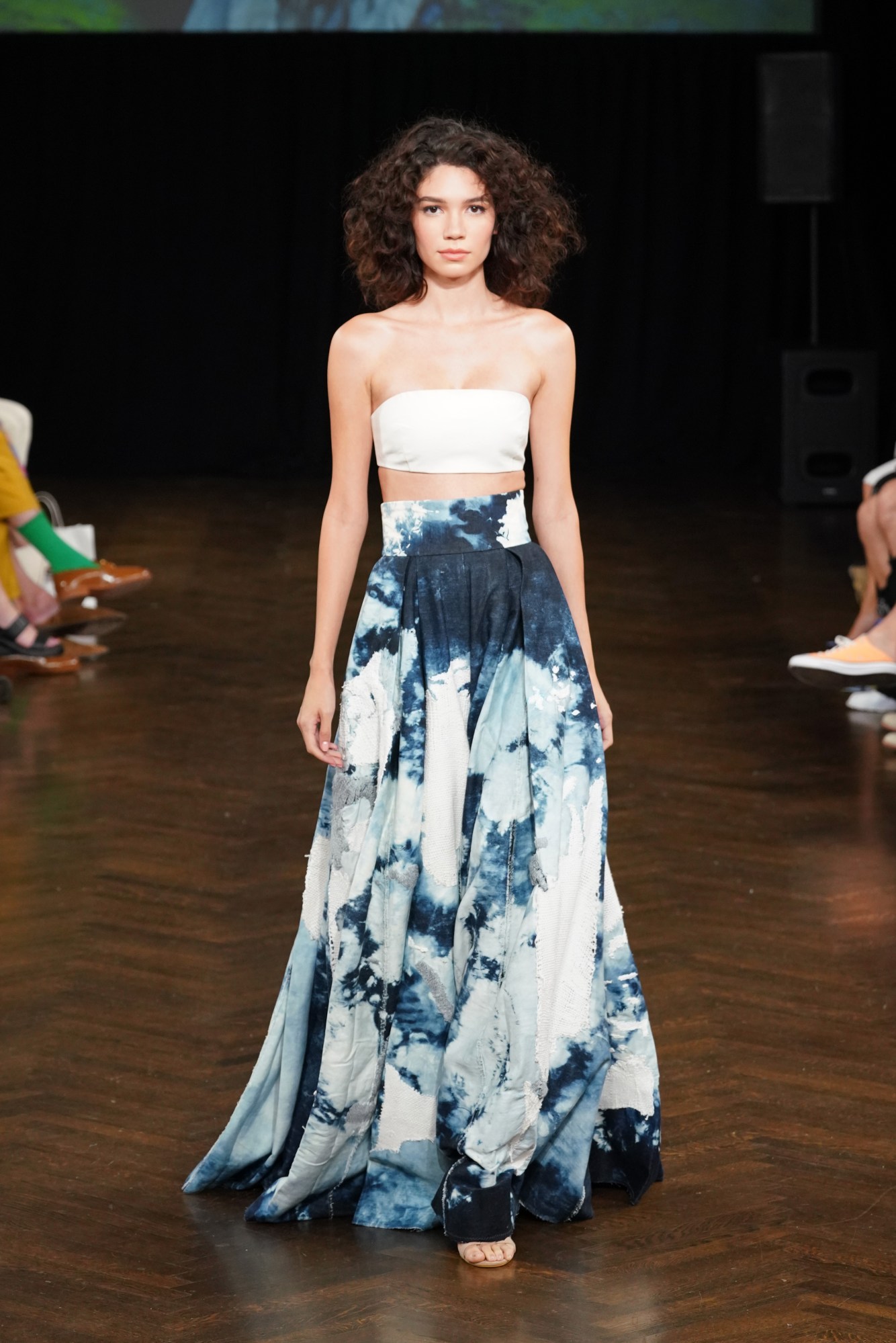
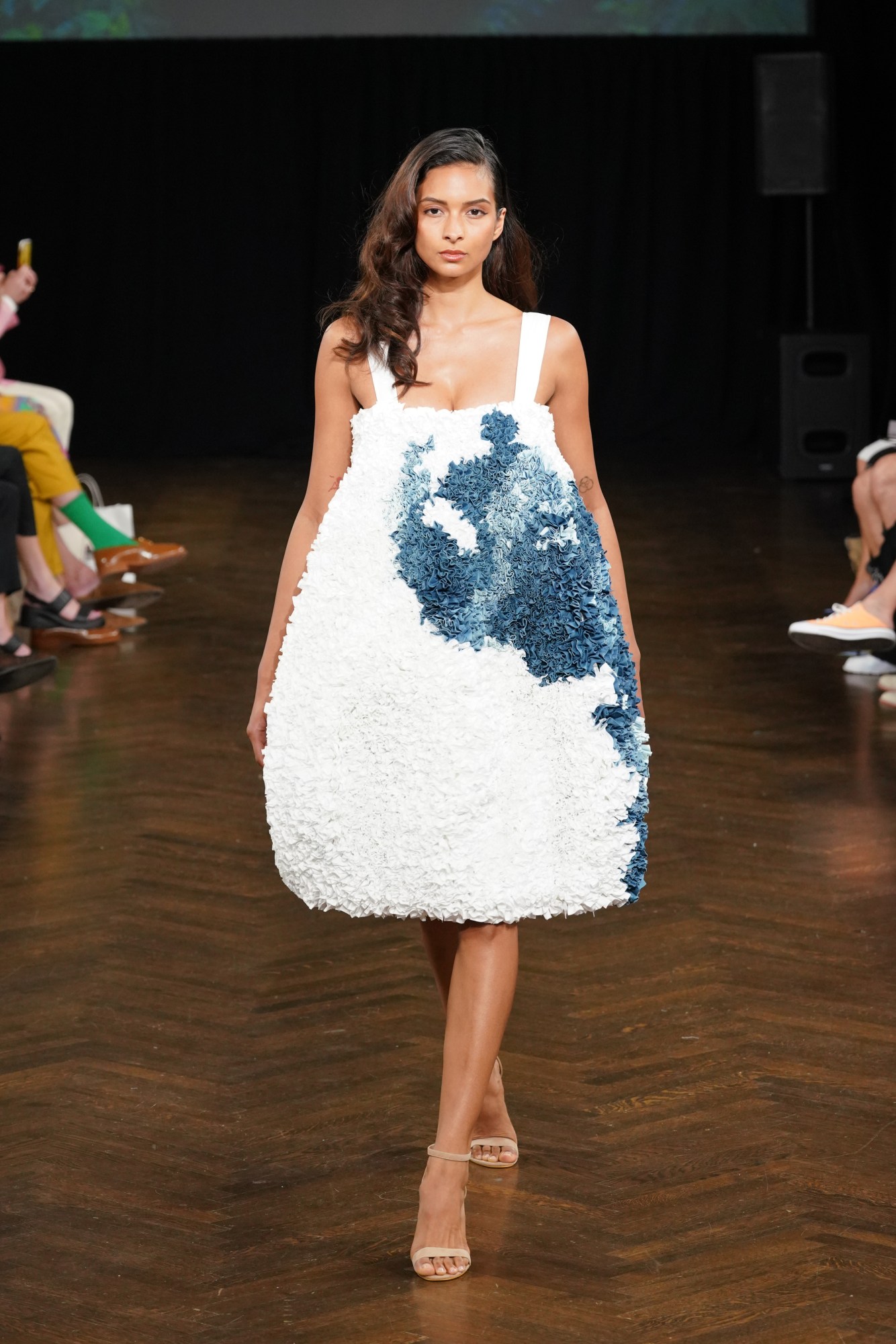


Supima Design Competition
For 16 years now, Supima, the luxury brand promoting the use of American-grown Pima cotton, has staged an annual competition aimed at celebrating and platforming the brightest talents from its network of American design schools — which counts Parsons, FIT, Savannah College of Art and Design and San Francisco’s Academy of Arts University among them. Each year, a finalist from each of Supima’s eight partner schools is given free access to blank rolls of five of the brand’s superior cotton fabrics — velveteen, denim, jersey, poplin and twill — and asked to design a capsule collection to present before a panel of esteemed industry experts, chaired by Jeremy Scott, during New York Fashion Week, with the designer of the collection deemed the most accomplished taking home a $10,000 cash prize.
This year, the gong was awarded to Carla Pierini, a graduate of Philadelphia’s Drexel University. Presenting a five-look ode to her Venezuelan homeland, and her experience as a migrant in America, Carla won over judges not only for the poignancy of the collection’s narrative, but also for the calibre of craftsmanship it exhibited. Between a tie-dyed, Delft blue maxi skirt, a hand-woven, decadently fringed shift dress and a cocoon gown confected in tightly packed blossom-liked clusters of cotton, it was a body of work that instantly made Carla a name well worth keeping an eye out for in years to come. MS
